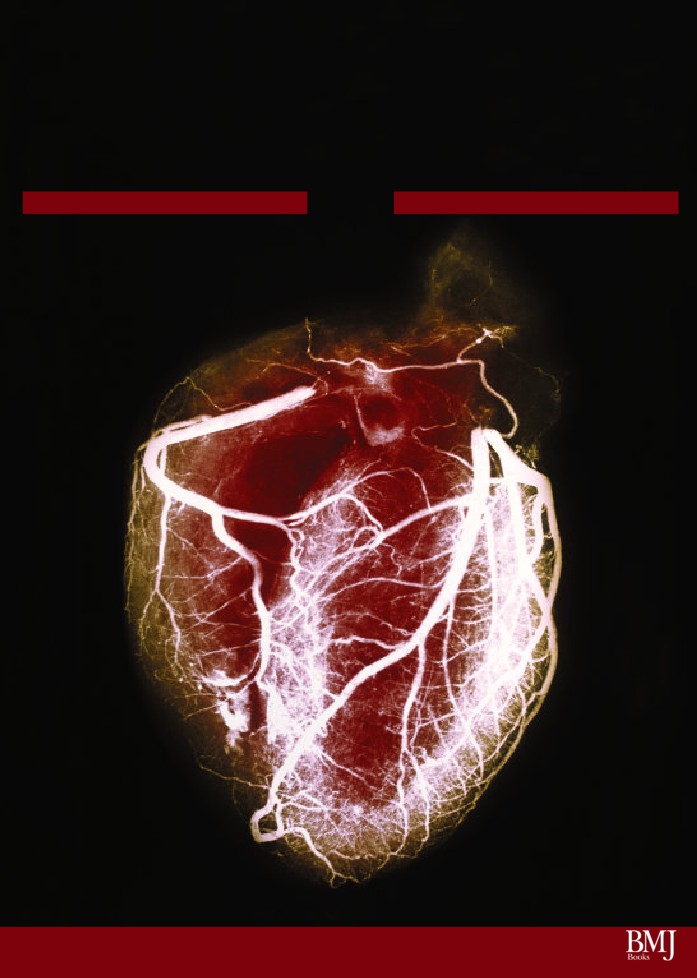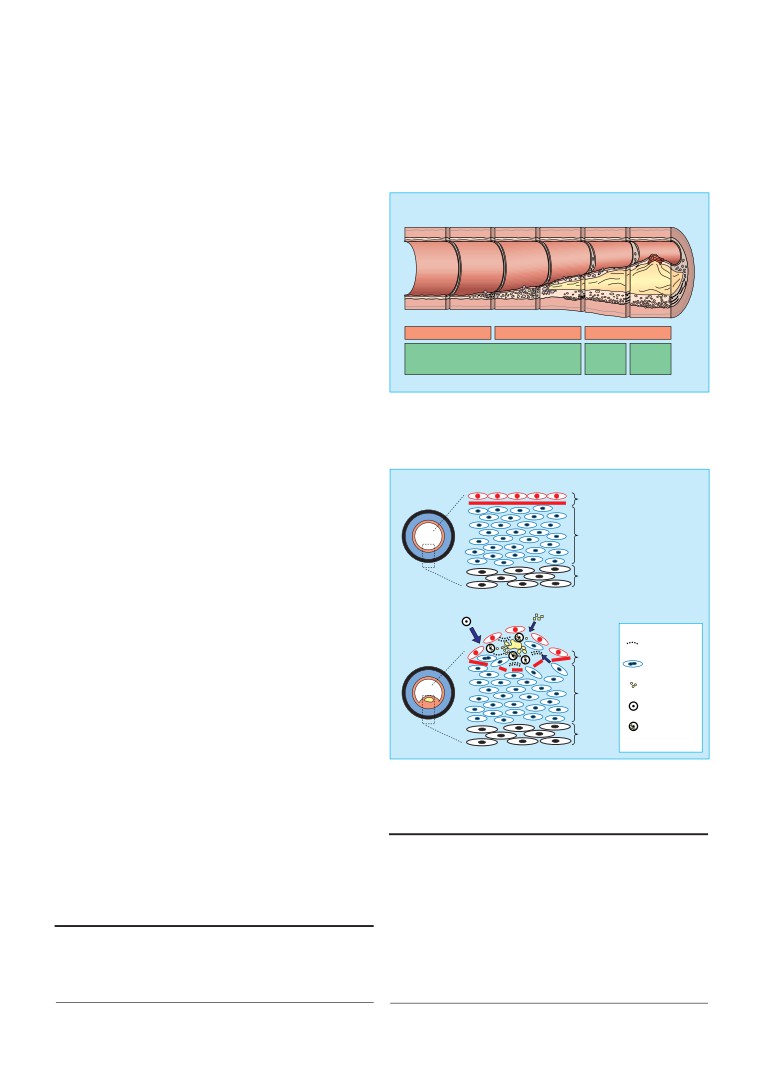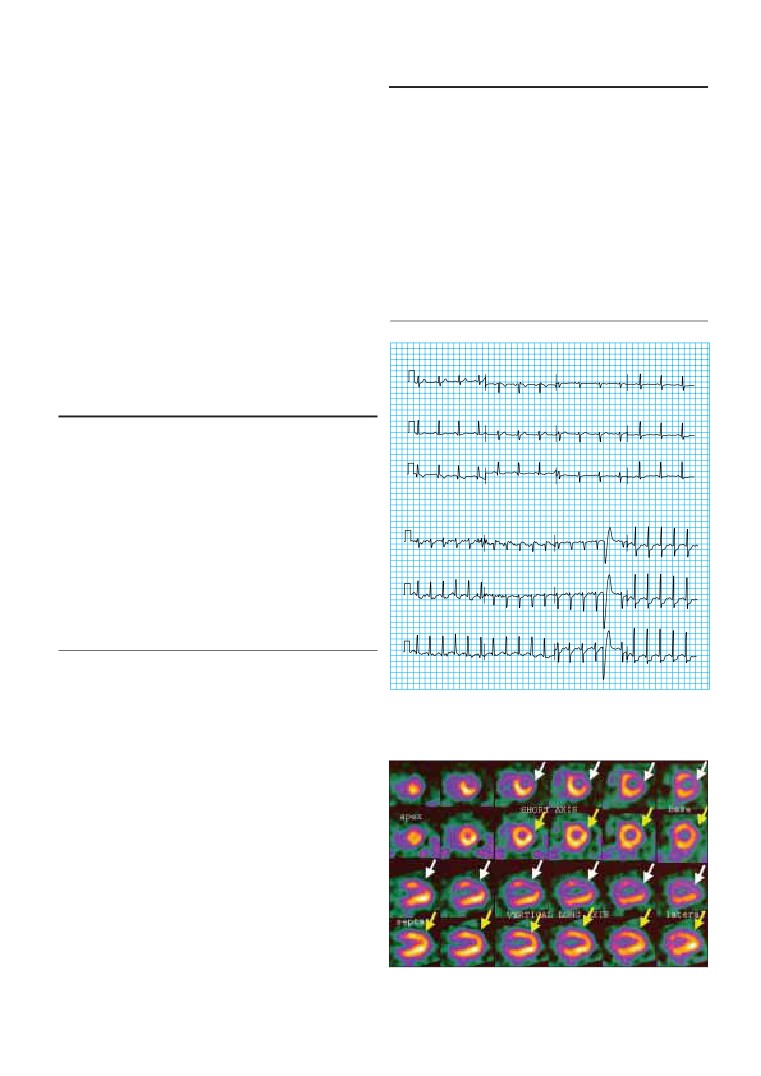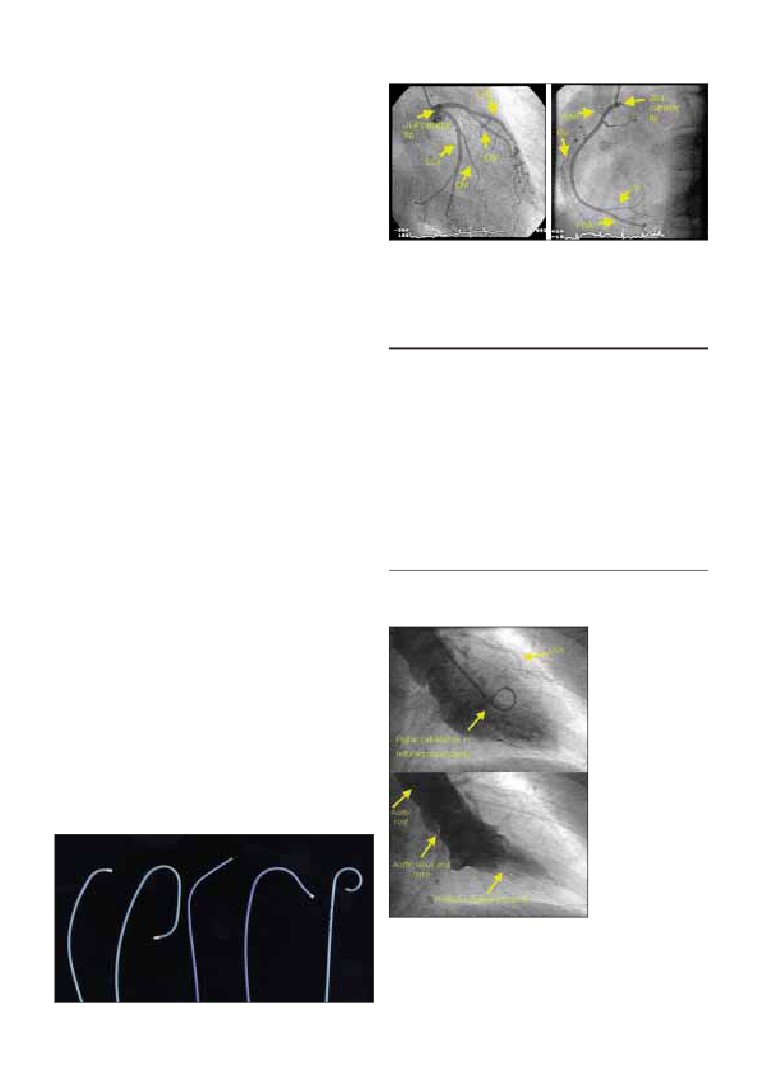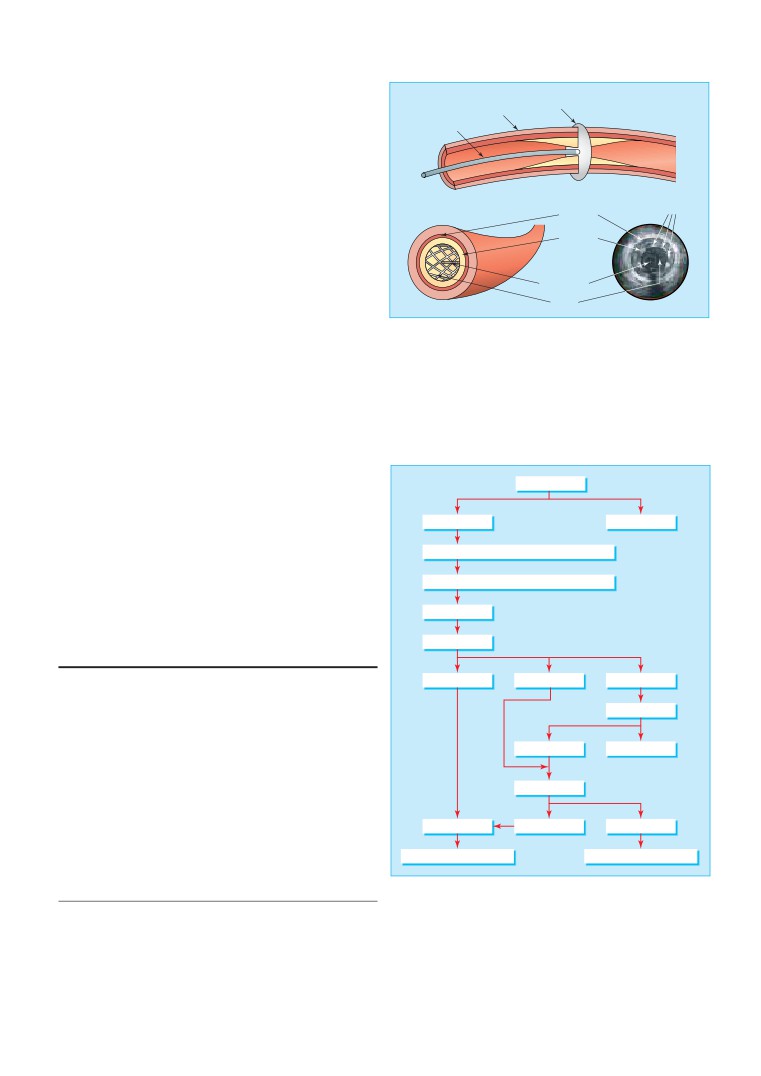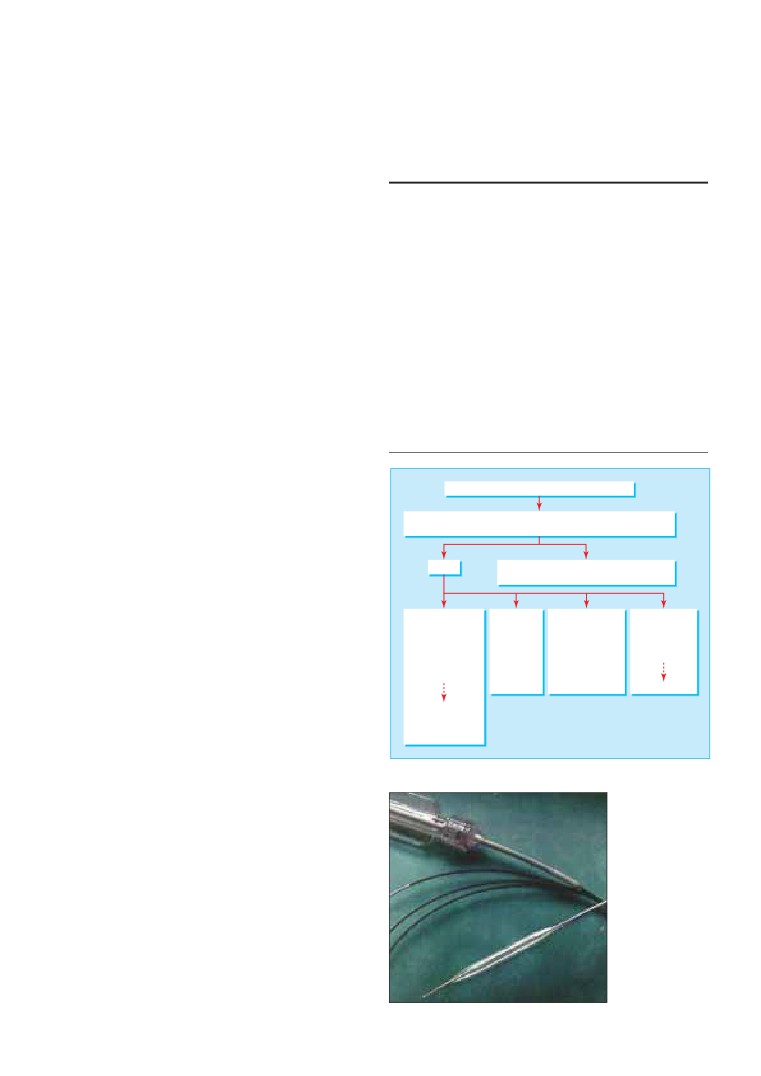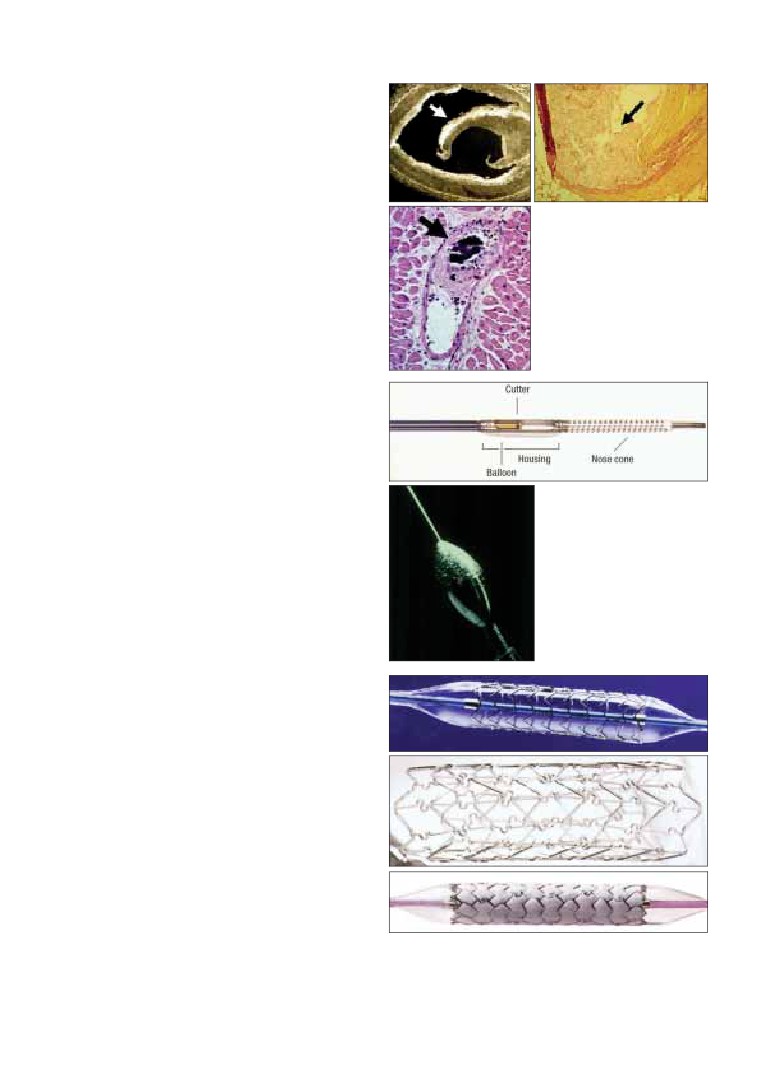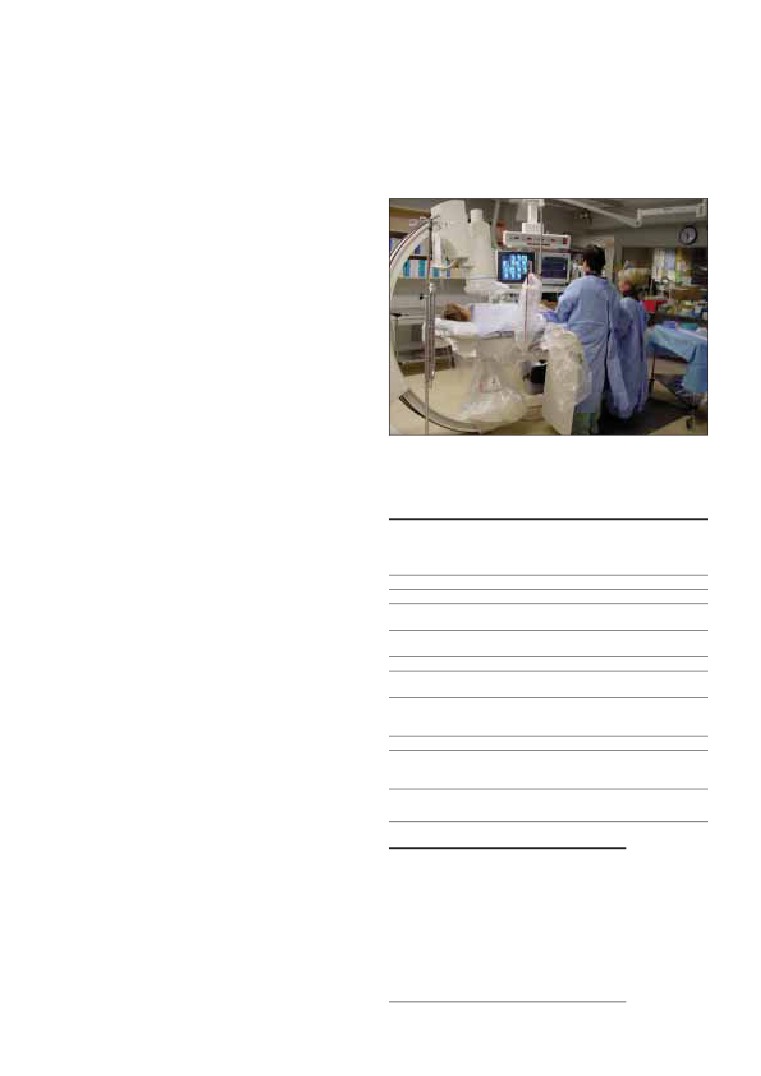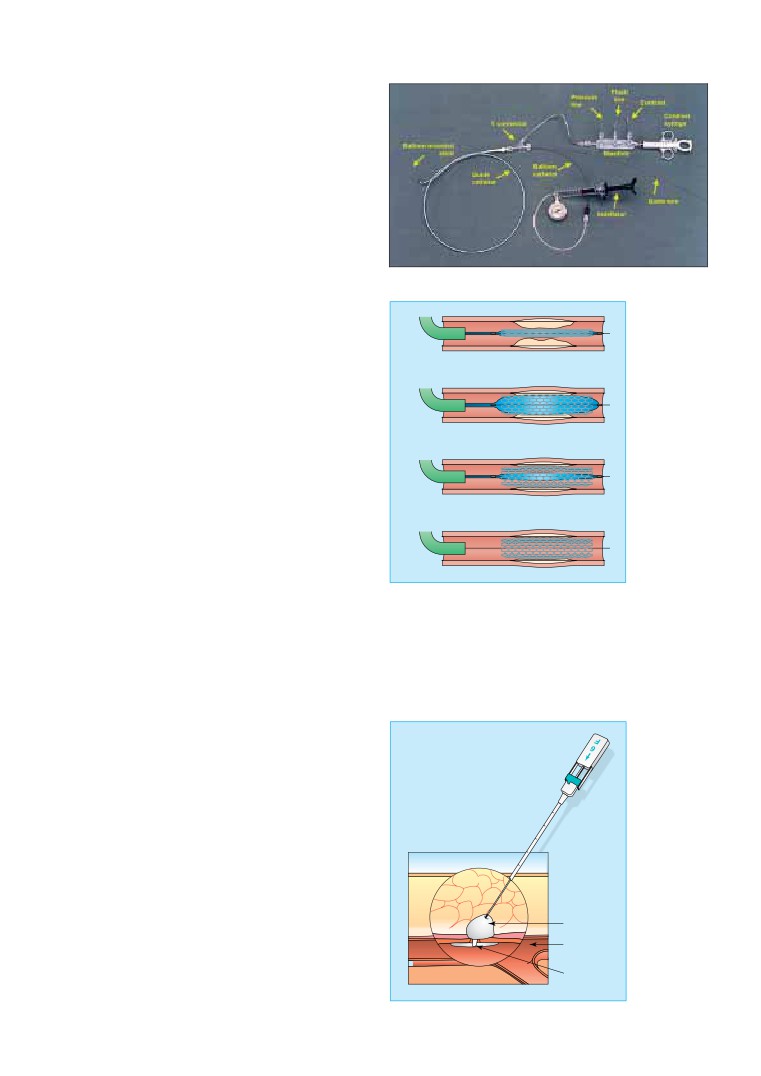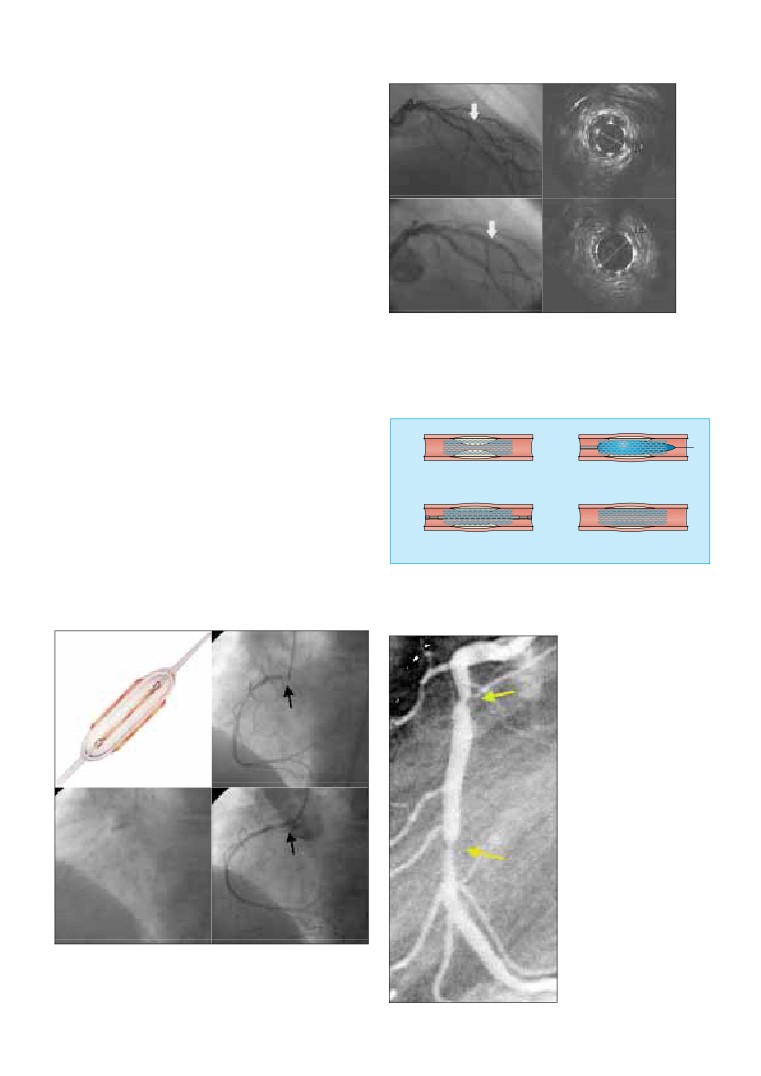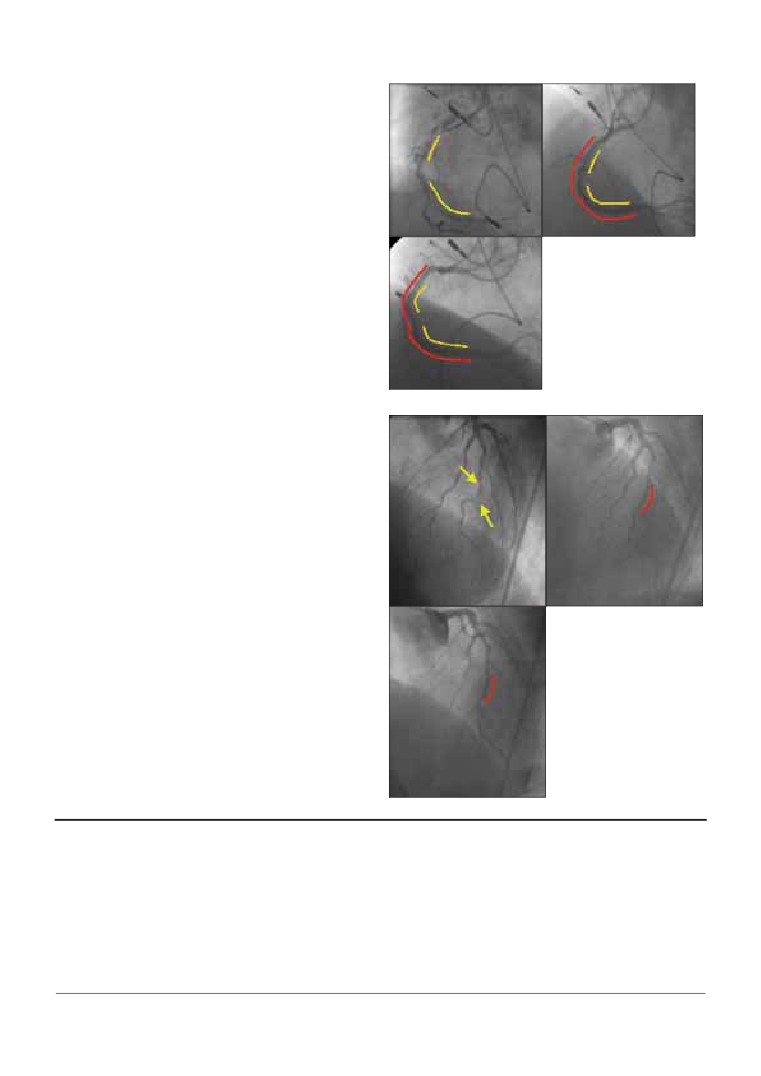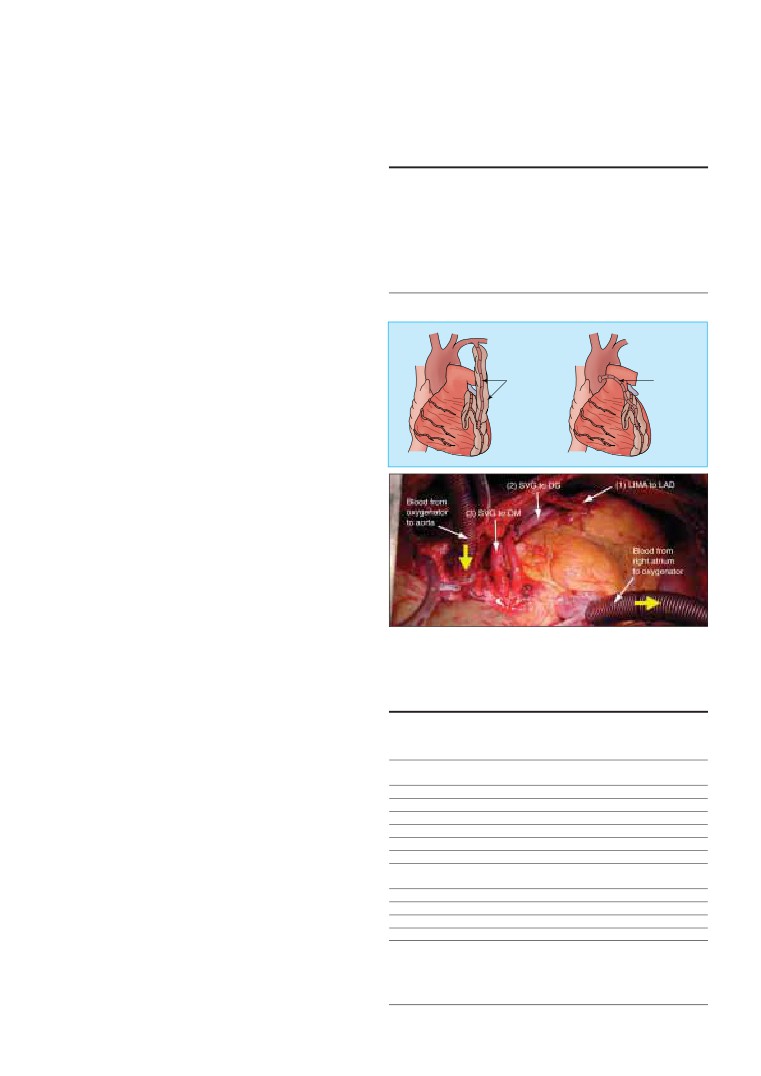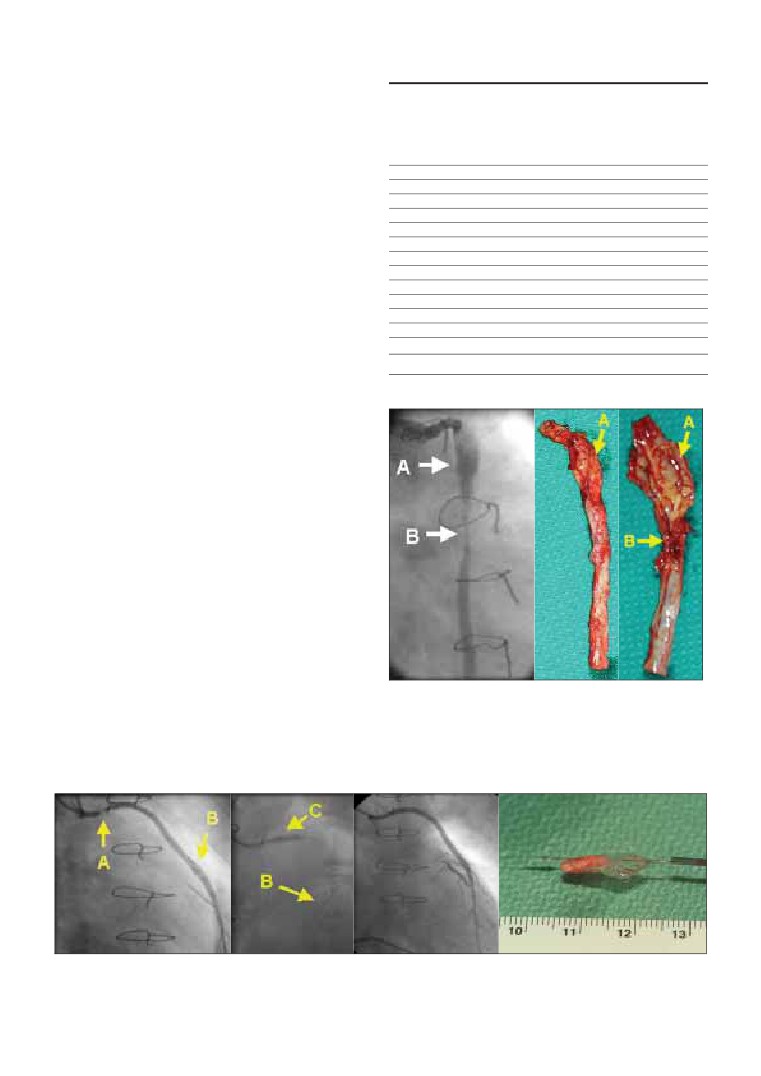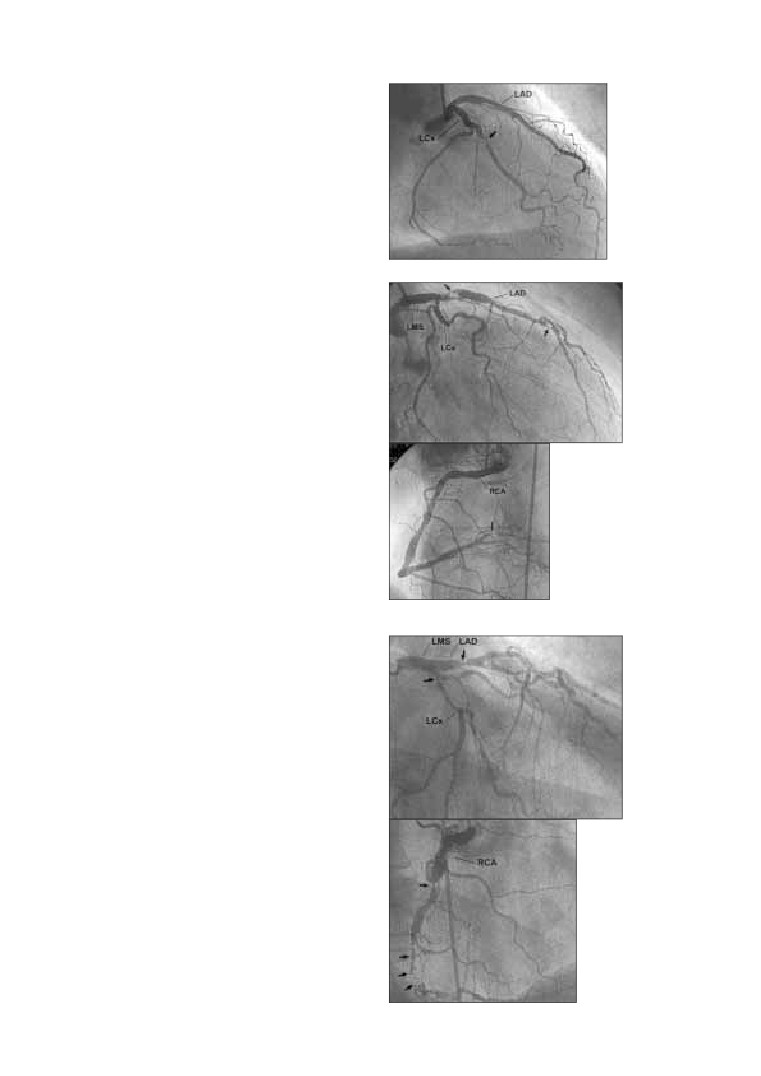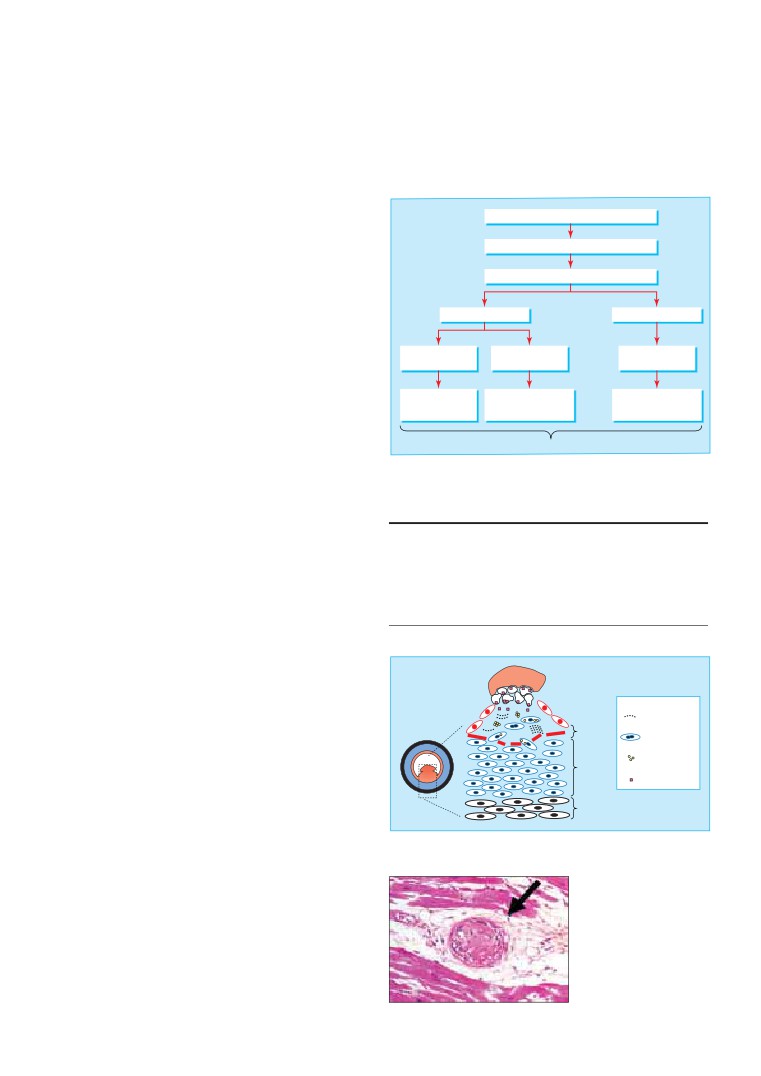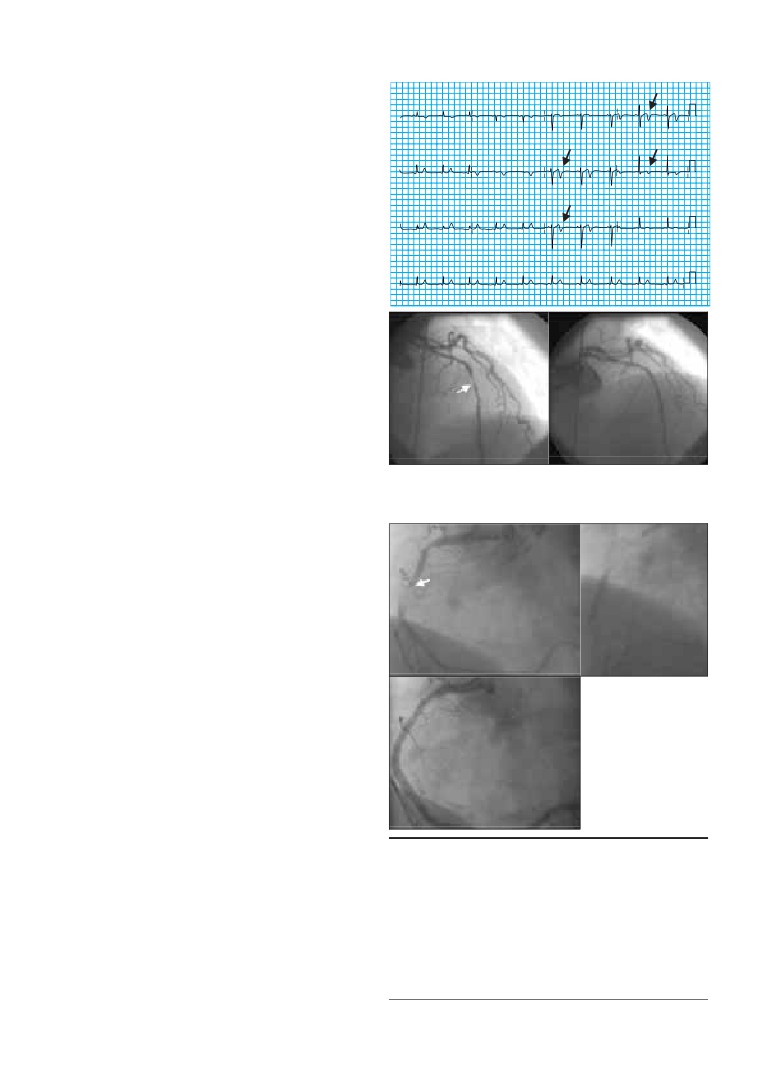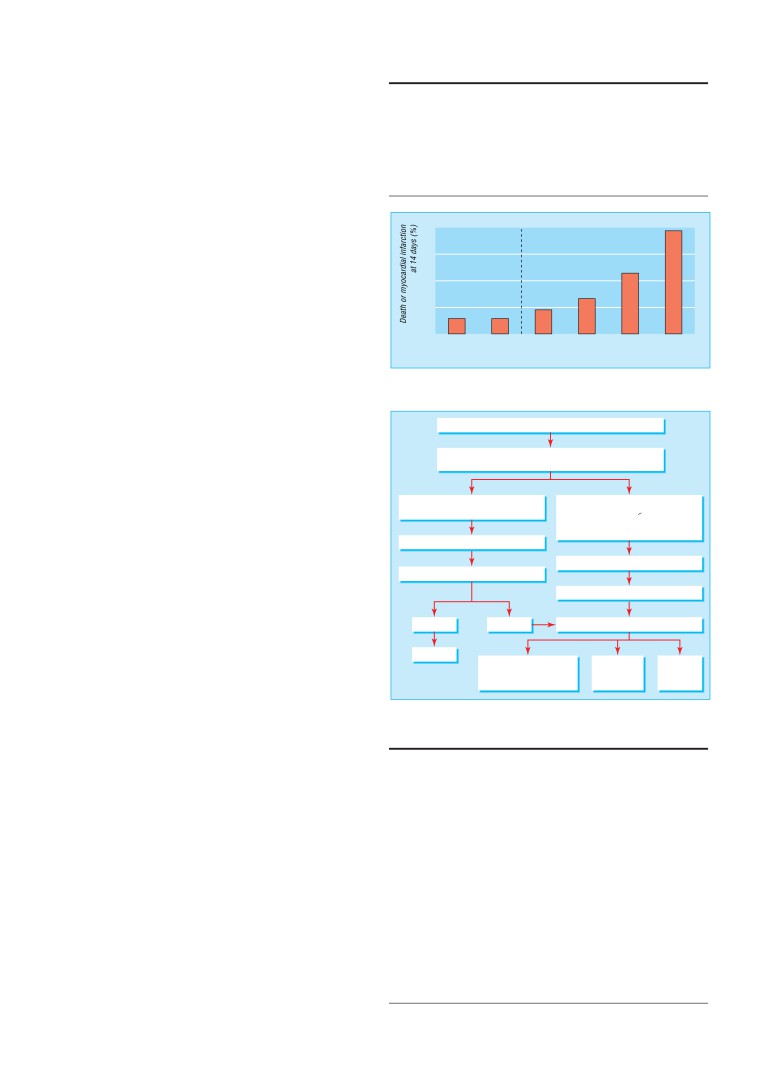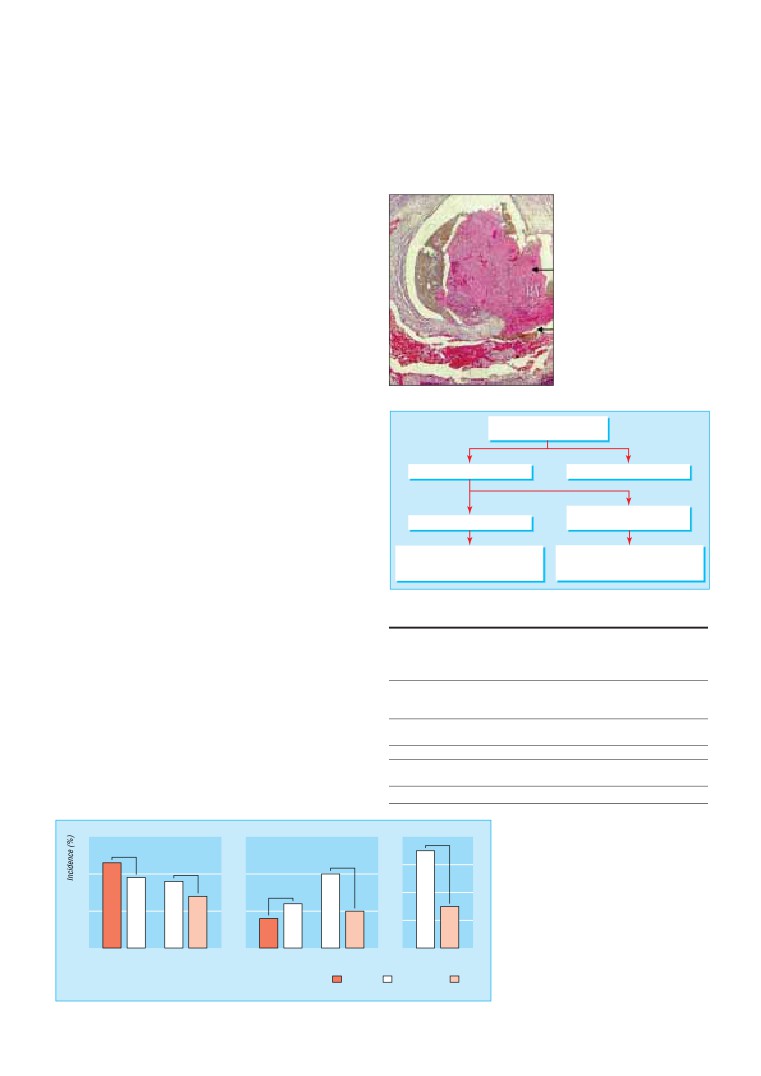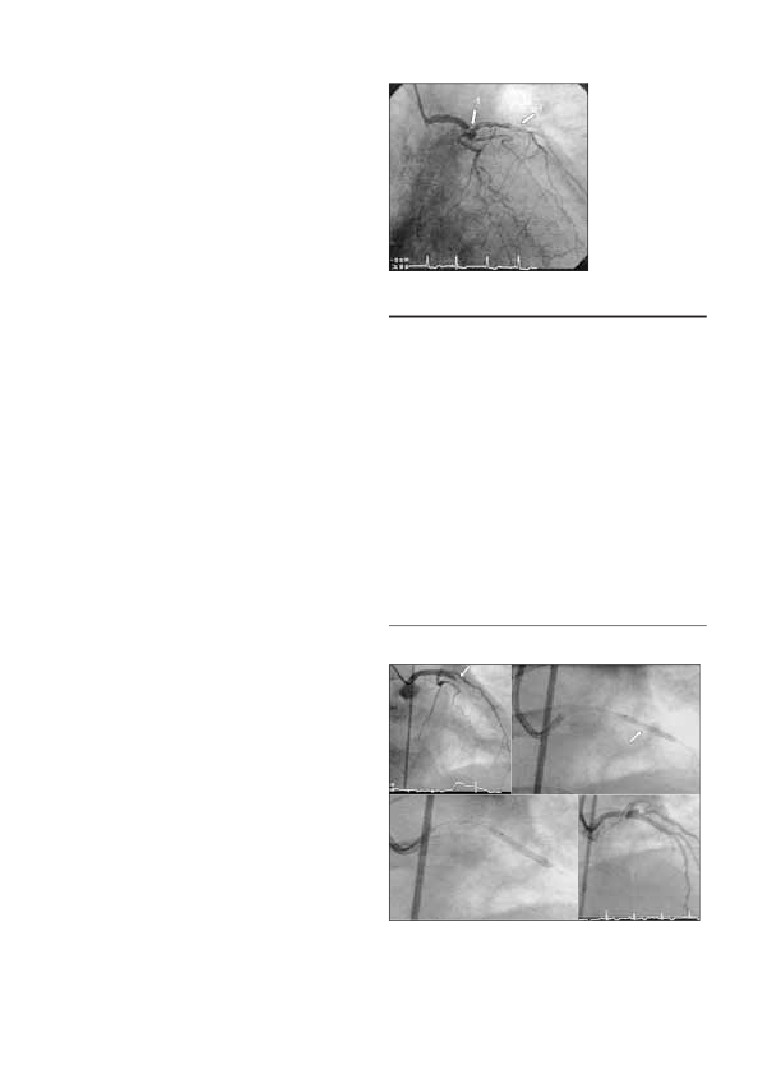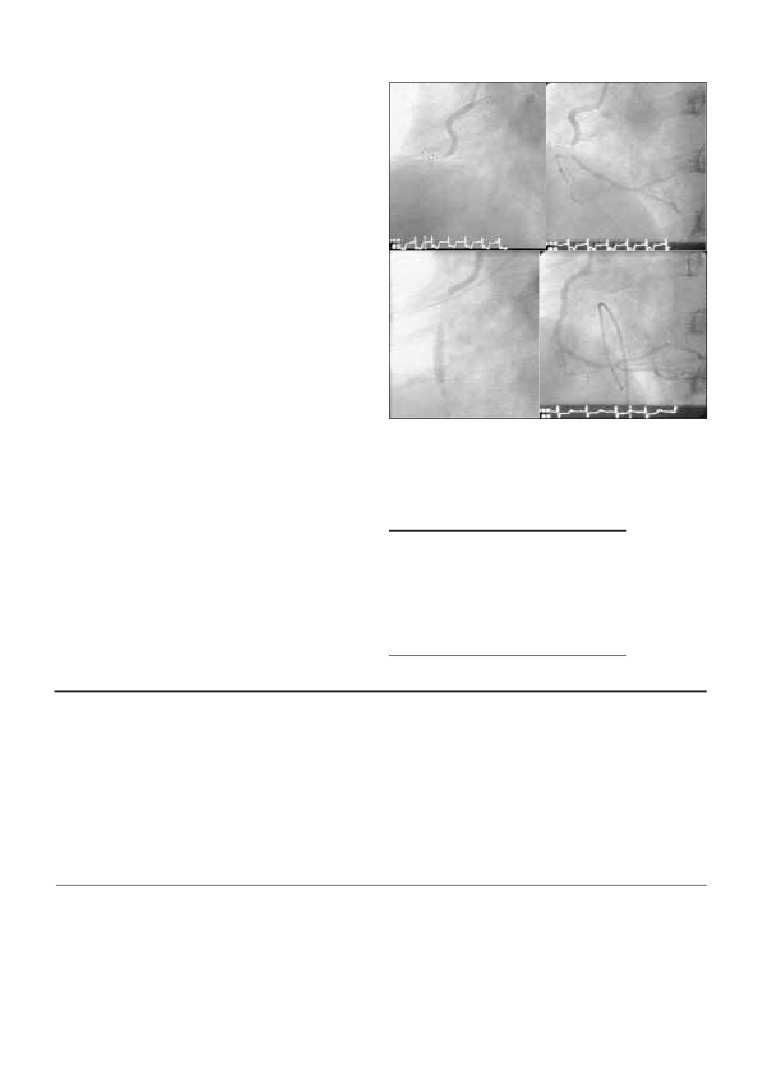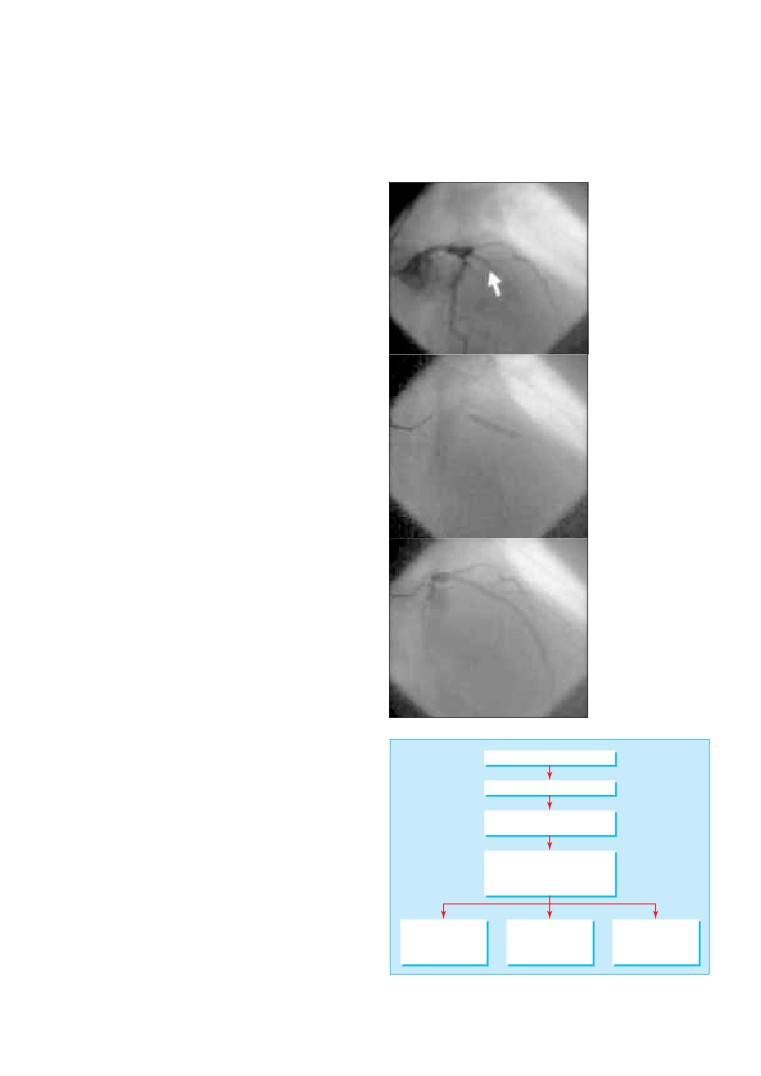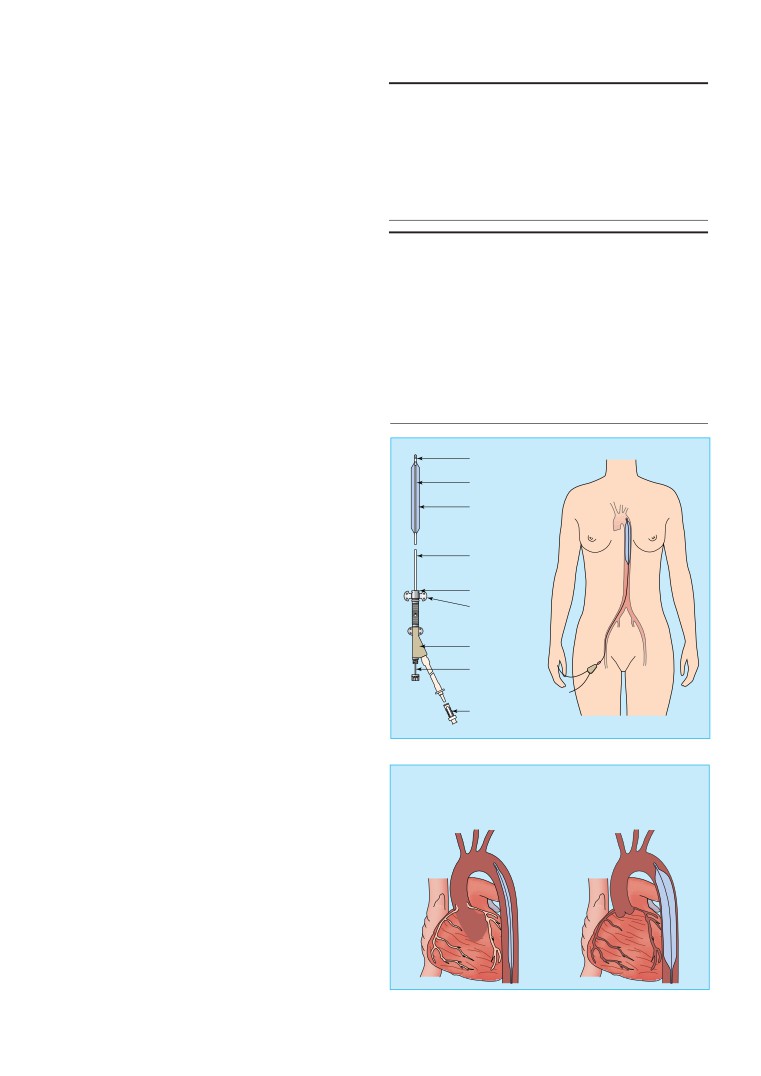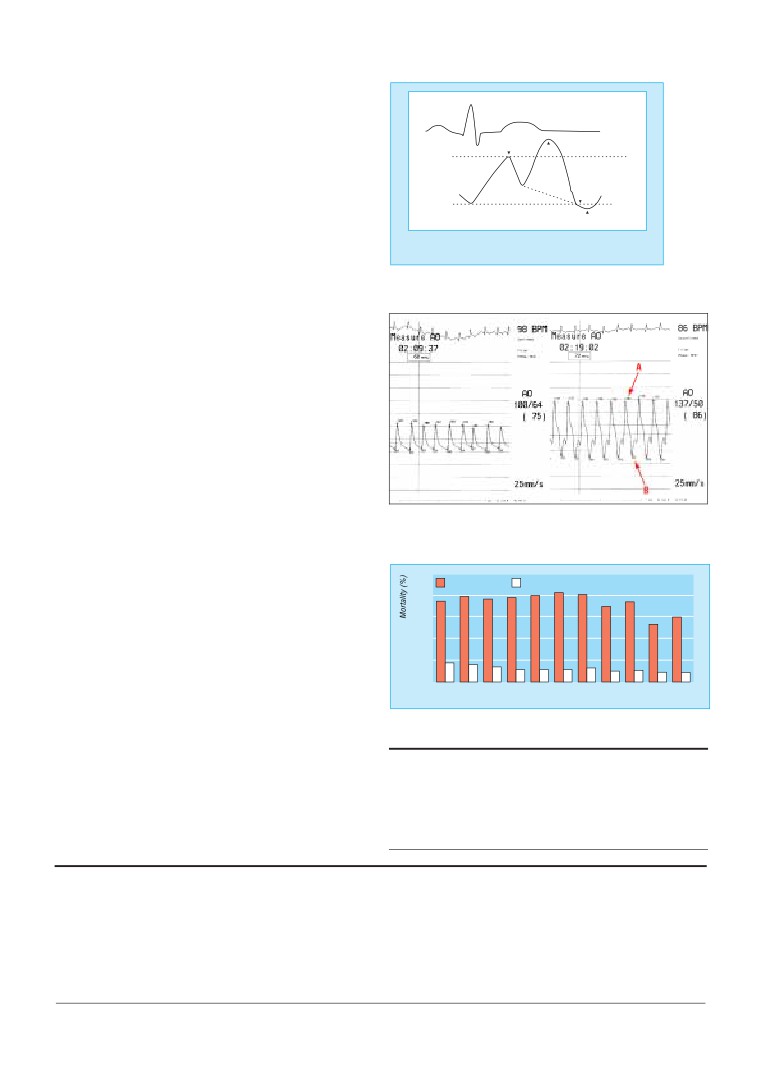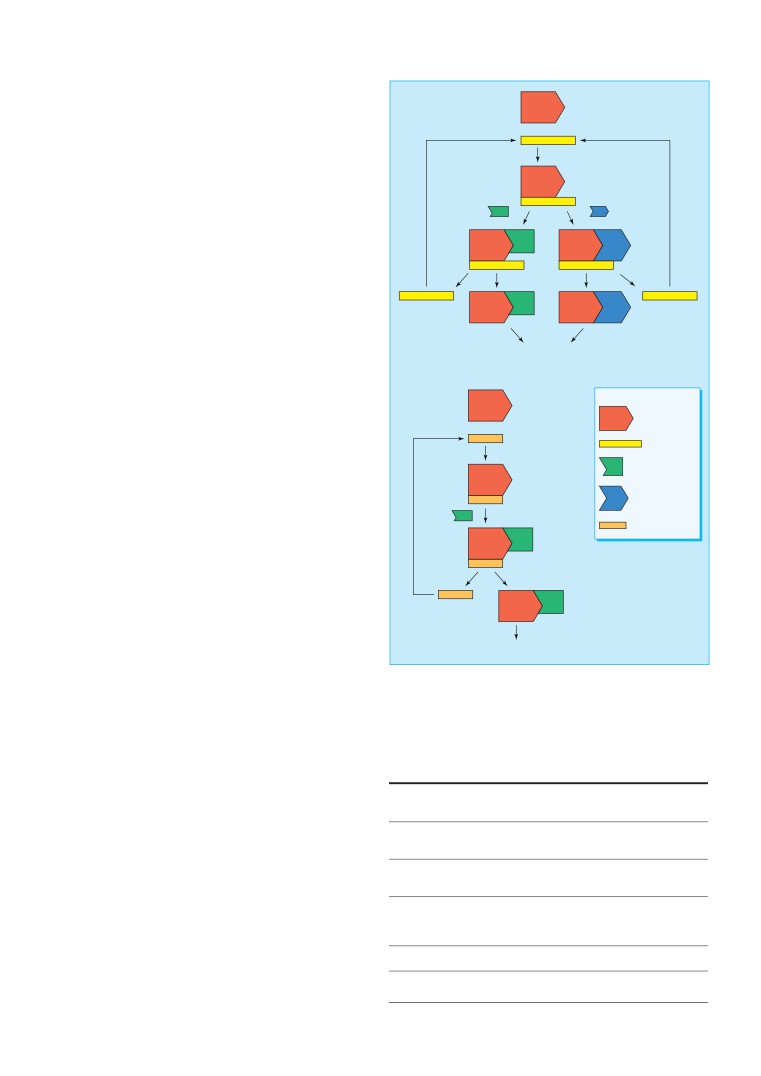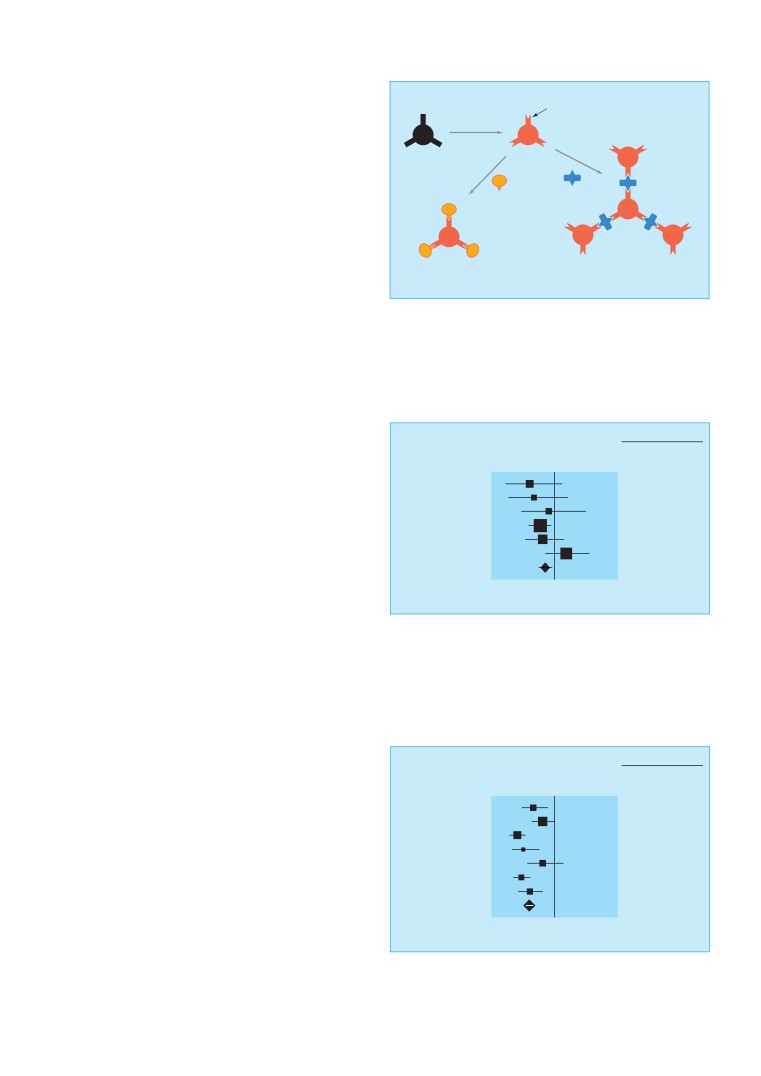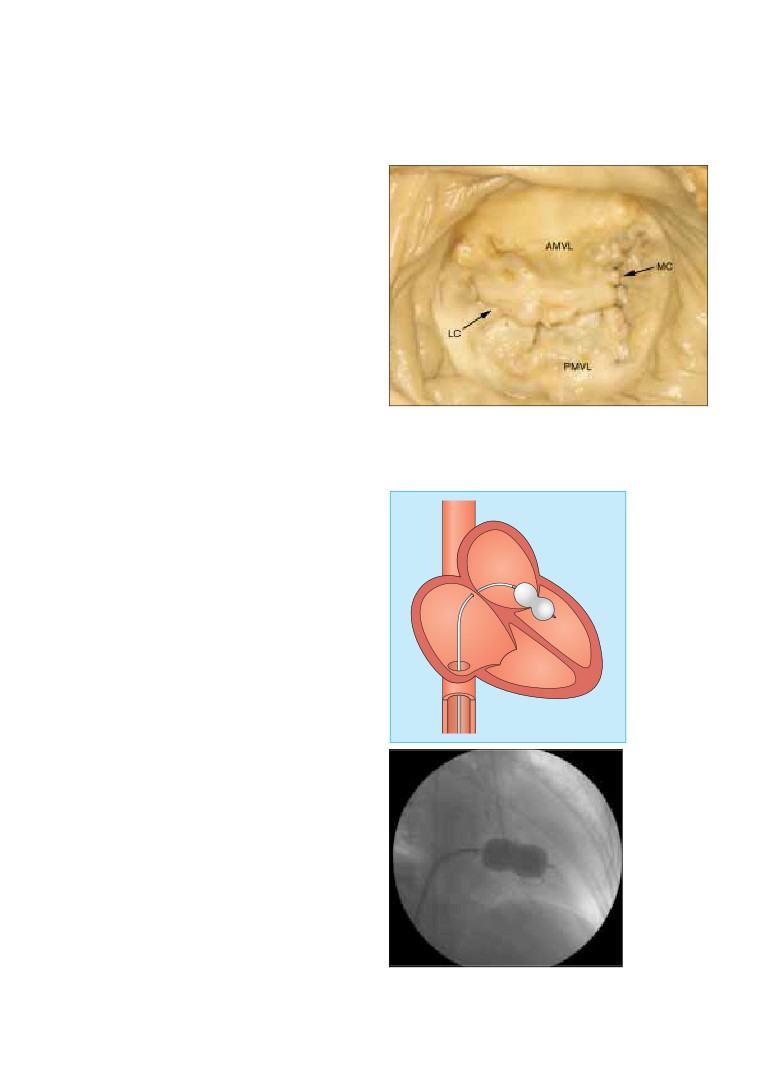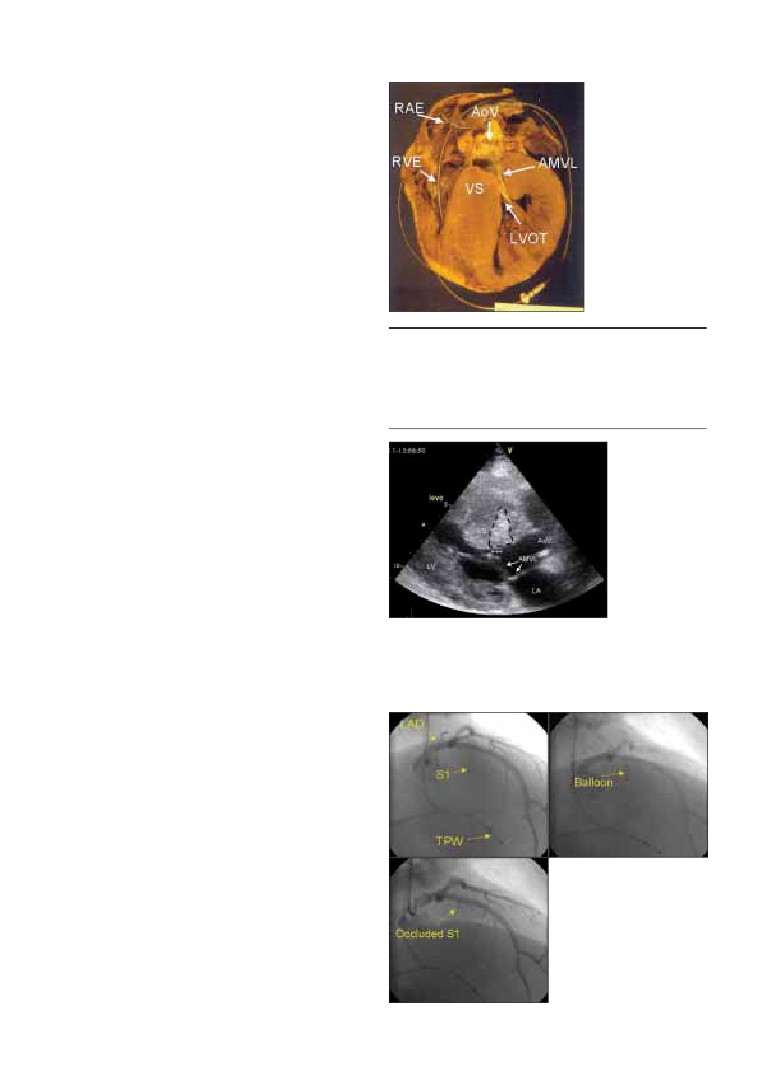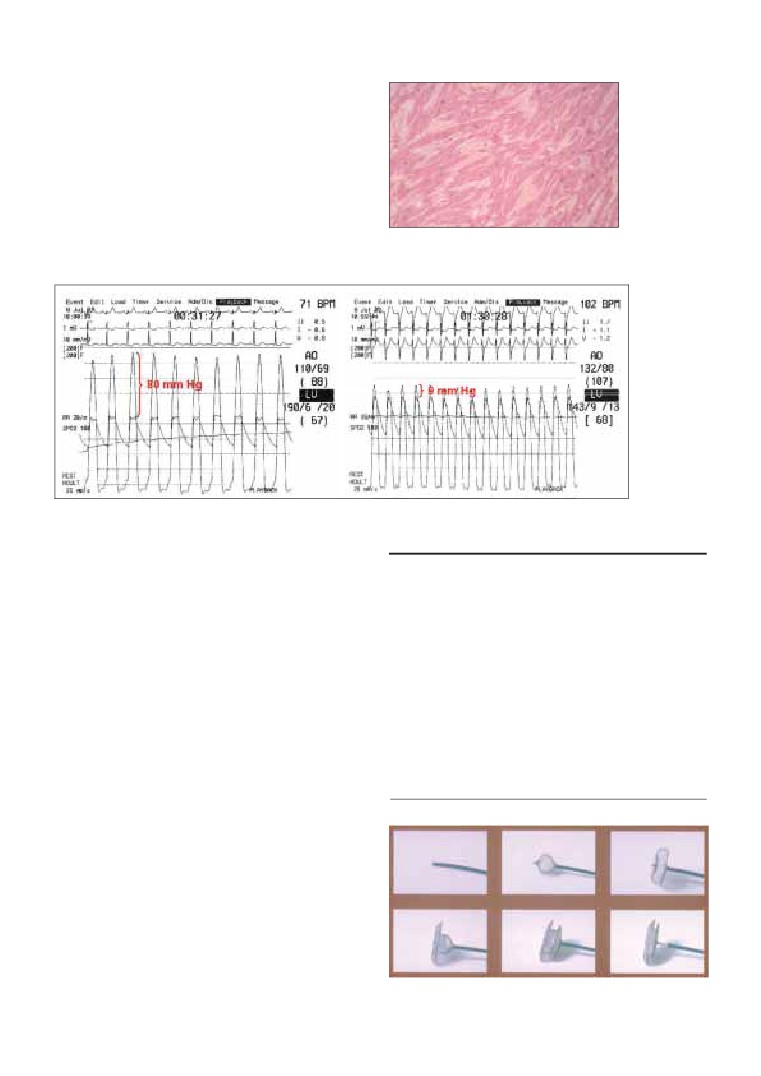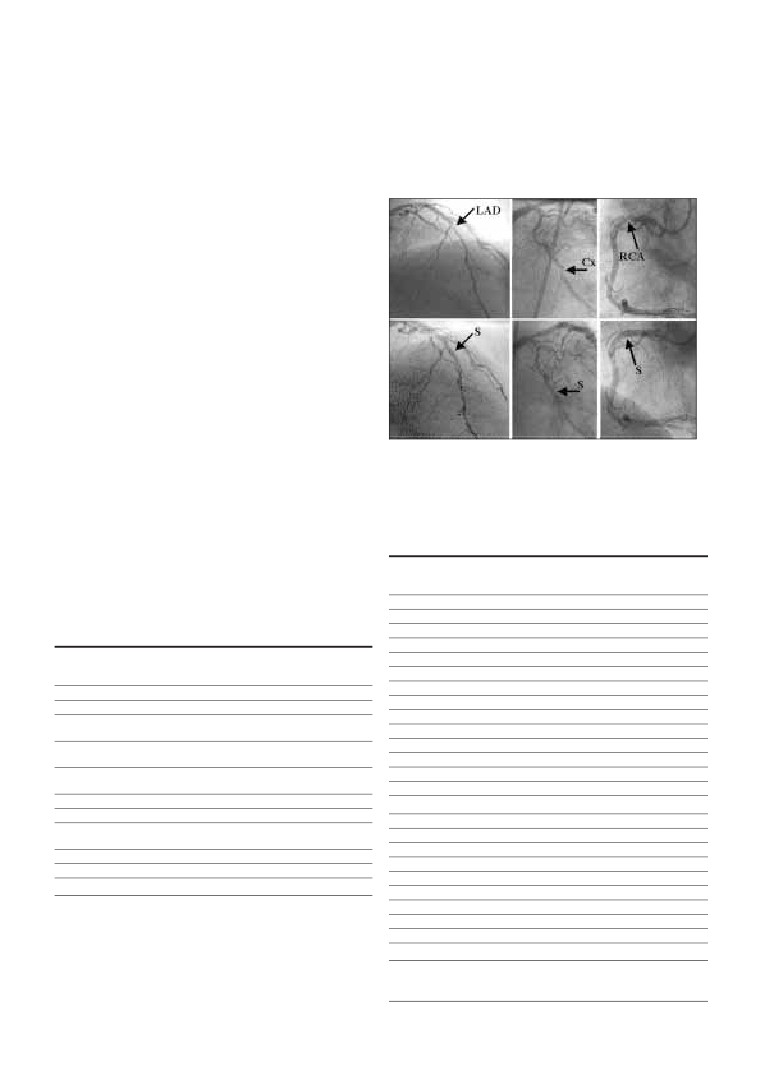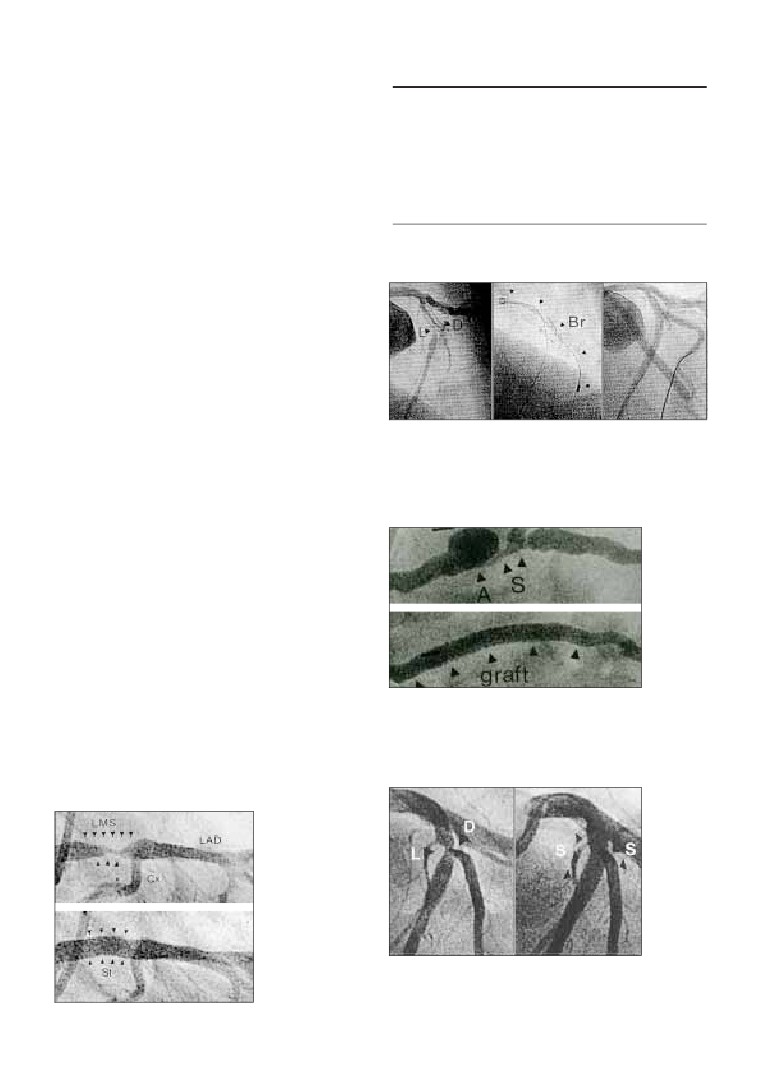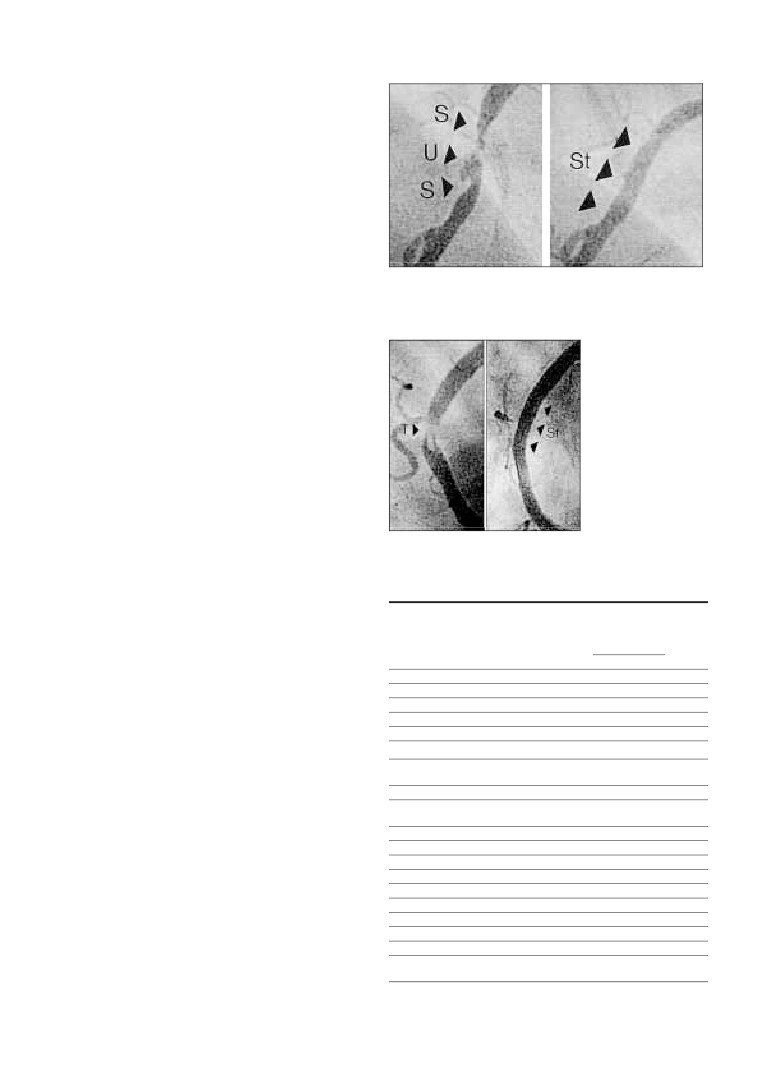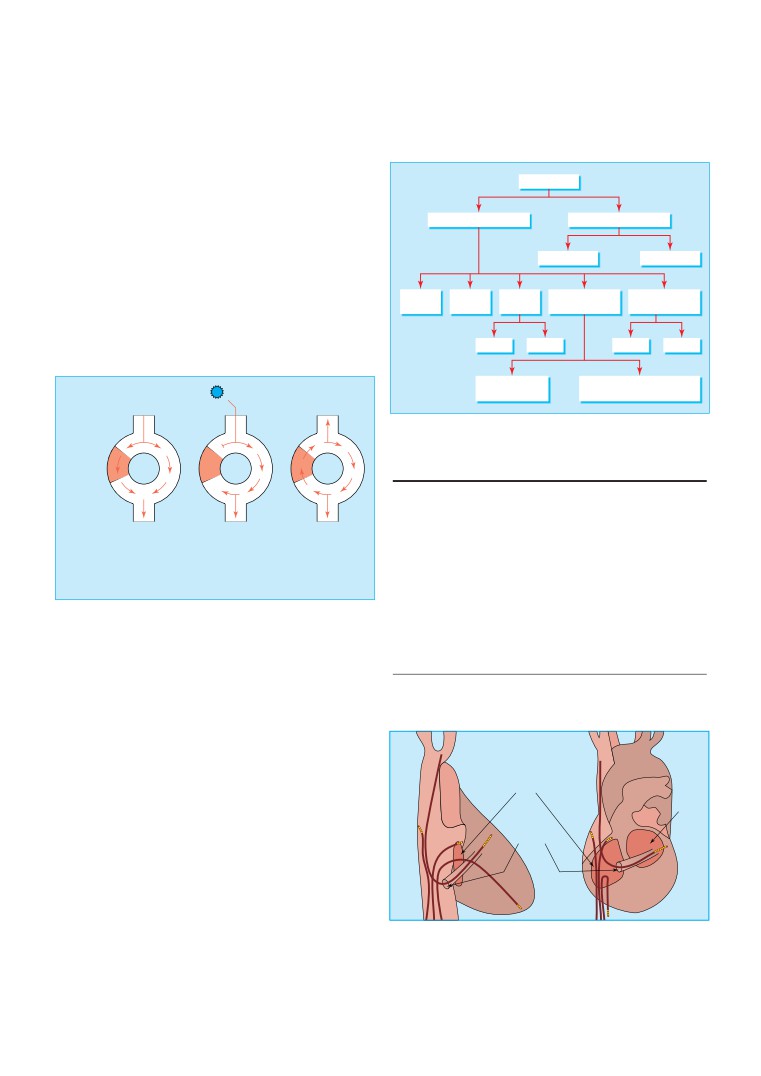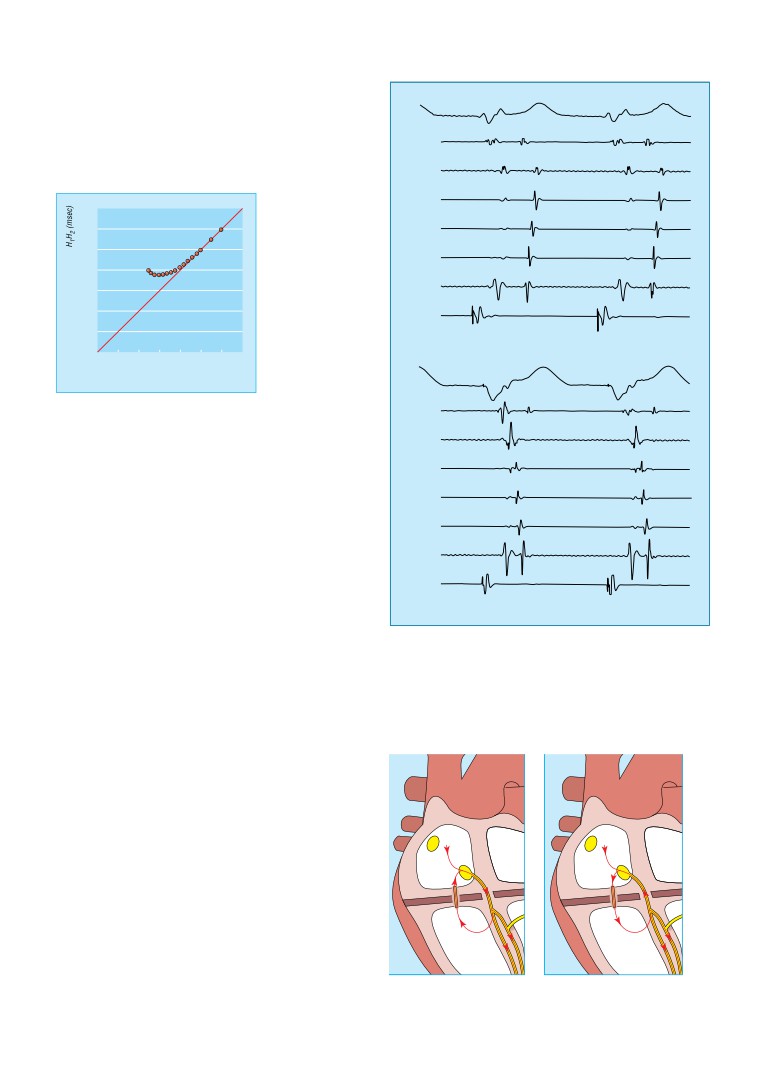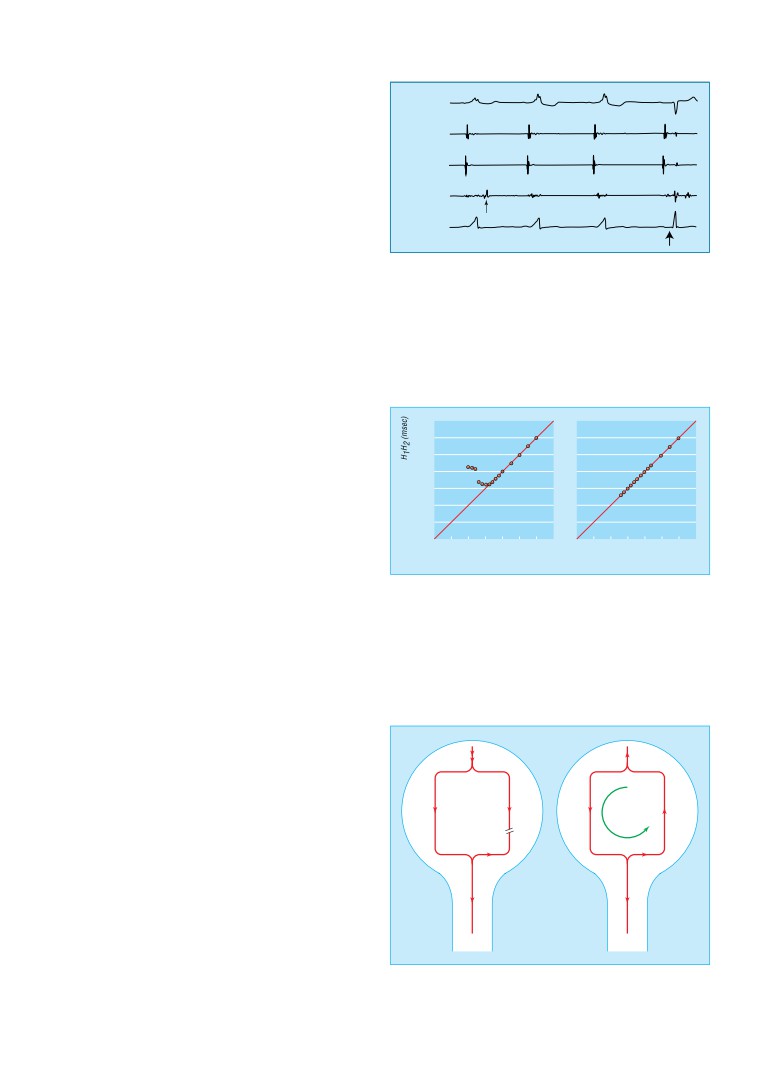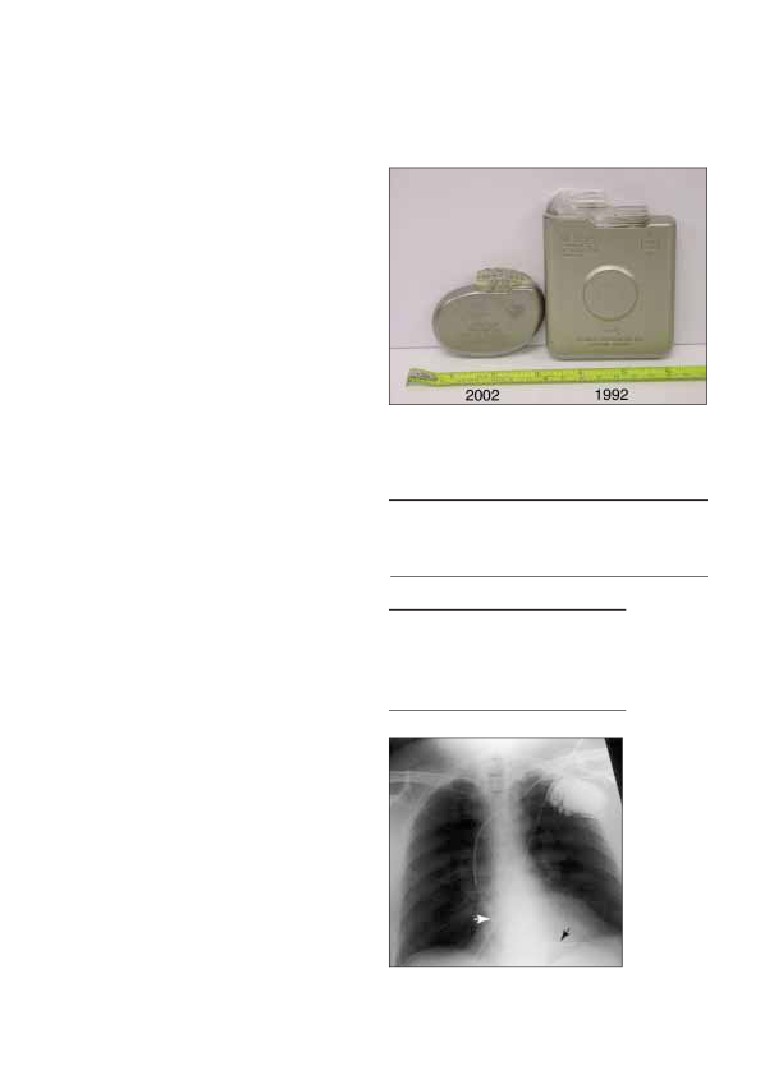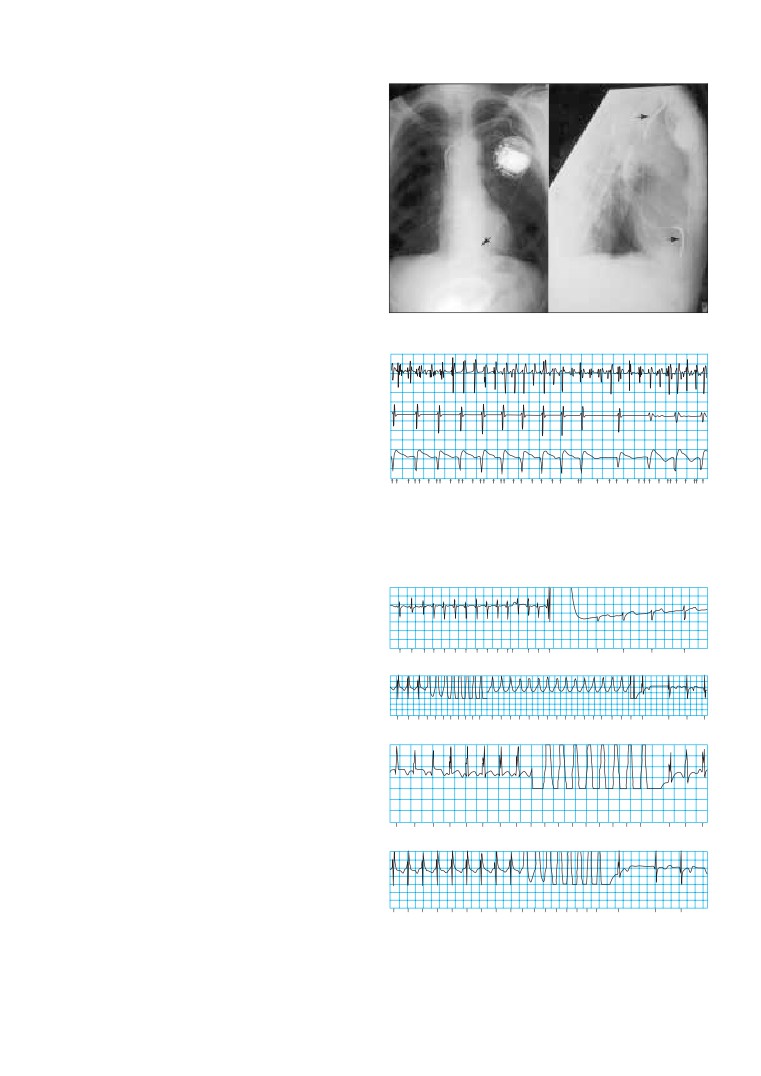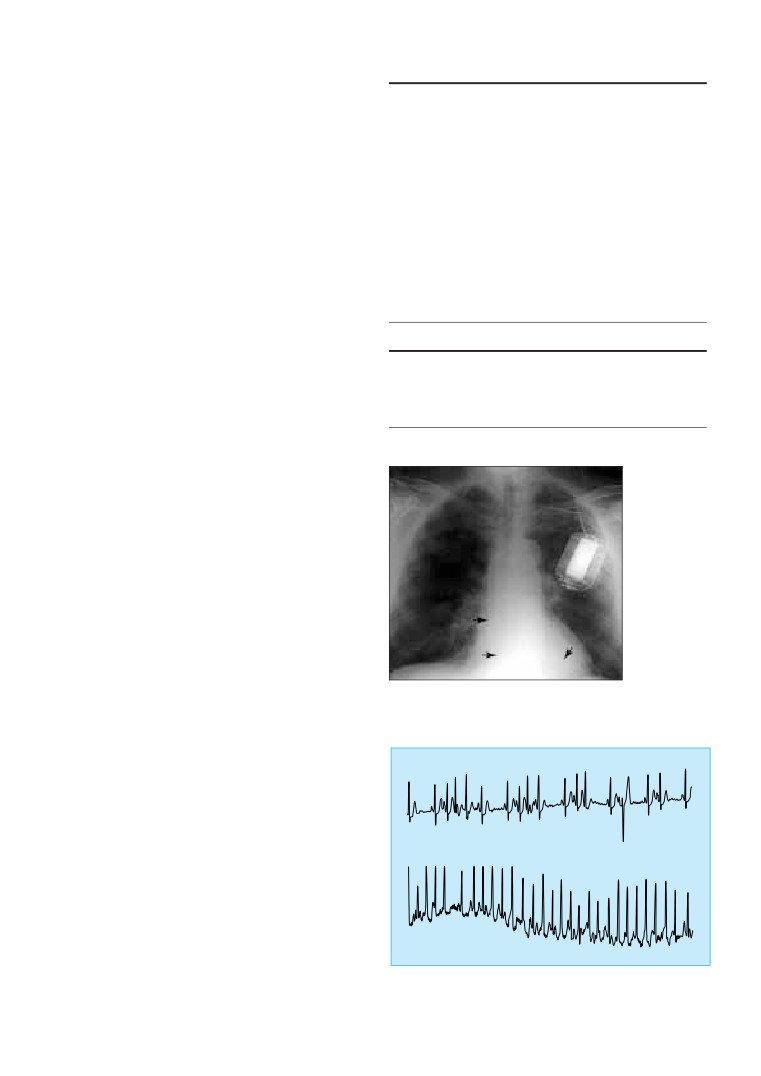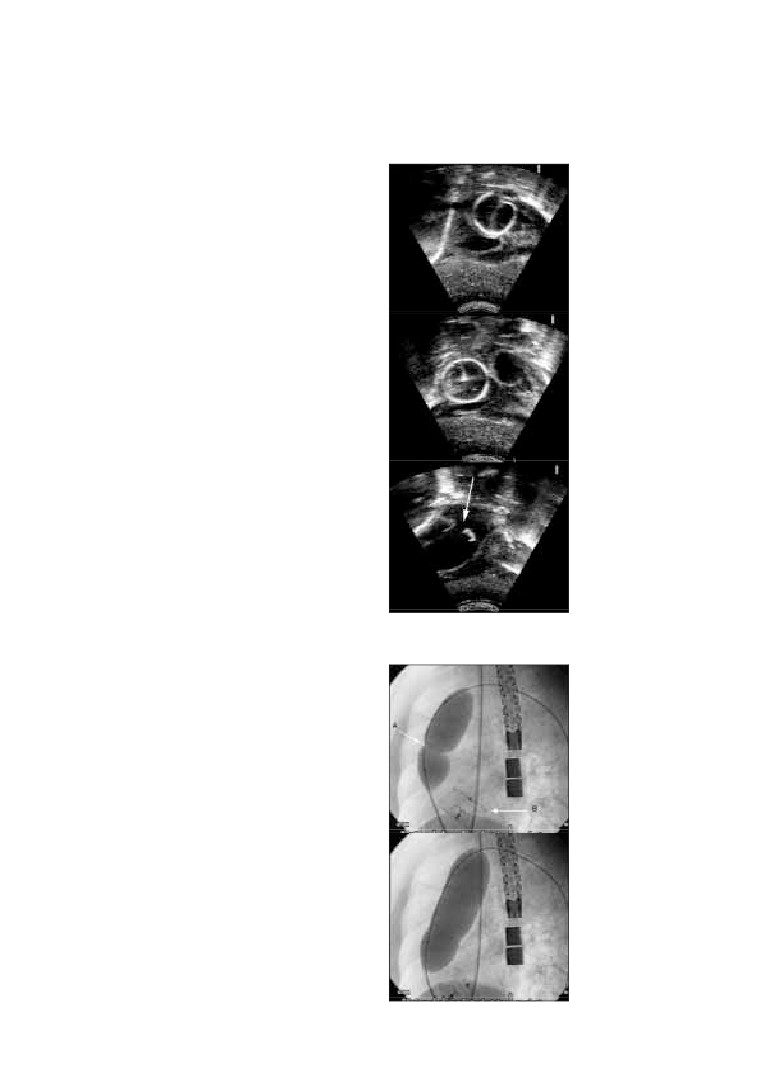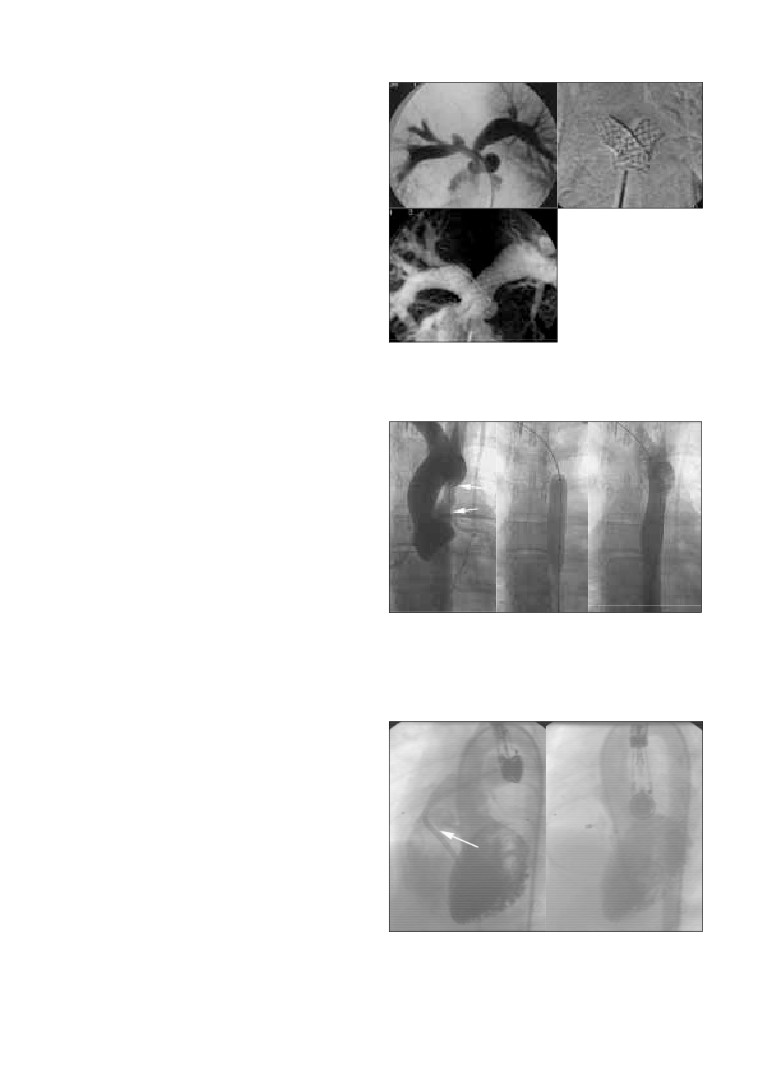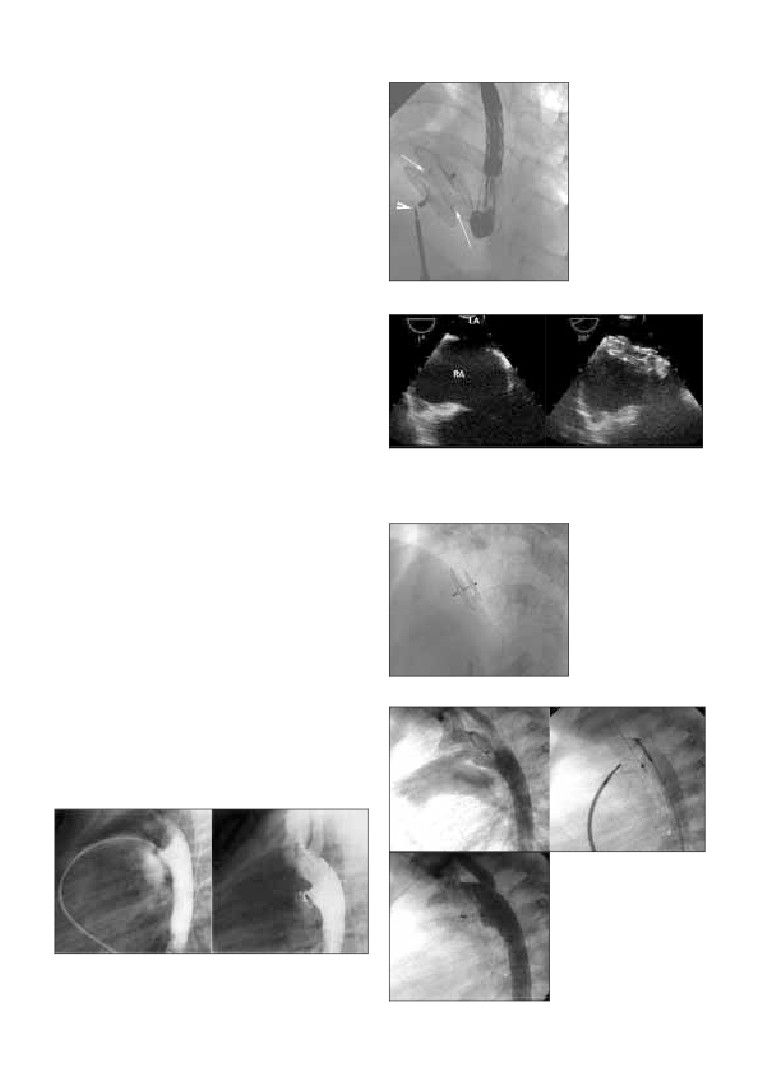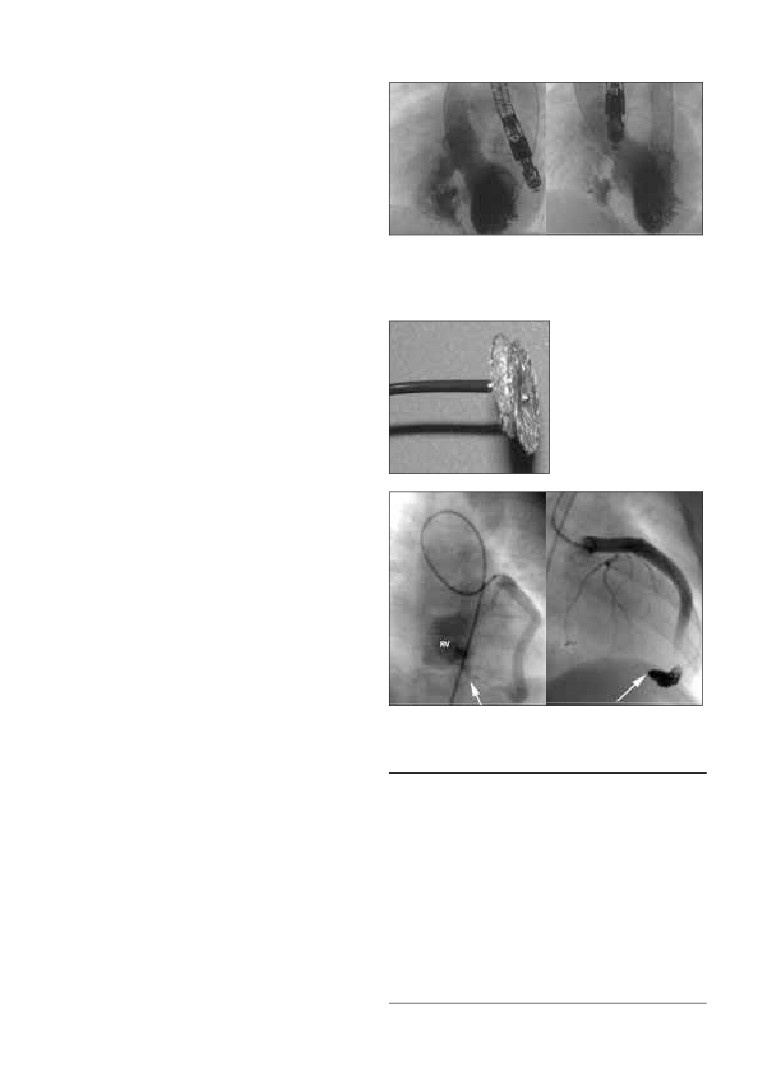ABC
OF
INTERVENTIONAL
CARDIOLOGY
Edited by Ever D Grech
ABC OF
INTERVENTIONAL CARDIOLOGY
For Lisa, Alexander, and Frances
ABC OF
INTERVENTIONAL CARDIOLOGY
Edited by
EVER D GRECH
Consultant Cardiologist, South Yorkshire Cardiothoracic Centre,
Northern General Hospital, Sheffield, UK
© BMJ Publishing Group 2004
All rights reserved. No part of this publication may be reproduced, stored in a retrieval system,
or transmitted, in any form or by any means, electronic, mechanical, photocopying,
recording and/or otherwise, without the prior written permission of the publishers.
First published in 2004
by BMJ Publishing Group Ltd, BMA House, Tavistock Square,
London WC1H 9JR
British Library Cataloguing in Publication Data
A catalogue record for this book is available from the British Library
ISBN 0 7279 1546 0
Cover shows coloured arteriogram of arteries of the heart.
With permission from Science Photo Library.
Typeset by BMJ Electronic Production and Newgen Imaging Systems
Printed and bound in Spain by GraphyCems, Navarra
Contents
Contributors
vi
Preface
vii
Acknowledgements
viii
1
Pathophysiology and investigation of coronary artery disease
1
Ever D Grech
2
Percutaneous coronary intervention. I: History and Development
5
Ever D Grech
3
Percutaneous coronary intervention. II: The procedure
8
Ever D Grech
4
Chronic stable angina: treatment options
12
Laurence O’Toole, Ever D Grech
5
Acute coronary syndrome: unstable angina and non-ST segment elevation myocardial infarction
16
Ever D Grech, David R Ramsdale
6
Acute coronary syndrome: ST segment elevation myocardial infarction
19
Ever D Grech, David R Ramsdale
7
Percutaneous coronary intervention: cardiogenic shock
22
John Ducas, Ever D Grech
8
Interventional pharmacotherapy
25
Roger Philipp, Ever D Grech
9
Non-coronary percutaneous intervention
29
Ever D Grech
10
New developments in percutaneous coronary intervention
33
Julian Gunn, Ever D Grech, David Crossman, David Cumberland
11
Percutaneous interventional electrophysiology
37
Gerry C Kaye
12
Implantable devices for treating tachyarrhythmias
41
Timothy Houghton, Gerry C Kaye
13
Interventional paediatric cardiology
45
Kevin P Walsh
Index
49
v
Contributors
David Crossman
Timothy Houghton
Professor of Clinical Cardiology, Cardiovascular Research
Registrar in Cardiology, Hull and East Yorkshire Trust, Castle
Group, Clinical Sciences Centre, Northern General Hospital,
Hill Hospital, Hull
Sheffield
Gerry C Kaye
David Cumberland
Consultant Cardiologist, Hull and East Yorkshire Trust, Castle
Consultant Cardiovascular Interventionist, Ampang Puteri
Hill Hospital, Hull
Specialist Hospital, Kuala Lumpur, Malaysia
Laurence O’Toole
John Ducas
Consultant Cardiologist and Physician, Royal Hallamshire
Consultant Cardiologist, Health Sciences Centre and
Hospital, Sheffield
St Boniface Hospital, Winnipeg, Manitoba and Associate
Professor, University of Manitoba, Winnipeg, Canada
Roger Philipp
Fellow in Interventional Cardiology, Health Sciences Centre
Ever D Grech
and St Boniface Hospital, Winnipeg, Manitoba, Canada
Consultant Cardiologist, South Yorkshire Cardiothoracic
Centre, Northern General Hospital, Sheffield, UK
David R Ramsdale
Consultant Cardiologist, Cardiothoracic Centre, Liverpool
Julian Gunn
Senior Lecturer and Honorary Consultant Cardiologist,
Kevin P Walsh
Cardiovascular Research Group, Clinical Sciences Centre,
Consultant Paediatric Cardiologist, Our Lady’s Hospital for
Northern General Hospital, Sheffield
Sick Children, Crumlin, Dublin, Republic of Ireland
vi
Preface
It is only 26 years since the first percutaneous transluminal coronary angioplasty (PTCA) was carried out by the pioneering Swiss
radiologist, Andreas Greuntzig, heralding the dawn of interventional cardiology. In this short time, interventional cardiology has
overcome many limitations and undergone major evolutionary changes—most notably the development of the coronary stent.
Worldwide, many thousands of patients now safely undergo percutaneous coronary intervention every day, and the numbers
continue to grow. In many countries, the numbers are similar to, or exceed, bypass surgical procedures.
Although, at first, PTCA was indicated only as treatment for chronic stable angina caused by a discrete lesion in a single vessel,
this has now progressed to encompass multi-lesion and multi-vessel disease. Moreover, percutaneous intervention is now becoming
widely used in the management of unstable angina and acute myocardial infarction with definite benefits in terms of morbidity and
mortality. The effectiveness and safety of these procedures has undoubtedly been enhanced by the adjunctive use of new anti-platelet
and antithrombotic agents.
As the indications increase and more patients are treated, so inevitably do the demands on healthcare budgets. Undoubtedly,
percutaneous intervention is expensive. However, this burden must be weighed against bypass surgery, which is even more costly, and
multi-drug treatment—which would be required over many years.
Although percutaneous coronary intervention has held centre stage in cardiology, major in-roads have also been made in non-
coronary areas. Transcatheter valvuloplasty, ethanol septal ablation and closure devices have become effective and safe alternatives
to surgery, as have paediatric interventional procedures. A greater understanding of cardiac electrophysiology has led to important
advances in the treatment of arrhythmias, and implantable cardioverter defibrillators are benefiting ever larger numbers of patients.
Where are we heading? This is perhaps the biggest question in the minds of many interventional cardiologists. New technology
generated by industry and new techniques coupled with high levels of expertise are fuelling advances in almost all areas of
interventional cardiology. As drug-eluting stents address the Achilles’ heel of angioplasty and stenting—restenosis—the huge
increase in percutaneous coronary procedures seen over recent years is likely to increase even further, and will probably be double
the rate of bypass surgery within a decade.
In writing and editing this book, I have endeavoured to present broad (and sometimes complex) aspects of interventional
cardiology in a clear, concise and balanced manner. To this end, an easy-to-read style of text, avoiding jargon and exhaustive detail,
has been used supplemented with many images and graphics.
EVER D GRECH
Sheffield, July 2003
vii
Acknowledgements
I have many people to thank for helping me develop and produce this book. I am very grateful to my coauthors who have all
willingly contributed their time and expertise. I would also like to recognise the positive efforts and invaluable assistance of the
British Medical Journal editors and illustrators. These include Trish Groves, Mary Banks, Eleanor Lines, Greg Cotton, and Naomi
Wilkinson.
Finally, my enduring gratitude goes to my family for their unfailing encouragement, patience, and love.
viii
1
Pathophysiology and investigation of coronary
artery disease
Ever D Grech
In affluent societies, coronary artery disease causes severe
Foam
Fatty
Intermediate Atheroma
Fibrous
Complicated
disability and more death than any other disease, including
cells
streak
lesion
plaque lesion or rupture
cancer. It manifests as angina, silent ischaemia, unstable angina,
myocardial infarction, arrhythmias, heart failure, and sudden
death.
Pathophysiology
Coronary artery disease is almost always due to atheromatous
narrowing and subsequent occlusion of the vessel. Early
From first decade
From third decade
From fourth decade
atheroma (from the Greek athera (porridge) and oma (lump)) is
Smooth
present from young adulthood onwards. A mature plaque is
Growth mainly by lipid accumulation
muscle
Thrombosis,
haematoma
and collagen
composed of two constituents, each associated with a particular
cell population. The lipid core is mainly released from necrotic
“foam cells”—monocyte derived macrophages, which migrate
Progression of atheromatous plaque from initial lesion to complex and
into the intima and ingest lipids. The connective tissue matrix is
ruptured plaque
derived from smooth muscle cells, which migrate from the
media into the intima, where they proliferate and change their
phenotype to form a fibrous capsule around the lipid core.
When a plaque produces a > 50% diameter stenosis (or
> 75% reduction in cross sectional area), reduced blood flow
Normal coronary
Lumen
artery
through the coronary artery during exertion may lead to
Intima (endothelium and internal
elastic lamina)
angina. Acute coronary events usually arise when thrombus
formation follows disruption of a plaque. Intimal injury causes
Lumen
Media (smooth muscle cells
denudation of the thrombogenic matrix or lipid pool and
and elastic tissue)
triggers thrombus formation. In acute myocardial infarction,
occlusion is more complete than in unstable angina, where
Adventitia (fibroblasts and
arterial occlusion is usually subtotal. Downstream embolism of
connective tissue)
thrombus may also produce microinfarcts.
Monocyte
Lumen
Plasma low density lipoprotein
Investigations
Key
Development
Collagen
of atheroma
Patients presenting with chest pain may be identified as having
Intima
definite or possible angina from their history alone. In the
Dividing smooth
muscle cell
former group, risk factor assessment should be undertaken,
Oxidised low
Lumen
Media
density lipoprotein
both to guide diagnosis and because modification of some
Monocyte
associated risk factors can reduce cardiovascular events and
mortality. A blood count, biochemical screen, and thyroid
Monocyte-derived
Adventitia
macrophages
function tests may identify extra factors underlying the onset of
(foam cells)
angina. Initial drug treatment should include aspirin, a
blocker, and a nitrate. Antihypertensive and lipid lowering
Schematic representation of normal coronary artery wall (top) and
drugs may also be given, in conjunction with advice on lifestyle
development of atheroma (bottom)
and risk factor modification.
All patients should be referred to a cardiologist to clarify the
diagnosis, optimise drug treatment, and assess the need and
suitability for revascularisation (which can improve both
Cardiovascular risk factors
symptoms and prognosis). Patients should be advised to seek
urgent medical help if their symptoms occur at rest or on
Non-modifiable risk factors
x Positive family history
x Age
x Male sex
minimal exertion and if they persist for more than 10 minutes
after sublingual nitrate has been taken, as these may herald the
Modifiable risk factors
x Hypercholesterolaemia
x Hypertension
x Smoking
onset of an acute coronary syndrome.
x Left ventricular
x Sedentary lifestyle
x Diabetes
hypertrophy
x Excessive alcohol
Priorities for cardiology referral
x Overweight and obesity
intake
x Recent onset of symptoms
x Severe symptoms (minimal
Uncertain risk factors
x Rapidly progressive symptoms
exertion or nocturnal angina)
x Hypertriglyceridaemia
x Lp(a) lipoprotein
x Uric acid
x Possible aortic stenosis
x Angina refractory to medical
x Microalbuminuria
x Fibrinogen
x Renin
x Threatened employment
treatment
x Hyperhomocysteinaemia
x C reactive protein
1
ABC of Interventional Cardiology
Non-invasive investigations
Exercise stress testing
Electrocardiography
An abnormal electrocardiogram increases the suspicion of
Indications
Contraindications
significant coronary disease, but a normal result does not
x Confirmation of suspected angina
x Cardiac failure
x Evaluation of extent of myocardial
x Any feverish illness
exclude it.
ischaemia and prognosis
x Left ventricular outflow tract
x Risk stratification after myocardial
obstruction or hypertrophic
Chest x ray
infarction
cardiomyopathy
Patients with angina and no prior history of cardiac disease
x Detection of exercise induced
x Severe aortic or mitral
usually have a normal chest x ray film.
symptoms (such as arrhythmias or
stenosis
syncope)
x Uncontrolled hypertension
x Evaluation of outcome of
x Pulmonary hypertension
Exercise electrocardiography
interventions (such as
x Recent myocardial infarction
This is the most widely used test in evaluating patients with
percutaneous coronary
x Severe tachyarrhythmias
suspected angina. It is generally safe (risk ratio of major adverse
interventions or coronary artery
x Dissecting aortic aneurysm
events 1 in 2500, and of mortality 1 in 10 000) and provides
bypass surgery)
x Left main stem stenosis or
x Assessment of cardiac transplant
equivalent
diagnostic as well as prognostic information. The average
x Rehabilitation and patient
x Complete heart block (in
sensitivity and specificity is 75%. The test is interpreted in terms
motivation
adults)
of achieved workload, symptoms, and electrocardiographic
response. A 1 mm depression in the horizontal ST segment is
the usual cut-off point for significant ischaemia. Poor exercise
Rest
capacity, an abnormal blood pressure response, and profound
ischaemic electrocardiographic changes are associated with a
poor prognosis.
I
aVR
V1
V4
Main end points for exercise electrocardiography
x Target heart rate achieved ( > 85% of maximum predicted heart rate)
II
aVL
V2
V5
x ST segment depression > 1 mm (downsloping or planar depression
of greater predictive value than upsloping depression)
x Slow ST recovery to normal ( > 5 minutes)
III
aVF
V3
V6
x Decrease in systolic blood pressure > 20 mm Hg
x Increase in diastolic blood pressure > 15 mm Hg
x Progressive ST segment elevation or depression
Peak
exercise
x ST segment depression > 3 mm without pain
x Arrhythmias (atrial fibrillation, ventricular tachycardia)
Features indicative of a strongly positive exercise test
I
aVR
V1
V4
x Exercise limited by angina to < 6 minutes of Bruce protocol
x Failure of systolic blood pressure to increase > 10 mm Hg, or fall
with evidence of ischaemia
x Widespread marked ST segment depression > 3 mm
x Prolonged recovery time of ST changes ( > 6 minutes)
II
aVL
V2
V5
x Development of ventricular tachycardia
x ST elevation in absence of prior myocardial infarction
III
aVF
V3
V6
Stress echocardiography
Stress induced impairment of myocardial contraction is a
Example of a strongly positive exercise test. After only 2 minutes and 24
seconds of exercise (according to Bruce protocol), the patient developed
sensitive marker of ischaemia and precedes
chest pain and electrocardiography showed marked ischaemic changes
electrocardiographic changes and angina. Cross sectional
(maximum 3 mm ST segment depression in lead V6)
echocardiography can be used to evaluate regional and global
left ventricular impairment during ischaemia, which can be
induced by exercise or an intravenous infusion of drugs that
increase myocardial contraction and heart rate (such as
dobutamine) or dilate coronary arterioles (such as dipyridamole
or adenosine). The test has a higher sensitivity and specificity
than exercise electrocardiography and is useful in patients
whose physical condition limits exercise.
Radionuclide myocardial perfusion imaging
Thallium-201 or technetium-99m (99mTc-sestamibi,
99mTc-tetrofosmin) is injected intravenously at peak stress, and its
myocardial distribution relates to coronary flow. Images are
acquired with a gamma camera. This test can distinguish
between reversible and irreversible ischaemia (the latter
signifying infarcted tissue). Although it is expensive and
requires specialised equipment, it is useful in patients whose
99mTc-tetrofosmin perfusion scan showing reversible anterolateral wall
exercise test is non-diagnostic or whose exercise ability is
ischaemia, induced by intravenous dobutamine infusion (white arrows).
limited.
Normal rest images are shown by yellow arrows
2
Pathophysiology and investigation of coronary artery disease
A multigated acquisition (MUGA) scan assesses left
ventricular function and can reveal salvageable myocardium in
patients with chronic coronary artery disease. It can be
performed with either thallium scintigraphy at rest or metabolic
imaging with fluorodeoxyglucose by means of either positron
emission tomography (PET) or single photon emission
computed tomography (SPECT).
Invasive investigations
Coronary angiography
The only absolute way to evaluate coronary artery disease is by
angiography. It is usually performed as part of cardiac
Angiograms of normal coronary arteries (LAD=left anterior descending
catheterisation, which includes left ventricular angiography and
artery, DG=diagonal artery, LCx=left circumflex artery, OM=obtuse marginal
haemodynamic measurements, providing a more complete
artery, SAN=sino-atrial node artery, RV=right ventricular branch artery,
LV=left ventricular branch artery, PDA=posterior descending artery)
evaluation of an individual’s cardiac status. Cardiac
catheterisation is safely performed as a day case procedure.
Patients must be fully informed of the purpose of the
procedure as well as its risks and limitations. Major
complications, though rare in experienced hands, include death
(risk ratio 1 in 1400), stroke (1 in 1000), coronary artery
Main indications for coronary angiography
dissection (1 in 1000), and arterial access complications (1 in
x Uncertain diagnosis of angina (coronary artery disease cannot be
500). Risks depend on the individual patient, and predictors
excluded by non-invasive testing)
include age, coronary anatomy (such as severe left main stem
x Assessment of feasibility and appropriateness of various forms of
disease), impaired left ventricular function, valvar heart disease,
treatment (percutaneous intervention, bypass surgery, medical)
the clinical setting, and non-cardiac disease. The commonest
x Class I or II stable angina with positive stress test or class III or IV
angina without positive stress test
complications are transient or minor and include arterial access
x Unstable angina or non-Q wave myocardial infarction (medium
bleeding and haematoma, pseudoaneurysm, arrhythmias,
and high risk patients)
reactions to the contrast medium, and vagal reactions (during
x Angina not controlled by drug treatment
sheath insertion or removal).
x Acute myocardial infarction—especially cardiogenic shock,
Before the procedure, patients usually fast and may be given
ineligibility for thrombolytic treatment, failed thrombolytic
a sedative. Although a local anaesthetic is used, arterial access
reperfusion, re-infarction, or positive stress test
x Life threatening ventricular arrhythmia
(femoral, brachial, or radial) may be mildly uncomfortable.
x Angina after bypass surgery or percutaneous intervention
Patients do not usually feel the catheters once they are inside
x Before valve surgery or corrective heart surgery to assess occult
the arteries. Transient angina may occur during injection of
coronary artery disease
contrast medium, usually because of a severely diseased artery.
Patients should be warned that, during left ventricular
angiography, the large volume of contrast medium may cause a
transient hot flush and a strange awareness of urinary
incontinence (and can be reassured that this does not actually
happen). Modern contrast agents rarely cause nausea and
vomiting.
Insertion of an arterial sheath with a haemostatic valve
minimises blood loss and allows catheter exchange. Three types
of catheter, which come in a variety of shapes and diameters,
are commonly used. Two have a single hole at the end and are
designed to facilitate controlled engagement of the distal tip
within the coronary artery ostium. Contrast medium is injected
through the lumen of the catheter, and moving x ray images are
obtained and recorded. Other catheters may be used for graft
angiography. The “pigtail” catheter has an end hole and several
side holes and is passed across the aortic valve into the left
ventricle. It allows injection of 30-40 ml of contrast medium
Left ventricular
angiogram during diastole
(top) and systole (bottom)
after injection of contrast
medium via a pigtail
catheter, showing good
contractility (LCA=left
coronary artery)
Commonly used diagnostic catheters (from left
to right): right Judkins, left Judkins,
multipurpose, left Amplatz, and pigtail
3
ABC of Interventional Cardiology
over three to five seconds by a motorised pump, providing
Ultrasound
visualisation of left ventricular contraction over two to four
scan plane
Vessel
cardiac cycles. Aortic and ventricular pressures are also
IVUS catheter
recorded during the procedure.
Intravascular ultrasound (IVUS)
In contrast to angiography, which gives a two dimensional
luminal silhouette with little information about the vessel wall,
intravascular ultrasound provides a cross sectional, three
Media and
Stent struts
dimensional image of the full circumference of the artery. It
adventitia
border
allows precise measurement of plaque length and thickness and
Fibro-fatty
minimum lumen diameter, and it may also characterise the
plaque
plaque’s composition.
It is often used to clarify ambiguous angiographic findings
and to identify wall dissections or thrombus. It is most useful
IVUS catheter
during percutaneous coronary intervention, when target lesions
Lumen
can be assessed before, during, and after the procedure and at
follow up. The procedure can also show that stents which seem
The intravascular ultrasound (IVUS) catheter (above) and images showing a
to be well deployed on angiography are, in fact, suboptimally
stent within a diseased coronary artery (below)
expanded. Its main limitations are the need for an operator
experienced in its use and its expense; for these reasons it is not
routinely used in many centres.
Doppler flow wire and pressure wire
Unlike angiography or intravascular ultrasound, the Doppler
flow wire and pressure wire provide information on the
physiological importance of a diseased coronary artery. They
are usually used when angiography shows a stenosis that is of
intermediate severity, or to determine the functional severity of
Angina?
a residual stenosis after percutaneous coronary intervention.
Intracoronary adenosine is used to dilate the distal coronary
vessels in order to maximise coronary flow. The Doppler flow
Definite or possible
Unlikely
wire has a transducer at its tip, which is positioned beyond the
stenosis to measure peak flow velocity. The pressure wire has a
Risk factor assessment, blood tests, electrocardiography
tip micrometer, which records arterial pressures proximal and
distal to the stenosis.
Drug treatment for symptoms and risk factor reduction
The figure showing progression of atheromatous plaque from initial lesion
Refer to cardiologist
is adapted with permission from Pepine CJ, Am J Cardiol 1998;82(suppl
10A):23-7S.
Competing interests: None declared.
Stress test
Further reading
Strongly positive
Mildly positive
Negative
x Mark DB, Shaw L, Harrell FE Jr, Hlatky MA, Lee KL, Bengtson JR,
et al. Prognostic value of a treadmill exercise score in outpatients
Review diagnosis
with suspected coronary artery disease. N Engl J Med 1991;325:
849-53
x Marwick TH, Case C, Sawada S, Rimmerman C, Brenneman P,
Angina
Not angina
Kovacs R, et al. Prediction of mortality using dobutamine
echocardiography. J Am Coll Cardiol 2001;37:754-60
x Scanlon PJ, Faxon DP, Audet AM, Carabello B, Dehmer GJ, Eagle
Medical treatment
KA, et al. ACC/AHA guidelines for coronary angiography. A report
of the American College of Cardiology/American Heart
Association Task Force on Practice Guidelines (Committee on
Angiography
Poor control
Good control
Coronary Angiography). J Am Coll Cardiol 1999;33:1756-824
x Mintz GS, Nissen SE, Anderson WD, Bailey SR, Erbel R, Fitzgerald
PJ, et al. American College of Cardiology clinical expert consensus
Revascularisation (PCI or CABG)
Continue medical treatment
document on standards for acquisition, measurement and reporting
of intravascular ultrasound studies (IVUS). J Am Coll Cardiol
2001;37:1478-92
Algorithm for management of suspected angina (PCI=percutaneous
coronary intervention, CABG=coronary artery bypass grafting)
4
2
Percutaneous coronary intervention.
I: History and development
Ever D Grech
Canadian Cardiovascular Society classification of angina
The term “angina pectoris” was introduced by Heberden in
Class I
1772 to describe a syndrome characterised by a sensation of
x No angina during ordinary physical activity such as walking or
“strangling and anxiety” in the chest. Today, it is used for chest
climbing stairs
discomfort attributed to myocardial ischaemia arising from
x Angina during strenuous, rapid, or prolonged exertion
increased myocardial oxygen consumption. This is often
Class II
induced by physical exertion, and the commonest aetiology is
x Slight limitation of ordinary activity
atheromatous coronary artery disease. The terms “chronic” and
x Angina on walking or climbing stairs rapidly; walking uphill;
“stable” refer to anginal symptoms that have been present for at
walking or climbing stairs shortly after meals, in cold or wind, when
least several weeks without major deterioration. However,
under emotional stress, or only in the first few hours after waking
x Angina on walking more than two blocks (100-200 m) on the level
symptom variation occurs for several reasons, such as mental
or climbing more than one flight of stairs at normal pace and in
stress, ambient temperature, consumption of alcohol or large
normal conditions
meals, and factors that may increase coronary tone such as
Class III
drugs and hormonal change.
x Marked limitation of ordinary physical activity
x Angina on walking one or two blocks on the level or climbing one
flight of stairs at normal pace and in normal conditions
Classification
Class IV
The Canadian Cardiovascular Society has provided a graded
x Inability to carry out any physical activity without discomfort
classification of angina which has become widely used. In
x Includes angina at rest
clinical practice, it is important to describe accurately specific
activities associated with angina in each patient. This should
include walking distance, frequency, and duration of episodes.
Percutaneous transluminal coronary angioplasty (PTCA)
1977
Development in PTCA equipment
Mid
History of myocardial
1980s
(soft tipped guide catheters, steerable guidewires, lower profile balloon catheters)
revascularisation
Mid
In the management of chronic stable angina, there are two
Stents
Athero-ablative devices
1990s
(directional coronary atherectomy, rotablator, lasers)
invasive techniques available for myocardial revascularisation:
onwards
coronary artery bypass surgery and catheter attached devices.
Although coronary artery bypass surgery was introduced in
New stent designs
Brachytherapy
New balloon designs
Adjunctive
1968, the first percutaneous transluminal coronary angioplasty
and "smart" stents
• β radiation
• Low profile
pharmacotherapy
was not performed until September 1977 by Andreas
• Pre-mounted
emission
• High inflation
• ADP antagonists
• Increased flexibility
• γ radiation
• Short or long
• Glycoprotein IIb/
Gruentzig, a Swiss radiologist, in Zurich. The patient, 38 year
and radial strength
emission
balloons
IIIa inhibitors
old Adolph Bachman, underwent successful angioplasty to a left
• Covered stents
• Cutting balloons
• Coated stents
coronary artery lesion and remains well to this day. After the
• "Designer" drugs
success of the operation, six patients were successfully treated
with percutaneous transluminal coronary angioplasty in that
• Biodegradable stents
• Drug or gene delivery
year.
stents
By today’s standards, the early procedures used
• Radioactive stents
cumbersome equipment: guide catheters were large and could
easily traumatise the vessel, there were no guidewires, and
Major milestones in percutaneous coronary intervention
balloon catheters were large with low burst pressures. As a
result, the procedure was limited to patients with refractory
angina, good left ventricular function, and a discrete, proximal,
concentric, and non-calcific lesion in a single major coronary
artery with no involvement of major side branches or
angulations. Consequently, it was considered feasible in only
10% of all patients needing revascularisation.
Modern balloon
Developments in percutaneous
catheter: its low
profile facilitates
intervention
lesion crossing, the
flexible shaft allows
During 1977-86 guide catheters, guidewires, and balloon
tracking down
catheter technology were improved, with slimmer profiles and
tortuous vessels, and
the balloon can be
increased tolerance to high inflation pressures. As equipment
inflated to high
improved and experience increased, so more complex lesions
pressures without
were treated and in more acute situations. Consequently,
distortion or rupture
5
ABC of Interventional Cardiology
percutaneous transluminal coronary angioplasty can now be
undertaken in about half of patients needing revascularisation
(more in some countries), and it is also offered to high-risk
patients for whom coronary artery bypass surgery may be
considered too dangerous.
Although percutaneous transluminal coronary angioplasty
causes plaque compression, the major change in lumen
geometry is caused by fracturing and fissuring of the atheroma,
extending into the vessel wall at variable depths and lengths.
This injury accounts for the two major limitations of
percutaneous transluminal coronary angioplasty{acute vessel
closure and restenosis.
Micrographs showing arterial
Acute vessel closure—This usually occurs within the first 24
barotrauma caused by coronary
hours of the procedure in about 3-5% of cases and follows
angioplasty. Top left: coronary
arterial dissection with large flap.
vessel dissection, acute thrombus formation, or both. Important
Top right: deep fissuring within
clinical consequences include myocardial infarction, emergency
coronary artery wall atheroma.
coronary artery bypass surgery, and death.
Bottom: fragmented plaque tissue
(dark central calcific plaque
Restenosis occurring in the first six months after angioplasty
surrounded by fibrin and
is caused largely by smooth muscle cell proliferation and
platelet-rich thrombus), which may
fibrointimal hyperplasia (often called neointimal proliferation),
embolise in distal arterioles to cause
as well as elastic recoil. It is usually defined as a greater than
infarction
50% reduction in luminal diameter and has an incidence of
25-50% (higher after vein graft angioplasty). Further
intervention may be indicated if angina and ischaemia recur.
Drills, cutters, and lasers
In the 1980s, two main developments aimed at limiting these
problems emerged. The first were devices to remove plaque
material, such as by rotational atherectomy, directional coronary
atherectomy, transluminal extraction catheter, and excimer
laser. By avoiding the vessel wall trauma seen during
percutaneous transluminal coronary angioplasty, it was
envisaged that both acute vessel closure and restenosis rates
Tools for coronary atherectomy. Top:
would be reduced.
the Simpson atherocath has a cutter in
However, early studies showed that, although acute closure
a hollow cylindrical housing. The cutter
rotates at 2000 rpm, and excised
rates were reduced, there was no significant reduction in
atheromatous tissue is pushed into the
restenosis. Moreover, these devices are expensive, not
distal nose cone. Left: the Rotablator
particularly user friendly, and have limited accessibility to more
burr is coated with 10
m diamond
distal stenoses. As a result, they have now become niche tools
chips to create an abrasive surface. The
burr, connected to a drive shaft and a
used by relatively few interventionists. However, they may have
turbine powered by compressed air,
an emerging role in reducing restenosis rates when used as
rotates at speeds up to 200 000 rpm
adjunctive treatment before stenting (especially for large
plaques) and in treating diffuse restenosis within a stent.
Intracoronary stents
The second development was the introduction of intracoronary
stents deployed at the site of an atheromatous lesion. These
were introduced in 1986 with the objective of tacking down
dissection flaps and providing mechanical support. They also
reduce elastic recoil and remodelling associated with restenosis.
The first large randomised studies conclusively showed the
superiority of stenting over coronary angioplasty alone, both in
clinical and angiographic outcomes, including a significant 30%
reduction in restenosis rates. Surprisingly, this was not due to
inhibition of neointimal proliferation—in fact stents may
increase this response. The superiority of stenting is that the
initial gain in luminal diameter is much greater than after
angioplasty alone, mostly because of a reduction in elastic
recoil.
Although neointimal proliferation through the struts of the
stent occurs, it is insufficient to cancel out the initial gain,
Coronary stents. Top: Guidant Zeta stent. Middle: BiodivYsio AS stent coated
leading to a larger lumen size and hence reduced restenosis.
with phosphorylcholine, a synthetic copy of the outer membrane of red
blood cells, which improves haemocompatibility and reduces thrombosis.
Maximising the vessel lumen is therefore a crucial mechanism
Bottom: the Jomed JOSTENT coronary stent graft consists of a layer of
for reducing restenosis. “Bigger is better” is the adage followed
PTFE (polytetrafluoroethylene) sandwiched between two stents and is useful
in this case.
in sealing perforations, aneurysms, and fistulae
6
Percutaneous coronary intervention. I: History and development
Early stent problems
As a result of initial studies, stents were predominantly used
either as “bail out” devices for acute vessel closure during
coronary angioplasty (thus avoiding the need for immediate
coronary artery bypass surgery) or for restenosis after
angioplasty.
Thrombosis within a stent causing myocardial infarction
and death was a major concern, and early aggressive
anticoagulation to prevent this led to frequent complications
from arterial puncture wounds as well as major systemic
haemorrhage. These problems have now been overcome by the
introduction of powerful antiplatelet drugs as a substitute for
warfarin. The risk of thrombosis within a stent diminishes when
the stent is lined with a new endothelial layer, and antiplatelet
treatment can be stopped after a month. The recognition that
suboptimal stent expansion is an important contributor to
Coronary angiogram showing
thrombosis in stents has led to the use of intravascular
three lesions (arrows) affecting
ultrasound to guide stent deployment and high pressure
the left anterior descending
inflations to ensure complete stent expansion.
artery (top left). The lesions
are stented without
pre{dilatation (top right), with
Current practice
good results (bottom)
A greater understanding of the pathophysiology of stent
deployment, combined with the development of more flexible
stents (which are pre-mounted on low-profile catheter
balloons), has resulted in a massive worldwide increase in stent
use, and they have become an essential component of coronary
intervention. Low profile stents have also allowed “direct”
stenting—that is, implanting a stent without the customary
2500
balloon dilatation—to become prevalent, with the advantages of
economy, shorter procedure time, and less radiation from
2000
imaging. Most modern stents are expanded by balloon and
1500
made from stainless steel alloys. Their construction and design,
metal thickness, surface coverage, and radial strength vary
1000
considerably.
500
Stents are now used in most coronary interventions and in a
wide variety of clinical settings. They substantially increase
0
1986
1994
1998
2001
procedural safety and success, and reduce the need for
Year
emergency coronary artery bypass surgery. Procedures
involving stent deployment are now often referred to as
Exponential increase in use of intracoronary stents since
percutaneous coronary interventions to distinguish them from
1986. In 2001, 2.3 million stents were implanted (more
conventional balloon angioplasty (percutaneous transluminal
than double the 1998 rate)
coronary angioplasty).
A major recent development has been the introduction of
drug eluting stents (also referred to as “coated stents”), which
reduce restenosis to very low rates. Their high cost currently
limits their use, but, with increasing competition among
manufacturers, they will probably become more affordable.
Unequivocal indications for use of coronary stents
x Acute or threatened vessel closure during angioplasty
Competing interests: None declared.
x Primary reduction in restenosis in de novo lesions in arteries
> 3.0 mm in diameter
The micrographs showing deep fissuring within a coronary artery wall
x Focal lesions in saphenous vein grafts
atheroma and fragmented plaque tissue caused by coronary angioplasty
x Recanalised total chronic occlusions
were supplied by Kelly MacDonald, consultant histopathologist at St
x Primary treatment of acute coronary syndromes
Boniface Hospital, Winnipeg, Canada.
Further reading
x Gruentzig AR. Transluminal dilatation of coronary artery stenosis.
x Meyer BJ, Meier B. Percutaneous transluminal coronary angioplasty
Lancet 1978;1:263
of single or multivessel disease and chronic total occlusions. In:
x Smith SC Jr, Dove JT, Jacobs AK, Kennedy JW, Kereiakes D, Kern
Grech ED, Ramsdale DR, eds. Practical interventional cardiology.
MJ, et al. ACC/AHA guidelines of percutaneous coronary
2nd ed. London: Martin Dunitz, 2002:35-54
interventions (revision of the 1993 PTCA guidelines)—executive
x Costa MA, Foley DP, Serruys PW. Restenosis: the problem and how
summary. A report of the American College of Cardiology/
to deal with it. In: Grech ED, Ramsdale DR, eds. Practical
American Heart Association Task Force on Practice Guidelines
interventional cardiology. 2nd ed. London: Martin Dunitz, 2002:
(committee to revise the 1993 guidelines for percutaneous
279-94
transluminal coronary angioplasty). J Am Coll Cardiol 2001;37:
x Topol EJ, Serruys PW. Frontiers in interventional cardiology.
2215-39
Circulation 1998;98:1802-20
7
3
Percutaneous coronary intervention.
II: The procedure
Ever D Grech
A wide range of patients may be considered for percutaneous
coronary intervention. It is essential that the benefits and risks of
the procedure, as well as coronary artery bypass graft surgery and
medical treatment, are discussed with patients (and their families)
in detail. They must understand that, although the percutaneous
procedure is more attractive than bypass surgery, it has important
limitations, including the likelihood of restenosis and potential
for incomplete revascularisation compared with surgery. The
potential benefits of antianginal drug treatment and the need for
risk factor reduction should also be carefully explained.
Clinical risk assessment
Relief of anginal symptoms is the principal clinical indication
for percutaneous intervention, but we do not know whether the
procedure has the same prognostic benefit as bypass surgery.
Angiographic features determined during initial assessment
require careful evaluation to determine the likely success of the
Percutaneous coronary intervention in progress. Above the patient’s chest is
procedure and the risk of serious complications.
the x ray imaging camera. Fluoroscopic images, electrocardiogram, and
haemodynamic data are viewed at eye level screens. All catheterisation
Until recently, the American College of Cardiology and
laboratory operators wear lead protection covering body, thyroid, and eyes,
American Heart Association classified anginal lesions into types
and there is lead shielding between the primary operator and patient
(and subtypes) A, B, or C based on the severity of lesion
characteristics. Because of the ability of stents to overcome
many of the complications of percutaneous intervention, this
New classification system of stenotic lesions (American
classification has now been superseded by one reflecting low,
College of Cardiology and American Heart Association)
moderate, and high risk.
Successful percutaneous intervention depends on adequate
Low risk
Moderate risk
High risk
visualisation of the target stenosis and its adjacent arterial
Discrete ( < 10 mm)
Tubular (10-20 mm)
Diffuse ( > 20 mm)
branches. Vessels beyond the stenosis may also be important
Concentric
Eccentric
because of the potential for collateral flow and myocardial
Readily accessible
Proximal segment
Proximal segment
support if the target vessel were to occlude abruptly. Factors
moderately tortuous
excessively tortuous
that adversely affect outcome include increasing age, comorbid
Segment not angular Segment moderately Segment extremely
(<45°)
angular (45°- < 90°)
angular (>90°)
disease, unstable angina, pre-existing heart or renal failure,
previous myocardial infarction, diabetes, a large area of
Smooth contour
Irregular contour
myocardium at risk, degree of collaterisation, and multivessel
Little or no
Moderate or heavy
calcification
calcification
disease.
Occlusion not total
Total occlusion
Total occlusion
<3 months old
>3 months or bridging
collateral vessels
Preparation for intervention
Non-ostial
Ostial
Patients must be fully informed of the purpose of the procedure
No major side
Bifurcated lesions
Inability to protect
as well as its risks and limitations before they are asked for their
branch affected
requiring double
major side branches
consent. The procedure must always be carried out (or directly
guidewires
supervised) by experienced, high volume operators ( > 75
No thrombus
Some thrombus
Degenerated vein grafts
with friable lesions.
procedures a year) and institutions ( > 400 a year).
A sedative is often given before the procedure, as well as
aspirin, clopidogrel, and the patient’s usual antianginal drugs.
In very high risk cases an intra-aortic balloon pump may be
Clinical indications for percutaneous
used. A prophylactic temporary transvenous pacemaker wire
coronary intervention
may be inserted in some patients with pre-existing, high grade
x Stable angina (and positive stress test)
conduction abnormality or those at high risk of developing it.
x Unstable angina
x Acute myocardial infarction
x After myocardial infarction
The procedure
x After coronary artery bypass surgery
(percutaneous intervention to native vessels,
For an uncomplicated, single lesion, a percutaneous procedure
arterial or venous conduits)
may take as little as 30 minutes. However, the duration of the
x High risk bypass surgery
procedure and radiation exposure will vary according to
x Elderly patient
thenumber and complexity of the treated stenoses and vessels.
8
Percutaneous coronary intervention. II: The procedure
As with coronary angiography, arterial access (usually
femoral but also brachial or radial) under local anaesthesia is
required. A guide catheter is introduced and gently engaged at
the origin of the coronary artery. The proximal end of the
catheter is attached to a Y connector. One arm of this
connector allows continuous monitoring of arterial blood
pressure. Dampening or “ventricularisation” of this arterial
tracing may indicate reduced coronary flow because of
over-engagement of the guide catheter, catheter tip spasm, or a
previously unrecognised ostial lesion. The other arm has an
adjustable seal, through which the operator can introduce the
guidewire and balloon or stent catheter once the patient has
been given heparin as an anticoagulant. A glycoprotein IIb/IIIa
inhibitor, which substantially reduces ischaemic events during
Equipment commonly used in percutaneous coronary interventions
percutaneous coronary intervention, may also be given.
Visualised by means of fluoroscopy and intracoronary
injections of contrast medium, a soft tipped, steerable guidewire
A
(usually 0.014" (0.36 mm) diameter) is passed down the
coronary artery, across the stenosis, and into a distal branch. A
balloon or stent catheter is then passed over the guidewire and
positioned at the stenosis. The stenosis may then be stented
directly or dilated before stenting. Additional balloon dilatation
B
may be necessary after deployment of a stent to ensure its full
expansion.
Balloon inflation inevitably stops coronary blood flow,
which may induce angina. Patients usually tolerate this quite
well, especially if they have been warned beforehand. If it
C
becomes severe or prolonged, however, an intravenous opiate
may be given. Ischaemic electrocardiographic changes are often
seen at this time, although they are usually transient and return
to baseline once the balloon is deflated (usually after 30-60
seconds). During the procedure, it is important to talk to the
patient (who may be understandably apprehensive) to let him
D
or her know what is happening, as this encourages a good
rapport and cooperation.
Deployment of a balloon-mounted stent across stenotic
Recovery
lesion. Once the guide catheter is satisfactorily engaged,
the lesion is crossed with a guidewire and the
After the procedure the patient is transferred to a ward where
balloon-mounted stent positioned to cover the lesion (A).
close monitoring for signs of ischaemia and haemodynamic
It may be necessary to pre-dilate a severe lesion with a
instability is available. If a femoral arterial sheath was used, it
balloon to provide adequate passageway for the balloon
may be removed when the heparin effect has declined to an
and stent. The balloon is inflated to expand the stent (B).
The balloon is then deflated (C) and withdrawn leaving
acceptable level (according to unit protocols). Arterial sealing
the guidewire (D), which is also removed once the
devices have some advantages over manual compression: they
operator is satisfied that a good result has been obtained
permit immediate sheath removal and haemostasis, are more
comfortable for patients, and allow early mobilisation and
discharge. However, they are not widely used as they add
considerably to the cost of the procedure.
After a few hours, the patient should be encouraged to
gradually increase mobility, and in uncomplicated cases
discharge is scheduled for the same or the next day. Before
discharge, the arterial access site should be examined and the
patient advised to seek immediate medical advice if bleeding or
chest pain (particularly at rest) occurs. Outpatient follow up and
Example of a
drug regimens are provided, as well as advice on modification
femoral artery
closure device.
of risk factors and lifestyle.
The Angio-Seal
device creates a
mechanical seal
Complications and sequelae
by sandwiching
the arteriotomy
Complications are substantially lower in centres where large
B
between an
numbers of procedures are carried out by adequately trained
anchor placed
and experienced operators. Major complications are
Femoral
against the inner
artery
arterial wall (A)
uncommon and include death (0.2% but higher in high risk
and collagen
cases), acute myocardial infarction (1%) which may require
A
sponge (B), which
emergency coronary artery bypass surgery, embolic stroke
both dissolve
(0.5%), cardiac tamponade (0.5%), and systemic bleeding (0.5%).
within 60-90 days
9
ABC of Interventional Cardiology
Minor complications are more common and include allergy
to the contrast medium and nephropathy and complications of
the access site (bleeding, haematoma, and pseudoaneurysm).
Restenosis within a stent
Although stents prevent restenosis from vascular recoil and
remodelling, restenosis within the stent (known as “in-stent
restenosis”) due to neointimal proliferation does occur and is
the most important late sequel of the procedure. In-stent
restenosis is the Achilles’ heel of percutaneous revascularisation
and develops within six months of stenting.
Angiographic restenosis rates ( > 50% diameter stenosis)
depend on several factors and are higher in smaller vessels,
long and complex stenoses, and where there are coexisting
conditions such as diabetes. Approximate rates of angiographic
restenosis after percutaneous angioplasty are
x Angioplasty to de novo lesion in native artery—35%
Focal in-stent restenosis. A 2.0 mm stent had been deployed six
x Angioplasty and stent to de novo lesion in native artery—25%
months earlier. After recurrence of angina, angiography showed
x Angioplasty and stent to restenotic lesion in native artery—20%
focal in-stent restenosis (arrow, top left). This was confirmed with
x Angioplasty and stent to successfully recanalised chronic
intravascular ultrasound (top right), which also revealed that the
total occlusion—30%
stent was underexpanded. The stent was further expanded with a
balloon catheter, with a good angiographic result (arrow, bottom left)
x Angioplasty to de novo lesion in vein graft—60%
and an increased lumen diameter to 2.7 mm (bottom right)
x Angioplasty and stent to de novo lesion in vein graft—30%.
It should be noted that angiographically apparent
restenoses do not always lead to recurrent angina (clinical
A
B
restenosis). In some patients only mild anginal symptoms recur,
and these may be well controlled with antianginal drugs,
thereby avoiding the need for further intervention.
Stented artery with area
Balloon angioplasty catheter
Using repeat percutaneous angioplasty alone to re-dilate
of in-stent restenosis
inside stented artery
in{stent restenosis results in a high recurrence of restenosis
C
D
(60%). Various other methods, such as removing restenotic
tissue by means of atherectomy or a laser device or re-dilating
with a cutting balloon, are being evaluated. Another method is
Radiation source train placed at
Artery after balloon angioplasty
brachytherapy, which uses a special intracoronary catheter to
treatment site for < 5 minutes
and vascular brachytherapy
deliver a source of or radiation. It significantly reduces
further in-stent restenosis, but it has limitations, including late
Diagrammatic representation of the Novoste Beta Cath system used for
vascular brachytherapy. Pre-dilatation of the in-stent restenosis with a
thrombosis and new restenosis at the edges of the radiation
balloon catheter is usual and is followed by positioning of the radiation
treated segments, giving rise to a “candy wrapper” appearance.
source train, containing strontium-90, at the site for less than 5 minutes
The cutting balloon catheter. The longitudinal cutting blades are exposed
Angiogram showing late “candy
only during balloon inflation (top left). In this case (top right) a severe
wrapper” edge effect (arrows)
ostial in-stent restenosis in the right coronary artery (arrow) was dilated
because of new restenosis at the
with a short cutting balloon (bottom left), and a good angiographic result
edges of a segment treated by
was obtained (arrow, bottom right)
brachytherapy
10
Percutaneous coronary intervention. II: The procedure
Drug eluting, coated stents
Coated stents contain drugs that inhibit new tissue growth
within the sub-intima and are a promising new option for
preventing or treating in-stent restenosis. Sirolimus (an
immunosuppressant used to prevent renal rejection which
inhibits smooth muscle proliferation and reduces intimal
thickening after vascular injury), paclitaxel (the active
component of the anticancer drug taxol), everolimus, ABT-578,
and tacrolimus are all being studied, as are other agents.
Although long term data and cost benefit analyses are not yet
available, it seems probable that coated stents will be commonly
used in the near future.
Top left: four months after two
stents (yellow lines) were deployed
in the proximal and middle right
Occupation and driving
coronary artery, severe diffuse
in-stent restenosis has occurred
Doctors may be asked to advise on whether a patient is “fit for
with recurrent angina. Top right:
work” or “recovered from an event” after percutaneous
two sirolimus coated Cypher stents
coronary intervention. “Fitness” depends on clinical factors
(red lines) were deployed within
the original stents. Bottom: after
(level of symptoms, extent and severity of coronary disease, left
six months there was no
ventricular function, stress test result) and the nature of the
recurrence of restenosis, and the
occupation, as well as statutory and non-statutory fitness
51 year old patient remained
requirements. Advisory medical standards are in place for
asymptomatic
certain occupations, such as in the armed forces and police,
railwaymen, and professional divers. Statutory requirements
cover the road, marine, and aviation industries and some
recreational pursuits such as driving and flying.
Patients often ask when they may resume driving after
percutaneous coronary intervention. In Britain, the Driver and
Vehicle Licensing Agency recommends that group 1 (private
motor car) licence holders should stop driving when anginal
symptoms occur at rest or at the wheel. After percutaneous
coronary intervention, they should not drive for a week. Drivers
holding a group 2 licence (lorries or buses) will be disqualified
from driving once the diagnosis of angina has been made, and
for at least six weeks after percutaneous coronary intervention.
Re-licensing may be permitted provided the exercise test
requirement (satisfactory completion of nine minutes of the
Bruce protocol while not taking blockers) can be met and
there is no other disqualifying condition.
The diagram of the Angio-Seal device is used with permission of St Jude
Medical, Minnetonka, Minnesota, USA. The angiogram showing the “candy
wrapper” effect is reproduced with permission of R Waksman, Washington
Hospital Center, and Martin Dunitz, London.
The incidence of restenosis is
particularly high with percutaneous
Competing interests: None declared.
revascularisation of small vessels. A
small diseased diagonal artery
(arrows, top left) in a 58 year old
patient with limiting angina was
stented with a sirolimus coated
Cypher stent (red line, top right).
After six months, no restenosis was
present (left), and the patient
remained asymptomatic
Further reading
x Smith SC Jr, Dove JT, Jacobs AK, Kennedy JW, Kereiakes D, Kern
x Almond DG. Coronary stenting I: intracoronary stents—form,
MJ, et al. ACC/AHA guidelines of percutaneous coronary
function future. In: Grech ED, Ramsdale DR, eds. Practical
interventions (revision of the 1993 PTCA guidelines)—executive
interventional cardiology. 2nd ed. London: Martin Dunitz, 2002:63-76
summary. A report of the American College of Cardiology/
x Waksman R. Management of restenosis through radiation therapy.
American Heart Association Task Force on Practice Guidelines
In: Grech ED, Ramsdale DR, eds. Practical interventional cardiology.
(committee to revise the 1993 guidelines for percutaneous
2nd ed. London: Martin Dunitz, 2002:295-305
transluminal coronary angioplasty). J Am Coll Cardiol 2001;37:
x Kimmel SE, Berlin JA, Laskey WK. The relationship between
2215{39
coronary angioplasty procedure volume and major complications.
x Morice MC, Serruys PW, Sousa JE, Fajadet J, Ban Hayashi E, Perin
JAMA 1995;274:1137-42
M, et al. A randomized comparison of a sirolimus-eluting stent with
x Rensing BJ, Vos J, Smits PC, Foley DP, van den Brand MJ, van der
a standard stent for coronary revascularization. N Engl J Med
Giessen WJ, et al. Coronary restenosis elimination with a sirolimus
2002;346:1773-80
eluting stent. Eur Heart J 2001;22:2125-30
11
4
Chronic stable angina: treatment options
Laurence O’Toole, Ever D Grech
In patients with chronic stable angina, the factors influencing
Major factors influencing risks and benefits of coronary
the choice of coronary revascularisation therapy (percutaneous
revascularisation
coronary intervention or coronary artery bypass surgery) are
x Advanced age
x Multiple coronary vessels affected
varied and complex. The severity of symptoms, lifestyle, extent
x Female
x Coexisting valve disease
of objective ischaemia, and underlying risks must be weighed
x Severe angina
x Impaired left ventricular function
against the benefits of revascularisation and the patient’s
x Smoking
x Impaired renal function
preference, as well as local availability and expertise. Evidence
x Diabetes
x Cerebrovascular or peripheral vascular disease
from randomised trials and large revascularisation registers can
x Obesity
x Recent acute coronary syndrome
guide these decisions, but the past decade has seen rapid
x Hypertension
x Chronic obstructive airways disease
change in medical treatment, bypass surgery, and percutaneous
intervention. Therefore, thought must be given to whether older
data still apply to contemporary practice.
Patients with chronic stable angina have an average annual
mortality of 2-3%, only twice that of age matched controls, and
this relatively benign prognosis is an important consideration
when determining the merits of revascularisation treatment.
Left internal
Saphenous
mammary
vein graft
Certain patients, however, are at much higher risk. Predictors
artery with
include poor exercise capacity with easily inducible ischaemia
pedicle
or a poor haemodynamic response to exercise, angina of recent
onset, previous myocardial infarction, impaired left ventricular
function, and the number of coronary vessels with significant
stenoses, especially when disease affects the left main stem or
proximal left anterior descending artery. Although the potential
benefits of revascularisation must be weighed against adverse
factors, those most at risk may have the most to gain.
Treatment strategies
Medical treatment
Anti-ischaemic drugs improve symptoms and quality of life, but
have not been shown to reduce mortality or myocardial
infarction. blockers may improve survival in hypertension, in
heart failure, and after myocardial infarction, and so are
Top: Diagrams of saphenous vein and left internal mammary artery grafts
for coronary artery bypass surgery. Bottom: Three completed grafts—(1) left
considered by many to be first line treatment. Nicorandil has
internal mammary artery (LIMA) to left anterior descending artery (LAD),
recently been shown to reduce ischaemic events and need for
and saphenous vein grafts (SVG) to (2) diagonal artery (DG) and (3) obtuse
hospital admission.
marginal artery (OM)
Trials comparing medical treatment with revascularisation
predate the widespread use of antiplatelet and cholesterol
lowering drugs. These drugs reduce risk, both in patients
Risk score for assessing probable mortality from bypass
treated with drugs only and in those undergoing
surgery in patients with chronic stable angina
revascularisation, and so may have altered the risk-benefit ratio
Risk factor
Weighted score
for a particular revascularisation strategy in some patients.
Age > 60
Score 1 for every
5 years over
Female sex
1
Coronary artery bypass graft surgery
Chronic obstructive pulmonary disease
1
Coronary artery bypass surgery involves the placement of grafts
Extracardiac arteriopathy
2
to bypass stenosed native coronary arteries, while maintaining
Neurological dysfunction
2
cerebral and peripheral circulation by cardiopulmonary bypass.
Previous cardiac surgery
3
The grafts are usually saphenous veins or arteries (principally
Serum creatinine > 200 mol/l
2
Reduced left ventricular ejection fraction
1 for 30-50%
the left internal mammary artery).
3 for < 30%
Operative mortality is generally 1-3% but may be much
Myocardial infarction in past 90 days
2
higher in certain subsets of patients. Scoring systems can
Pulmonary artery systolic pressure > 60 mm Hg
2
predict operative mortality based on clinical, investigational, and
Major cardiac procedure as well as bypass surgery
2
operative factors. Important developments that have occurred
Emergency operation
2
since trials of bypass surgery versus medical treatment were
x Total score <2 predicts < 1% operative mortality
conducted include increased use of arterial grafts (which have
x Total score of 3-5 predicts 3% operative mortality
much greater longevity than venous grafts), surgery without
x Total score >6 predicts > 10% operative mortality
extracorporeal circulation (“off-pump” bypass), and minimal
A more detailed assessment with logistic analysis is available at www.euroscore.org and
is recommended for assessing high risk patients
access surgery.
12
Chronic stable angina: treatment options
Percutaneous coronary intervention
Subgroup analysis of mortality benefit from coronary artery
The main advantages of percutaneous intervention over bypass
bypass surgery compared with medical treatment at 10 years
surgery are the avoidance of the risks of general anaesthesia,
after randomisation for patients with chronic stable angina
uncomfortable sternotomy and saphenous wounds, and
complications of major surgery (infections and pulmonary
Subgroup
Mean (1.96 SE) increased
P value of
emboli). Only an overnight hospital stay is necessary (and many
survival time (months)
difference
procedures can be performed as day cases), and the procedure
Vessel disease:
can be easily repeated. The mortality is low (0.2%), and the most
1 or 2 vessels
1.8
(3.0)
0.25
serious late complication is restenosis.
3 vessels
5.7
(3.6)
0.001
Patient suitability is primarily determined by technical factors.
Left main stem
19.3
(13.7)
0.005
A focal stenosis on a straight artery without proximal vessel
Left ventricular function:
tortuousness or involvement of major side branches is ideal for
Normal
2.3
(2.4)
0.06
percutaneous intervention. Long, heavily calcified stenoses in
Abnormal
10.6
(6.1)
< 0.001
tortuous vessels or at bifurcations and chronic total occlusions are
Exercise test:
less suitable. This must be borne in mind when interpreting data
Normal
3.3
(4.4)
0.14
from trials of percutaneous intervention and bypass surgery, as
Abnormal
5.1
(3.3)
0.002
only a minority of patients were suitable for both procedures.
Severity of angina:
Nowadays, more and more patients undergo percutaneous
CCS class 0, I, II
3.3
(2.7)
0.02
intervention, and referral rates for bypass surgery are falling.
CCS class III, IV
7.3
(4.8)
0.002
CCS=Canadian Cardiovascular Society
Comparative studies of
revascularisation strategies
Coronary artery bypass surgery versus medical treatment
In a meta-analysis of seven trials comparing bypass surgery with
medical treatment, surgery conferred a survival advantage in
patients with severe left main stem coronary disease, three
vessel disease, or two vessel disease with severely affected
proximal left anterior descending artery. The survival gain was
more pronounced in patients with left ventricular dysfunction
or a strongly positive exercise test. However, only 10% of trial
patients received an internal mammary artery graft, only 25%
received antiplatelet drugs, and the benefit of lipid lowering
drugs on long term graft patency was not appreciated when
these studies were carried out. Furthermore, 40% of the
medically treated patients underwent bypass surgery during 10
years of follow up. Thus, these data may underestimate the
benefits of surgery compared with medical treatment alone.
In lower risk patients bypass surgery is indicated only for
symptom relief and to improve quality of life when medical
treatment has failed. Surgery does this effectively, with 95% of
patients gaining immediate relief from angina and 75%
remaining free from angina after five years. Unfortunately,
Left: Angiogram of a 10 year old diseased venous graft to the obtuse
venous grafts have a median life span of only seven years, and
marginal artery showing proximal aneurysmal dilatation (A) and severe
stenosis in middle segment (B). Right: Removal of this graft after repeat
after 15 years only 15% of patients are free from recurrent
bypass surgery shows its gross appearance (graft longitudinally opened in
angina or death or myocardial infarction. However, the
right image), with atherosclerosis in a thin walled aneurysm and a small
increased use of internal mammary artery grafts, which have
residual lumen
excellent long term patency (85% at 10 years), has increased
postoperative survival and reduced long term symptoms.
Old saphenous vein grafts may contain large amounts of necrotic clotted debris, friable laminated thrombus, and ulcerated atheromatous plaque and are
unattractive for percutaneous intervention because of the high risk of distal embolisation. However, distal embolisation protection devices such as the
FilterWire EX (far right) reduce this risk by trapping any material released. Such a device (far left, B) is positioned in the distal segment of a subtotally
occluded saphenous vein graft of the left anterior descending artery (A) before it is dilated and stented (inner left, C) to restore blood flow (inner right)
13
ABC of Interventional Cardiology
Percutaneous coronary intervention versus medical
treatment
Most percutaneous procedures are undertaken to treat single
Coronary angiogram
vessel or two vessel disease, but few randomised controlled trials
showing a severe
have compared percutaneous intervention with medical
focal stenosis (arrow)
treatment. These showed that patients undergoing the
in a large oblique
marginal branch of
percutaneous procedure derived greater angina relief and took
the left circumflex
less drugs but required more subsequent procedures and had
artery (LCx), suitable
more complications (including non-fatal myocardial infarction),
for percutaneous
with no mortality difference. Patients with few symptoms did
coronary
intervention. The left
not derive benefit. Therefore, percutaneous intervention is
anterior descending
suitable for low risk patients with one or two vessel disease and
artery (LAD) has no
poor symptom control with drugs, at a cost of a slightly higher
important disease
risk of non-fatal myocardial infarction. However, the procedure
may not be indicated if symptoms are well controlled.
Percutaneous intervention versus bypass surgery
Single vessel disease
In a meta-analysis by Pocock et al percutaneous intervention in
patients with single vessel disease resulted in mortality similar to
that found with bypass surgery (3.7% v 3.1% respectively) but a
higher rate of non-fatal myocardial infarction (10.1% v 6.1%,
P=0.04). Angina was well treated in both groups, but persistence
of symptoms was slightly higher with percutaneous
intervention. Rates of repeat revascularisation were much
higher with percutaneous intervention than bypass surgery.
Multivessel disease
Coronary angiograms of 70 year
Since comparative trials could recruit only those patients who
old woman with limiting angina.
were suitable for either revascularisation strategy, only 3-7% of
There were severe stenoses
screened patients were included. These were predominantly
(arrows) in the proximal and
“low risk” patients with two vessel disease and preserved left
middle left anterior descending
artery (LAD, top) and in the distal
ventricular function—patients in whom bypass surgery has not
right coronary artery (RCA, left).
been shown to improve survival—and thus it is unlikely that a
Because of the focal nature of
positive effect in favour of percutaneous intervention would
these lesions, percutaneous
coronary intervention was the
have been detected. The generally benign prognosis of chronic
preferred option
stable angina means that much larger trials would have been
required to show significant differences in mortality.
A meta-analysis of data available to the end of 2000
revealed similar rates of death and myocardial infarction with
both procedures, but repeat revascularisation rates were higher
with percutaneous intervention. The prevalence of appreciable
angina was greater with percutaneous intervention at one year,
but this difference disappeared at three years.
The nature of percutaneous coronary intervention has
changed considerably over the past 10 years, with important
developments including stenting and improved antiplatelet
drugs. The integrated use of these treatments clearly improves
outcomes, but almost all of the revascularisation trials predate
these developments.
A more recent trial comparing percutaneous intervention
and stenting with bypass surgery in multivessel disease
confirmed similar rates of death, myocardial infarction, and
stroke at one year, with much lower rates of repeat
revascularisation after percutaneous intervention compared
Coronary angiograms of a
69 year old man with
with earlier trials. There was also a cost benefit of nearly $3000
limiting angina and
(£1875) per patient associated with percutaneous intervention
exertional breathlessness.
at 12 months. The recent introduction of drug eluting (coated)
There was severe proximal
stents, which seem to reduce substantially the problem of
disease (arrows) of the left
anterior descending (LAD)
restenosis, is likely to extend the use of percutaneous
and left circumflex arteries
intervention in multivessel disease over the next few years.
(LCx) (top) and occlusion of
the right coronary artery
(RCA, left). The patient was
Diabetes
referred for coronary artery
Bypass surgery confers a survival advantage in symptomatic
bypass surgery on prognostic
diabetic patients with multivessel disease The BARI trial
and symptomatic grounds
14
Chronic stable angina: treatment options
revealed a significant difference in five year mortality (21% with
Names of trials
percutaneous intervention v 6% with bypass surgery). Similar
x BARI—Bypass angioplasty revascularisation investigation
trends have been found in other large trials. However, the
x SIRIUS—Sirolimus-coated velocity stent in treatment of patients
recent RAVEL and SIRIUS studies, in which the sirolimus
with de novo coronary artery lesions trial
eluting Cypher stent was compared with the same stent
x RAVEL—Randomised study with the sirolimus-eluting velocity
uncoated, showed a remarkable reduction in restenosis rates
balloon-expandable stent in the treatment of patients with de novo
within the stented segments in diabetic patients (0% v 42% and
native coronary artery lesions
18% v 51% respectively). Ongoing trials will investigate this
issue further.
Emerging treatment options for refractory angina
Other study data
x Drugs—Analgesics, statins, angiotensin converting enzyme
Large registries of outcomes in patients undergoing
inhibitors, antiplatelet drugs
revascularisation have the advantage of including all patients
x Neurostimulation—Interruption or modification of afferent
rather than the highly selected groups included in randomised
nociceptive signals: transcutaneous electric nerve stimulation
trials. The registry data seem to agree with those from
(TENS), spinal cord stimulation (SCS)
randomised trials: patients with more extensive disease fare
x Enhanced external counterpulsation—Non-invasive pneumatic leg
better with bypass surgery, whereas percutaneous intervention
compression, improving coronary perfusion and decreasing left
ventricular afterload
is preferable in focal coronary artery disease.
x Laser revascularisation—Small myocardial channels created by laser
An unusual observation is that patients screened and
beams: transmyocardial laser revascularisation (TMLR),
considered suitable for inclusion in a trial fared slightly better if
percutaneous transmyocardial laser revascularisation (PTMLR)
they refused to participate than did those who enrolled. The
x Therapeutic angiogenesis—Cytokines, vascular endothelial growth
heterogeneous nature of coronary disease means that certain
factor, and fibroblast growth factor injected into ischaemic
patient subsets will probably benefit more from one treatment
myocardium, or adenoviral vector for gene transport to promote
than another. The better outcome in the patients who were
neovascularisation
x Percutaneous in situ coronary venous arterialisation (PICVA)—Flow
suitable but not randomised may indicate that cardiologists and
redirection from diseased coronary artery into adjacent coronary
surgeons recognise which patients will benefit more from a
vein, causing arterialisation of the vein and retroperfusion into
particular strategy—subtleties that are lost in the randomisation
ischaemic myocardium
process of controlled trials.
x Percutaneous in situ coronary artery bypass (PICAB)—Flow redirection
from diseased artery into adjacent coronary vein and then rerouted
back into the artery after the lesion
Refractory coronary artery disease
x Heart transplantation—May be considered when all alternative
treatments have failed
Increasing numbers of patients with coronary artery disease
have angina that is unresponsive to both maximal drug
treatment and revascularisation techniques. Many will have
Further reading
already undergone multiple percutaneous interventions or
x Yusuf S, Zucker D, Peduzzi P, Fisher LD, Takaro T, Kennedy JW, et al.
bypass surgery procedures, or have diffuse and distal coronary
Effect of coronary artery bypass graft surgery on survival; overview
artery disease. In addition to functional limitations, their
of 10-year results from randomised trials by the Coronary Artery
prognosis may be poor because of impaired ventricular
Bypass Graft Surgery Trialists Collaboration. Lancet 1994; 344:
function. Emerging treatments may provide alternative
563-70
symptomatic improvement for some patients. There is also
x Pocock SJ, Henderson RA, Rickards AF, Hampton JR, King SB 3rd,
Hamm CW, et al. Meta-analysis of randomised trials comparing
renewed interest in the potential anti-ischaemic effects of
coronary angioplasty with bypass surgery. Lancet 1995;345:1184-9
angiotensin converting enzyme inhibitors and the plaque
x Raco DL, Yusuf S. Overview of randomised trials of percutaneous
stabilising properties of statins.
coronary intervention: comparison with medical and surgical
therapy for chronic coronary artery disease. In: Grech ED,
The picture showing three completed coronary artery bypass grafts and
Ramsdale DR, eds. Practical interventional cardiology. 2nd ed.
the pictures of a 10 year old diseased venous graft to the obtuse marginal
London: Martin Dunitz, 2002:263-77
artery were provided by G Singh, consultant cardiothoracic surgeon,
x Serruys PW, Unger F, Sousa JE, Jatene A, Bonnier HJ, Schonberger
Heath Sciences Centre, Winnipeg, E Pascoe, consultant cardiothoracic
JP, et al for the Arterial Revascularisation Therapies Study (ARTS)
surgeon, St Boniface Hospital, Winnipeg, and J Scatliff, consultant
Group. Comparison of coronary-artery bypass surgery and stenting
anaesthetist, St Boniface Hospital. The picture of the FilterWire EX distal
for multivessel disease. N Engl J Med 2001;344:1117-24
embolisation protection device was provided by Boston Scientific
x Kim MC, Kini A, Sharma SK. Refractory angina pectoris.
Corporation, Minneapolis, USA.
Mechanisms and therapeutic options. J Am Coll Cardiol 2002;39:
923-34
Competing interests: None declared.
x Morice M-C, Serruys PW, Sousa JE, Fajadet J, Ban Hayashi E, Perin
M, et al. A randomized comparison of a sirolimus-eluting stent with
a standard stent for coronary revascularization. N Engl J Med
2002;346:1773-80
x Scottish Intercollegiate Guidelines Network. Coronary
revascularisation in the management of stable angina pectoris.
Edinburgh: SIGN, 1998 (SIGN Publication No 32)
15
5
Acute coronary syndrome: unstable angina and
non-ST segment elevation myocardial infarction
Ever D Grech, David R Ramsdale
The term acute coronary syndrome refers to a range of acute
myocardial ischaemic states. It encompasses unstable angina,
Plaque disruption or erosion
non-ST segment elevation myocardial infarction (ST segment
elevation generally absent), and ST segment elevation infarction
Thrombus formation with or without embolisation
(persistent ST segment elevation usually present). This article
will focus on the role of percutaneous coronary intervention in
Acute cardiac ischaemia
the management of unstable angina and non-ST segment
elevation myocardial infarction; the next article will address the
role of percutaneous intervention in ST segment elevation
No ST segment elevation
ST segment elevation
infarction.
Although there is no universally accepted definition of
Markers of myocardial
Elevated markers of
Elevated markers of
unstable angina, it has been described as a clinical syndrome
necrosis not elevated
myocardial necrosis
myocardial necrosis
between stable angina and acute myocardial infarction. This
broad definition encompasses many patients presenting with
Non-ST segment elevation
ST segment elevation
varying histories and reflects the complex pathophysiological
Unstable
myocardial infarction
myocardial infarction
mechanisms operating at different times and with different
angina
(Q waves usually absent)
(Q waves usually present)
outcomes. Three main presentations have been described—
angina at rest, new onset angina, and increasing angina.
Acute coronary syndromes
Spectrum of acute coronary syndromes according to electrocardiographic
Pathogenesis
and biochemical markers of myocardial necrosis (troponin T, troponin I, and
creatine kinase MB), in patients presenting with acute cardiac chest pain
The process central to the initiation of an acute coronary
syndrome is disruption of an atheromatous plaque. Fissuring or
rupture of these plaques—and consequent exposure of core
Three main presentations of unstable angina
constituents such as lipid, smooth muscle, and foam cells—leads
x Angina at rest—Also prolonged, usually > 20 minutes
to the local generation of thrombin and deposition of fibrin.
x Angina of new onset—At least CCS class III in severity
This in turn promotes platelet aggregation and adhesion and
x Angina increasing—Previously diagnosed angina that has become
the formation of intracoronary thrombus.
more frequent, longer in duration, or lower in threshold (change in
Unstable angina and non-ST segment elevation myocardial
severity by >1 CCS class to at least CCS class III)
infarction are generally associated with white, platelet-rich, and
CCS=Canadian Cardiovascular Society
only partially occlusive thrombus. Microthrombi can detach and
embolise downstream, causing myocardial ischaemia and
infarction. In contrast, ST segment elevation (or Q wave)
myocardial infarction has red, fibrin-rich, and more stable
Platelet-rich thrombus
occlusive thrombus.
Activated platelets
Key
Epidemiology
Collagen
Intima
Dividing smooth
Unstable angina and non-ST segment elevation myocardial
muscle cell
infarction account for about 2.5 million hospital admissions
Lumen
Oxidised low
Media
density lipoprotein
worldwide and are a major cause of mortality and morbidity in
Lysosomes
Western countries. The prognosis is substantially worse than for
chronic stable angina. In-hospital death and re-infarction affect
Adventitia
5-10%. Despite optimal treatment with anti-ischaemic and
antithrombotic drugs, death and recurrent myocardial
infarction occur in another 5-10% of patients in the month after
Diagram of an unstable plaque with superimposed luminal thrombus
an acute episode. Several studies indicate that these patients
may have a higher long term risk of death and myocardial
infarction than do patients with ST segment elevation.
Diagnosis
Distal embolisation of a
platelet-rich thrombus causing
Unstable angina and non-ST segment elevation myocardial
occlusion of intramyocardial
infarction are closely related conditions with clinical
arteriole (arrow). Such an
event may result in
presentations that may be indistinguishable. Their distinction
micro-infarction and elevation
depends on whether the ischaemia is severe enough to cause
of markers of myocardial
myocardial damage and the release of detectable quantities of
necrosis
16
Acute coronary syndrome: unstable angina and non-ST segment elevation myocardial infarction
markers of myocyte necrosis. Cardiac troponin I and T are the
preferred markers as they are more specific and reliable than
I
aVR
V1
V4
creatine kinase or its isoenzyme creatine kinase MB.
An electrocardiogram may be normal or show minor
non{specific changes, ST segment depression, T wave inversion,
bundle branch block, or transient ST segment elevation that
II
aVL
V2
V5
resolves spontaneously or after nitrate is given. Physical
examination may exclude important differential diagnoses such
as pleuritis, pericarditis, or pneumothorax, as well as revealing
evidence of ventricular failure and haemodynamic instability.
III
aVF
V3
V6
Management
II
Management has evolved considerably over the past decade. As
platelet aggregation and thrombus formation play a key role in
acute coronary syndrome, recent advances in treatment (such as
the glycoprotein IIb/IIIa inhibitors, low molecular weight
heparin, and clopidogrel) and the safer and more widespread
use of percutaneous coronary intervention have raised
questions about optimal management.
As patients with unstable angina or non-ST segment
elevation myocardial infarction represent a heterogeneous
group with a wide spectrum of clinical outcomes, tailoring
treatment to match risk not only ensures that patients who will
benefit the most receive appropriate treatment, but also avoids
potentially hazardous treatment in those with a good prognosis.
Therefore, an accurate diagnosis and estimation of the risk of
adverse outcome are prerequisites to selecting the most
Electrocardiogram of a 48 year old woman with unstable angina (top). Note
appropriate treatment. This should begin in the emergency
the acute ischaemic changes in leads V1 to V5 (arrows). Coronary
department and continue throughout the hospital admission.
angiography revealed a severe mid-left anterior descending coronary artery
stenosis (arrow, bottom left), which was successfully stented (bottom right)
Ideally, all patients should be assessed by a cardiologist on the
day of presentation.
Medical treatment
Medical treatment includes bed rest, oxygen, opiate analgesics
to relieve pain, and anti-ischaemic and antithrombotic drugs.
These should be started at once on admission and continued in
those with probable or confirmed unstable angina or non-ST
segment elevation myocardial infarction. Anti-ischaemic drugs
include intravenous, oral, or buccal nitroglycerin, blockers,
and calcium antagonists. Antithrombotic drugs include aspirin,
clopidogrel, intravenous unfractionated heparin or low
molecular weight heparin, and glycoprotein IIb/IIIa inhibitors.
Right coronary artery
angiogram in patient with
Conservative versus early invasive strategy
non-ST segment elevation
“Conservative” treatment involves intensive medical
myocardial infarction (top
management, followed by risk stratification by non-invasive
left), showing hazy
means (usually by stress testing) to identify patients who may
appearance of intraluminal
thrombus overlying a severe
need coronary angiography. This approach is based on the
stenosis (arrow). Abciximab
results of two randomised trials (TIMI IIIB and VANQWISH),
was given before direct
which showed no improvement in outcome when an “early
stenting (top right), with
invasive” strategy was used routinely, compared with a selective
good angiographic outcome
(bottom)
approach.
These findings generated much controversy and have been
Names of trials
superseded by more recent randomised trials (FRISC II,
x TIMI IIIB—Thrombolysis in myocardial infarction IIIB
TACTICS-TIMI 18, and RITA 3), which have taken advantage of
x VANQWISH—Veterans affairs non-Q-wave infarction strategies in
the benefits of glycoprotein IIb/IIIa inhibitors and stents. All
hospital
three studies showed that an early invasive strategy
x GUSTO IV ACS—Global use of strategies to open occluded
(percutaneous coronary intervention or coronary artery bypass
arteries-IV in acute coronary syndromes
surgery) produced a better outcome than non-invasive
x RITA 3—Randomised intervention treatment of angina
x FRISC II—Fast revascularisation during instability in coronary
management. TACTICS-TIMI 18 also showed that the benefit
artery disease
of early invasive treatment was greatest in higher risk patients
x TACTICS-TIMI 18—Treat angina with Aggrastat and determine cost
with raised plasma concentrations of troponin T, whereas the
of therapy with an invasive or conservative strategy-thrombolysis in
outcomes for lower risk patients were similar with early invasive
myocardial infarction
and non-invasive management.
17
ABC of Interventional Cardiology
Identifying higher risk patients
The seven variables for the TIMI risk score
Identifying patients at higher risk of death, myocardial infarction,
x Age >65 years
and recurrent ischaemia allows aggressive antithrombotic
x >3 risk factors for coronary artery disease
treatment and early coronary angiography to be targeted to those
x >50% coronary stenosis on angiography
who will benefit. The initial diagnosis is made on the basis of a
x ST segment change > 0.5 mm
patient’s history, electrocardiography, and the presence of
x >2 anginal episodes in 24 hours before presentation
elevated plasma concentrations of biochemical markers. The
x Elevated serum concentration of cardiac markers
same information is used to assess the risk of an adverse
x Use of aspirin in 7 days before presentation
outcome. It should be emphasised that risk assessment is a
continuous process.
Low risk
Higher risk
20
The TIMI risk score
Attempts have been made to formulate clinical factors into a
15
user friendly model. Notably, Antman and colleagues identified
seven independent prognostic risk factors for early death and
10
myocardial infarction. Assigning a value of 1 for each risk factor
present provides a simple scoring system for estimating risk, the
5
TIMI risk score. It has the advantage of being easy to calculate
0
and has broad applicability in the early assessment of patients.
0 or 1
2
3
4
5
6 or 7
Applying this score to the results in the TACTICS-TIMI 18
No of TIMI risk factors present
study indicated that patients with a TIMI risk score of >3
benefited significantly from an early invasive strategy, whereas
Rates of death from all causes and non-fatal myocardial infarction at 14
those with a score of <2 did not. Therefore, those with an initial
days, by TIMI risk score. Note sharp rate increase when score >3
TIMI score of >3 should be considered for early angiography
(ideally within 24 hours), with a view to revascularisation by
Unstable angina or non-ST segment elevation myocardial infarction
percutaneous intervention or bypass surgery. In addition, any
patient with an elevated plasma concentration of troponin
TIMI risk assessment on presentation
marker, ST segment changes, or haemodynamic instability
(aspirin, clopidogrel, heparin, nitrates, β blockers)
should also undergo early angiography.
Low risk
Higher risk
Conclusion
(TIMI risk score 0-2, negative troponin test)
(TIMI risk score >3, positive
troponin test, dynamic ST changes,
The diagnosis of unstable angina or non-ST segment elevation
or haemodynamically unstable)
myocardial infarction demands urgent hospital admission and
Conservative management
coronary monitoring. A clinical history and examination, 12
Invasive management
lead electrocardiography, and measurement of troponin
Stress test
concentration are the essential diagnostic tools. Bed rest,
Possible glycoprotein IIb/IIIa inhibitor
aspirin, clopidogrel, heparin, antianginal drugs, and opiate
analgesics are the mainstay of initial treatment.
Negative
Positive
Coronary angiography
Early risk stratification will help identify high risk patients,
who may require early treatment with glycoprotein IIb/IIIa
Discharge
inhibitors, angiography, and coronary revascularisation. Those
Percutaneous coronary
Coronary
Medical
deemed suitable for percutaneous intervention should receive a
intervention plus
artery bypass
treatment
glycoprotein IIb/IIIa inhibitor and stenting as appropriate.
glycoprotein IIb/IIIa inhibitor
surgery
There seems to be little merit in prolonged stabilisation of
patients before percutaneous intervention, and an early invasive
Simplified management pathway for patients with unstable angina or
strategy is generally preferable to a conservative one except for
non-ST segment elevation myocardial infarction
patients at low risk of further cardiac events. This approach will
shorten hospital stays, improve acute and long term outcomes,
Further reading
and reduce the need for subsequent intervention.
x Braunwald E, Antman EM, Beasley JW, Califf RM, Cheitlin MD,
In the longer term, aggressive modification of risk factors is
Hochman JS, et al. ACC/AHA 2002 guideline update for the
warranted. Smoking should be strongly discouraged, and statins
management of patients with unstable angina and non-ST-segment
should be used to lower blood lipid levels. Long term treatment
elevation myocardial infarction: a report of the American College
with aspirin, clopidogrel (especially after stenting), blockers,
of Cardiology/American Heart Association task force on practice
guidelines. J Am Coll Cardiol 2002;40:1366-74
angiotensin converting enzyme inhibitors, and antihypertensive
x Bertrand ME, Simoons ML, Fox KA, Wallentin LC, Hamm CW,
drugs should also be considered. Anti-ischaemic drugs may be
McFadden E, et al. Management of acute coronary syndromes:
stopped when ischaemia provocation tests are negative.
acute coronary syndromes without persistent ST segment elevation.
Recommendations of the Task Force of the European Society of
The picture of a microthrombus occluding an intramyocardial arteriole
Cardiology. Eur Heart J 2000;21:1406-32
was provided by K MacDonald, consultant histopathologist, St Boniface
x Antman EM, Cohen M, Bernink PJ, McCabe CH, Horacek T,
Hospital, Winnipeg.
Papuchis G, et al. The TIMI risk score for unstable angina/non-ST
elevation MI: a method for prognostication and therapeutic
Competing interests: None declared.
decision making. JAMA 2000;284:835-42
x Ramsdale DR, Grech ED. Percutaneous coronary intervention
unstable angina and non-Q-wave myocardial infarction. In: Grech
ED, Ramsdale DR, eds. Practical interventional cardiology. 2nd ed.
London: Martin Dunitz, 2002:165-87
18
6
Acute coronary syndrome: ST segment elevation
myocardial infarction
Ever D Grech, David R Ramsdale
Acute ST segment elevation myocardial infarction usually
occurs when thrombus forms on a ruptured atheromatous
plaque and occludes an epicardial coronary artery. Patient
survival depends on several factors, the most important being
restoration of brisk antegrade coronary flow, the time taken to
achieve this, and the sustained patency of the affected artery.
Recanalisation
There are two main methods of re-opening an occluded artery:
Histological appearance of a
administering a thrombolytic agent or primary percutaneous
ruptured atheromatous plaque
transluminal coronary angioplasty.
(bottom arrow) and occlusive
Although thrombolysis is the commonest form of treatment
thrombus (top arrow) resulting
in acute myocardial infarction
for acute myocardial infarction, it has important limitations: a
rate of recanalisation (restoring normal flow) in 90 minutes of
only 55% with streptokinase or 60% with accelerated alteplase;
Acute ST segment elevation
a 5-15% risk of early or late reocclusion leading to acute
myocardial infarction
myocardial infarction, worsening ventricular function, or death;
a 1-2% risk of intracranial haemorrhage, with 40% mortality;
and 15-20% of patients with a contraindication to thrombolysis.
Thrombolytic treatment
Primary angioplasty
Primary angioplasty (also called direct angioplasty)
mechanically disrupts the occlusive thrombus and compresses
the underlying stenosis, rapidly restoring blood flow. It offers a
Infarct artery recanalised,
Infarct artery not recanalised
but significant residual stenosis
superior alternative to thrombolysis in the immediate treatment
of ST segment elevation myocardial infarction. This differs from
Rescue angioplasty
Adjunctive angioplasty
sequential angioplasty, when angioplasty is performed after
(1-2 hours after failed thrombolysis)
Deferred angioplasty
thrombolysis. After early trials of thrombolytic drugs, there was
Elective angioplasty (if continued ischaemia)
(1-7 days after thrombolysis)
much interest in “adjunctive” angioplasty (angioplasty used as a
supplement to successful thrombolysis) as this was expected to
Methods of recanalisation for acute myocardial infarction
reduce recurrent ischaemia and re-infarction. Later studies,
however, not only failed to show any advantage, but found
higher rates of major haemorrhage and emergency bypass
Comparison of methods of recanalisation
surgery. In contrast, “rescue” (also known as “salvage”)
Rescue
Primary
angioplasty, which is performed if thrombolysis fails to restore
Thrombolysis angioplasty angioplasty
patency after one to two hours, may confer benefit.
Time from admission
1-3 hours
Time to start of
20-60
to recanalisation
after start of
thrombolysis
minutes
thrombolysis
plus 2 hours
Pros and cons of primary angioplasty
Recanalisation with
55-60%
85%
95%
brisk antegrade flow
Advantages
Systemic fibrinolysis
+++
+++
−
Large randomised studies have shown that thrombolysis
Staff and catheter
−
+
+++
significantly reduces mortality compared with placebo, and this
laboratory “burden”
effect is maintained long term. Primary angioplasty confers
Cost of procedure
+
+++
+++
Mortality
Cerebrovascular events
Re-infarction
15
3
8
P<0.0001
P<0.0001
P=0.0004
6
Effects of treatment with placebo, thrombolytic
P=0.0002
10
2
drugs, or primary percutaneous coronary
intervention (PCI) on mortality, incidence of
P<0.0001
4
cerebrovascular events, and incidence of
5
1
non-fatal re-infarction after acute myocardial
2
infarction in randomised studies. Of the 1%
incidence of cerebrovascular events in patients
undergoing primary percutaneous intervention,
0
0
0
9 studies
23 studies
9 studies
23 studies
23 studies
only 0.05% were haemorrhagic. In contrast
(n=58 600)*
(n=7437)✝
(n=58 600)*
(n=6271)✝
(n=6497)✝
patients receiving thrombolytic drugs had a 1%
* FTT Collaborative Group, Lancet 1994;343:311-22
Controls
Thrombolytic
PCI
incidence of haemorrhagic cerebrovascular
✝ Keeley et al, Lancet 2003;361:13-20
events (P<0.0001) and an overall 2% incidence
of cerebrovascular events (P=0.0004)
19
ABC of Interventional Cardiology
extra benefits in terms of substantial reductions in rates of
death, cerebrovascular events, and re-infarction.
The information provided by immediate coronary
Severe distal left main
angiography is valuable in determining subsequent
stem stenosis (arrow 1)
management. Patients with severe three vessel disease, severe
and partially occluded
left main coronary artery stenosis, or occluded vessels
mid-left anterior
descending artery due to
unsuitable for angioplasty can be referred for bypass surgery.
thrombus (arrow 2). In
Conversely, patients whose arteries are found to have
view of the severity of the
spontaneously recanalised or who have an insignificant infarct
lesion salvage angioplasty
related artery may be selected for medical treatment, and thus
was contraindicated. An
intra-aortic balloon
avoid unnecessary thrombolytic treatment.
pump was used to
augment blood pressure
Disadvantages
and coronary flow before
successful bypass surgery
The morbidity and mortality associated with primary
angioplasty is operator dependent, varying with the skill and
experience of the interventionist, and it should be considered
only for patients presenting early ( < 12 hours after acute
myocardial infarction).
Pros and cons of primary angioplasty* compared with
Procedural complications are more common than with
thrombolysis
elective angioplasty for chronic angina, and, even though it is
Advantages
usual to deal only with the occluded vessel, procedures may be
x High patency rates ( > 90%) with brisk, antegrade flow
prolonged. Ventricular arrhythmias are not unusual on
x Lower mortality
x Better residual left ventricular function
recanalisation, but these generally occur while the patient is still
x More rapid electrocardiographic normalisation
in the catheterisation laboratory and can be promptly treated by
x Less recurrent ischaemia (angina, reinfarction, exercise induced
intravenous drugs or electrical cardioversion. Right coronary
ischaemia)
artery procedures are often associated with sinus arrest,
x No systemic fibrinolysis, therefore bleeding problems avoided
atrioventricular block, idioventricular rhythm, and severe
x Improved risk stratification by angiography with identification of
hypotension. Up to 5% of patients initially referred for primary
patients suitable for coronary artery bypass surgery
angioplasty require urgent coronary artery bypass surgery, so
Disadvantages
surgical backup is essential if risks are to be minimised.
x Higher procedural cost than streptokinase or alteplase (although
There are logistical hurdles in delivering a full 24 hour
long term costs lower)
x Can be performed only when cardiac catheterisation facilities and
service. Primary angioplasty can be performed only when
experienced staff available
adequate facilities and experienced staff are available. The time
x Recanalisation more rapid than thrombolysis only if 24 hour
from admission to recanalisation should be less than 60 minutes,
on-call team available
which may not be possible if staff are on call from home.
x Risks and complications of cardiac catheterisation and
However, recent evidence suggests that, even with longer delays,
percutaneous intervention
primary angioplasty may still be superior to thrombolysis.
x Reperfusion arrhythmias probably more common because of more
rapid recanalisation
A catheterisation laboratory requires large initial capital
*With or without stenting
expenditure and has substantial running costs. However, in an
existing, fully supported laboratory operating at high volume,
primary angioplasty is at least as cost effective as thrombolysis.
Primary angioplasty and coronary
stents
Although early randomised studies of primary angioplasty
showed its clinical effectiveness, outcomes were marred by high
rates of recurrent ischaemia (10-15% of patients) and early
reinfarction of the affected artery (up to 5%). Consequently,
haemodynamic and arrhythmic complications arose, with the
need for repeat catheterisation and revascularisation, prolonged
hospital stay, and increased costs. Furthermore, restenosis rates
in the first six months remained disappointingly high (25-45%),
and a fifth of patients required revascularisation.
Although stenting the lesion seemed an attractive answer, it
was initially thought that deploying a stent in the presence of
thrombus over a ruptured plaque would provoke further
thrombosis. However, improvements in stent deployment and
advances in adjunctive pharmacotherapy have led to greater
technical success. Recent studies comparing primary stenting
Anterior myocardial infarction of 4 hours’ duration and severe
with balloon angioplasty alone have shown that stented patients
hypotension, caused by a totally occluded proximal left anterior
descending artery (arrow, top left). After treatment with abciximab, a stent
have significantly less recurrent ischaemia, reinfarction, and
was positioned. Initial inflation showed “waisting” of the balloon (top
subsequent need for further angioplasty. Economic analysis has
right), due to fibrous lesion resistance, which resolved on higher inflation
shown that, as expected, the initial costs were higher but were
(bottom left). Successful recanalisation resulted in brisk flow (bottom right),
offset by lower follow up costs after a year.
and the 15 minute procedure completely resolved the patient’s chest pain
20
Acute coronary syndrome: ST segment elevation myocardial infarction
However, one study (Stent-PAMI) showed that stenting was
associated with a small (but significant) decrease in normal
coronary flow and a trend towards increased six and 12 month
mortality. This led some to examine the use of adjunctive
glycoprotein IIb/IIIa inhibitors as a solution.
Stenting and glycoprotein IIb/IIIa inhibitors
The first study (CADILLAC) to examine the potential benefits
of glycoprotein IIb/IIIa inhibitors combined with stenting
showed that abciximab significantly reduced early recurrent
ischaemia and reocclusion due to thrombus formation. There
was no additional effect on restenosis or late outcomes
compared with stenting alone. The slightly reduced rate of
normal coronary flow that had been seen in other studies was
again confirmed, but did not translate into a significant effect
on mortality.
Another study (ADMIRAL) examined the potential benefit
of abciximab when given before (rather than during) primary
stenting. Both at 30 days’ and six months’ follow up, abciximab
significantly reduced the composite rate of reinfarction, the
need for further revascularisation, and mortality. In addition,
abciximab significantly improved coronary flow rates
immediately after stenting, which persisted up to six months
with a significant improvement in residual left ventricular
function.
Inferior myocardial infarction of 2.5 hours’ duration caused by a totally
occluded middle right coronary artery (arrow, top left). A guide wire passed
through the fresh thrombus produced slow distal filling (top right).
Future of primary angioplasty
Deployment of a stent (bottom left) resulted in brisk antegrade flow, a good
angiographic result, and relief of chest pain (bottom right). A temporary
Primary stenting is not only safe but, by reducing recurrent
pacemaker electrode was used to counter a reperfusion junctional
bradycardia. Note resolution in ST segments compared with top angiograms
ischaemic events, also confers advantages over balloon
angioplasty alone. Abciximab treatment seems to further
improve flow characteristics, prevents distal
thrombo{embolisation, and reduces the need for repeat
Names of trials
angioplasty. A strategy of primary stenting in association with
x CADILLAC—Controlled abciximab and device
abciximab seems to be the current gold standard of care for
investigation to lower late angioplasty
patients with acute myocardial infarction. Future studies will
complications
examine the potential benefit of other glycoprotein IIb/IIIa
x ADMIRAL—Abciximab before direct angioplasty
and stenting in myocardial infarction regarding
inhibitors. The question of whether on-site surgical cover is still
acute and long-term follow-up
essential for infarct intervention continues to be debated.
x Stent-PAMI—Stent primary angioplasty in
myocardial infarction
Further reading
x Fibrinolytic Therapy Trialists’ (FTT) Collaborative Group.
x Grines CL, Cox DA, Stone GW, Garcia E, Mattos LA,
Indications for fibrinolytic therapy in suspected acute myocardial
Giambartolomei A, et al, for the Stent Primary Angioplasty in
infarction: collaborative overview of early mortality and major
Myocardial Infarction Study Group. Coronary angioplasty with or
morbidity results from all randomised trials of more than 1000
without stent implantation for acute myocardial infarction. N Engl J
patients. Lancet 1994;343:311-22
Med 1999;341: 1949-56
x Keeley EC, Boura JA, Grines CL. Primary angioplasty versus
x Montalescot G, Barragan P, Wittenberg O, Ecollan P, Elhadad S,
intravenous thrombolytic therapy for acute myocardial infarction: a
Villain P, et al. Platelet glycoprotein IIb/IIIa inhibition with
quantitative review of 23 randomised trials. Lancet 2003;361:13-20
coronary stenting for acute myocardial infarction. N Engl J Med
x De Boer MJ, Zijlstra F. Coronary angioplasty in acute myocardial
2001;344:1895-903
infarction. In: Grech ED, Ramsdale DR, eds. Practical interventional
x Stone GW, Grines CL, Cox DA, Garcia E, Tcheng JE, Griffin JJ, et al.
cardiology. 2nd ed. London: Martin Dunitz, 2002:189-206
Comparison of angioplasty with stenting, with or without
x Lieu TA, Gurley RJ, Lundstrom RJ, Ray GT, Fireman BH, Weinstein
abciximab, in acute myocardial infarction. N Engl J Med
MC, et al. Projected cost-effectiveness of primary angioplasty for
2002;346:957-66
acute myocardial infarction. J Am Coll Cardiol 1997;30:1741-50
21
7
Percutaneous coronary intervention:
cardiogenic shock
John Ducas, Ever D Grech
Cardiogenic shock is the commonest cause of death after acute
myocardial infarction. It occurs in 7% of patients with ST
segment elevation myocardial infarction and 3% with non-ST
segment elevation myocardial infarction.
Cardiogenic shock is a progressive state of hypotension
(systolic blood pressure < 90 mm Hg) lasting at least
30 minutes, despite adequate preload and heart rate, which
leads to systemic hypoperfusion. It is usually caused by left
ventricular systolic dysfunction. A patient requiring drug or
mechanical support to maintain a systolic blood pressure over
90 mm Hg can also be considered as manifesting cardiogenic
shock. As cardiac output and blood pressure fall, there is an
increase in sympathetic tone, with subsequent cardiac and
A 65 year old man with a
3-4 hour history of acute
systemic effects—such as altered mental state, cold extremities,
anterior myocardial
peripheral cyanosis, and urine output < 30 ml/hour.
infarction had cardiogenic
shock and acute
pulmonary oedema,
Effects of cardiogenic shock
requiring mechanical
ventilation and inotropic
Cardiac effects
support. He underwent
emergency angiography
In an attempt to maintain cardiac output, the remaining
(top), which showed a
non{ischaemic myocardium becomes hypercontractile, and its
totally occluded proximal
oxygen consumption increases. The effectiveness of this
left anterior descending
response depends on the extent of current and previous left
artery (arrow). A soft
tipped guidewire was
ventricular damage, the severity of coexisting coronary artery
passed across the
disease, and the presence of other cardiac pathology such as
occlusive thrombotic
valve disease.
lesion, which was
Three possible outcomes may occur:
successfully stented
(middle). Restoration of
x Compensation—which restores normal blood pressure and
brisk antegrade flow down
myocardial perfusion pressure
this artery (bottom)
x Partial compensation—which results in a pre-shock state with
followed by insertion of
mildly depressed cardiac output and blood pressure, as well as
an intra-aortic balloon
pump markedly improved
an elevated heart rate and left ventricular filling pressure
blood pressure and organ
x Shock—which develops rapidly and leads to profound
perfusion. The next day
hypotension and worsening global myocardial ischaemia.
he was extubated and
Without immediate reperfusion, patients in this group have
weaned off all inotropic
drugs, and the intra-aortic
little potential for myocardial salvage or survival.
balloon pump was
removed
Systemic effects
The falling blood pressure increases catecholamine levels,
leading to systemic arterial and venous constriction. In time,
Fall in cardiac output
activation of the renin-aldosterone-angiotensin axis causes
further vasoconstriction, with subsequent sodium and water
Increased sympathetic tone
retention. These responses have the effect of increasing left
ventricular filling pressure and volume. Although this partly
Non-ischaemic zone hypercontractility
compensates for the decline in left ventricular function, a high
Increased myocardial oxygen demand
left ventricular filling pressure leads to pulmonary oedema,
which impairs gas exchange. The ensuing respiratory acidosis
Extent of:
exacerbates cardiac ischaemia, left ventricular dysfunction, and
• Left ventricular damage?
intravascular thrombosis.
• Associated coronary artery disease?
• Other cardiac disease?
Time course of cardiogenic shock
The onset of cardiogenic shock is variable. In the GUSTO-I
Compensation
Pre-shock
Shock
study, of patients with acute myocardial infarction, 7%
(Restoration of normal
(Increased heart rate,
(Impaired left ventricular
developed cardiogenic shock—11% on admission and 89% in
perfusion pressure)
increased left ventricular
perfusion, worsening
the subsequent two weeks. Almost all of those who developed
end diastolic pressure)
left ventricular function)
cardiogenic shock did so by 48 hours after the onset of
symptoms, and their overall 30 day mortality was 57%,
Cardiac compensatory response to falling cardiac output after acute
compared with an overall study group mortality of just 7%.
myocardial infarction.
22
Percutaneous coronary intervention: cardiogenic shock
Differential diagnosis
Hallmarks of right ventricular infarction
x Rising jugular venous pressure, Kassmaul sign, pulsus paradoxus
Hypotension can complicate acute myocardial infarction in
x Low output with little pulmonary congestion
other settings.
x Right atrial pressure > 10 mm Hg and > 80% of pulmonary
capillary wedge pressure
Right coronary artery occlusion
x Right atrial prominent Y descent
An occluded right coronary artery (which usually supplies a
x Right ventricle shows dip and plateau pattern of pressure
smaller proportion of the left ventricular muscle than the left
x Profound hypoxia with right to left shunt through a patent foramen
coronary artery) may lead to hypotension in various ways:
ovale
cardiac output can fall due to vagally mediated reflex
x ST segment elevation in lead V
4R
venodilatation and bradycardia, and right ventricular dilation
may displace the intraventricular septum towards the left
Main indications and contraindications for intra-aortic
ventricular cavity, preventing proper filling.
balloon pump counterpulsation
In addition, the right coronary artery occasionally supplies a
Indications
sizeable portion of left ventricular myocardium. In this case
x Cardiogenic shock
x Enhancement of coronary flow
right ventricular myocardial infarction produces a unique set of
x Unstable and refractory angina
after succesful recanalisation by
physical findings, haemodynamic characteristics, and ST
x Cardiac support for high risk
percutaneous intervention
segment elevation in lead V4R. When this occurs aggressive
percutaneous intervention
x Ventricular septal defect and
treatment is indicated as the mortality exceeds 30%.
x Hypoperfusion after coronary
papillary muscle rupture after
artery bypass graft surgery
myocardial infarction
x Septic shock
x Intractable ischaemic
Ventricular septal defect, mitral regurgitation, or myocardial
ventricular tachycardia
rupture
Contraindications
In 10% of patients with cardiogenic shock, hypotension arises
x Severe aortic regurgitation
x Severe aorto-iliac disease or
from a ventricular septal defect induced by myocardial
x Abdominal or aortic aneurysm
peripheral vascular disease
infarction or severe mitral regurgitation after papillary muscle
rupture. Such a condition should be suspected if a patient
develops a new systolic murmur, and is readily confirmed by
echocardiography—which should be urgently requested. Such
Catheter tip
patients have high mortality, and urgent referral for surgery
Central lumen
may be needed. Even with surgery, the survival rate can be low.
Myocardial rupture of the free wall may cause low cardiac
Balloon membrane
output as a result of cardiac compression due to tamponade. It
is more difficult to diagnose clinically (raised venous pressure,
pulsus paradoxus), but the presence of haemopericardium can
be readily confirmed by echocardiography. Pericardial
Catheter
aspiration often leads to rapid increase in cardiac output, and
surgery may be necessary.
Sheath seal
Suture pads
Management
The left ventricular filling volume should be optimised, and in
Y fitting
the absence of pulmonary congestion a saline fluid challenge of
Stylet wire
at least 250 ml should be administered over 10 minutes.
Adequate oxygenation is crucial, and intubation or ventilation
should be used early if gas exchange abnormalities are present.
One way valve
Ongoing hypotension induces respiratory muscle failure, and
this is prevented with mechanical ventilation. Antithrombotic
treatment (aspirin and intravenous heparin) is appropriate.
Diagram of intra-aortic balloon pump (left) and its position in the aorta (right)
Supporting systemic blood pressure
Systole: deflation
Diastole: inflation
Blood pressure support maintains perfusion of vital organs and
Decreased afterload
Augmentation of diastolic pressure
• Decreases cardiac work
• Increases coronary perfusion
slows or reverses the metabolic effects of organ hypoperfusion.
• Decreases myocardial oxygen consumption
Inotropes stimulate myocardial function and increase vascular
• Increases cardiac output
tone, allowing perfusion pressures to increase. Intra-aortic
balloon pump counterpulsation often has a dramatic effect on
systemic blood pressure. Inflation occurs in early diastole,
greatly increasing aortic diastolic pressure to levels above aortic
systolic pressure. In addition, balloon deflation during the start
of systole reduces the aortic pressure, thereby decreasing
myocardial oxygen demand and forward resistance (afterload).
Reperfusion
Although inotropic drugs and mechanical support increase
systemic blood pressure, these measures are temporary and
have no effect on long term survival unless they are combined
with coronary artery recanalisation and myocardial reperfusion.
Effects of intra-aortic balloon pump during systole and diastole
23
ABC of Interventional Cardiology
Thrombolysis is currently the commonest form of treatment
R
for myocardial infarction. However, successful fibrinolysis
probably depends on drug delivery to the clot, and as blood
P
Electrocardiogram
T
pressure falls, so reperfusion becomes less likely. One study
(GISSI) showed that, in patients with cardiogenic shock,
Q
A
S
B
streptokinase conferred no benefit compared with placebo.
The GUSTO-I investigators examined data on 2200 patients
who either presented with cardiogenic shock or who developed
C
it after enrolment and survived for at least an hour after its
onset. Thirty day mortality was considerably less in those
Arterial
D
pressure
undergoing early angiography (38%) than in patients with late
or no angiography (62%). Further analysis suggested that early
A = Unassisted systolic pressure C = Unassisted aortic end diastolic pressure
angiography was independently associated with a 43%
B = Diastolic augmentation
D = Reduced aortic end diastolic pressure
reduction in 30 day mortality.
Diagram of electrocardiogram and aortic pressure wave showing
In the SHOCK trial, patients with cardiogenic shock were
timing of intra-aortic balloon pump and its effects of diastolic
treated aggressively with inotropic drugs, intra-aortic balloon
augmentation (D) and reduced aortic end diastolic pressure
pump counterpulsation, and thrombolytic drugs. Patients were
also randomised to either coronary angiography plus
percutaneous intervention or bypass surgery within six hours,
or medical stabilisation (with revascularisation only permitted
after 54 hours). Although the 30 day primary end point did not
achieve statistical significance, the death rates progressively
diverged, and by 12 months the early revascularisation group
showed a significant mortality benefit (55%) compared with the
medical stabilisation group (70%). The greatest benefit was seen
in those aged < 75 years and those treated early ( < 6 hours).
Given an absolute risk reduction of 15% at 12 months, one life
would be saved for only seven patients treated by aggressive,
early revascularisation.
Support and reperfusion: impact on survival
Aortic pressure wave recording before (left) and during (right) intra-aortic
Over the past 10 years, specific measures to improve blood
balloon pump counterpulsation in a patient with cardiogenic shock after
pressure and restore arterial perfusion have been instituted.
myocardial infarction. Note marked augmentation in diastolic pressure (arrow
A) and reduction in end diastolic pressures (arrow B). (AO=aortic pressure)
Mortality data collected since the 1970s show a significant fall
in mortality in the 1990s corresponding with increased use of
combinations of thrombolytic drugs, the intra-aortic balloon
Shock present
Shock absent
pump, and coronary angiography with revascularisation by
80
either percutaneous intervention or bypass surgery. Before
60
these measures, death rates of 80% were consistently observed.
Cardiogenic shock is the commonest cause of death in acute
40
myocardial infarction. Although thrombolysis can be attempted
20
with inotropic support or augmentation of blood pressure with
the intra-aortic balloon pump, the greatest mortality benefit is
0
1975
1978
1981
1984
1986
1988
1990
1991
1993
1995
1997
seen after urgent coronary angiography and revascularisation.
Year
Cardiogenic shock is a catheter laboratory emergency.
Mortality after myocardial infarction with or without cardiogenic shock (1975 to
1997). Mortality of patients in shock fell from roughly 80% to 60% in the 1990s
The diagram of patient mortality after myocardial infarction is adapted with
permission from Goldberg RJ et al, N Engl J Med 1999;340:1162-8.
Names of trials
Competing interests: None declared.
x GISSI—Gruppo Italiano per lo studio della sopravvivenza
nell’infarto miocardico
x GUSTO—global utilization of streptokinase and tissue plasminogen
activator for occluded coronary arteries
x SHOCK—should we emergently revascularize occluded coronaries
for cardiogenic shock
Further reading
x Hochman JS, Sleeper LA, Webb JG, Sanborn TA, White HD, Talley
x Golberg RJ, Samad NA, Yarzebski J, Gurwitz J, Bigelow C, Gore JM.
JD, et al. Early revascularization in acute myocardial infarction
Temporal trends in cardiogenic shock complicating acute
complicated by cardiogenic shock. N Engl J Med 1999;341:625-34
myocardial infarction. N Engl J Med 1999;340:1162-8
x Berger PB, Holmes DR Jr, Stebbins AL, Bates ER, Califf RM, Topol
x Hasdai D, Topol EJ, Califf RM, Berger PB, Holmes DR.
EJ. Impact of an aggressive invasive catheterization and
Cardiogenic shock complicating acute coronary syndromes. Lancet
revascularization strategy on mortality in patients with cardiogenic
2000;356:749-56
shock in the global utilization of streptokinase and tissue
x White HD. Cardiogenic shock: a more aggressive approach is now
plasminogen activator for occluded coronary arteries (GUSTO-I)
warranted. Eur Heart J 2000;21:1897-901
trial. Circulation 1997;96:122-7
24
8
Interventional pharmacotherapy
Roger Philipp, Ever D Grech
The dramatic increase in the use of percutaneous coronary
intervention has been possible because of advances in
Thrombin
inhibitors
Clopidogrel
adjunctive pharmacotherapy, which have greatly improved
Adhesion
Ticlopidine
safety. Percutaneous intervention inevitably causes vessel
Shear
Thrombin
stress
Adenosine
trauma, with disruption of the endothelium and atheromatous
diphosphate
Aspirin
plaque. This activates prothrombotic factors, leading to localised
Adrenaline
thrombosis; this may impair blood flow, precipitate vessel
Thromboxane A2
occlusion, or cause distal embolisation. Coronary stents
Activation
exacerbate this problem as they are thrombogenic. For these
Platelet
reasons, drug inhibition of thrombus formation during
percutaneous coronary intervention is mandatory, although this
Serotonin
must be balanced against the risk of bleeding, both systemic and
Collagen
Glycoprotein
at the access site.
IIb/IIIa
Glycoprotein
inhibitors
IIb/IIIa
Aggregation
Fibrinogen
Coronary artery thrombosis
Platelet
Platelets are central to thrombus formation. Vessel trauma
during percutaneous intervention exposes subendothelial
collagen and von Willebrand factor, which activate platelet
Action of antiplatelet and antithrombotic agents in inhibiting arterial
surface receptors and induce the initial steps of platelet
thrombosis
activation. Further platelet activation ultimately results in
activation of platelet glycoprotein IIb/IIIa receptor—the final
common pathway for platelet aggregation.
Adjunctive pharmacology during percutaneous coronary
Vascular injury and membrane damage also trigger
intervention
coagulation by exposure of tissue factors. The resulting
Aspirin—For all clinical settings
thrombin formation further activates platelets and converts
Clopidogrel—For stenting; unstable angina or non-ST segment
fibrinogen to fibrin. The final event is the binding of fibrinogen
elevation myocardial infarction
to activated glycoprotein IIb/IIIa receptors to form a platelet
Unfractionated heparin—For all clinical settings
aggregate.
Glycoprotein IIb/IIIa receptor inhibitors
Understanding of these mechanisms has led to the
Abciximab—For elective percutaneous intervention for chronic stable
development of potent anticoagulants and antiplatelet
angina; unstable angina or non-ST segment elevation myocardial
inhibitors that can be used for percutaneous coronary
infarction (before and during percutaneous intervention); ST
segment elevation myocardial infarction (before and during
intervention. Since the early days of percutaneous transluminal
primary percutaneous intervention)
coronary angioplasty, heparin and aspirin have remained a
Eptifibatide—For elective percutaneous intervention for chronic stable
fundamental part of percutaneous coronary intervention
angina; unstable angina or non-ST segment elevation myocardial
treatment. Following the introduction of stents, ticlopidine and
infarction (before and during percutaneous intervention)
more recently clopidogrel have allowed a very low rate of stent
Tirofiban—For unstable angina or non-ST segment elevation
thrombosis. More recently, glycoprotein IIb/IIIa receptor
myocardial infarction (before and during percutaneous
antagonists have reduced procedural complications still further
intervention)
and improved the protection of the distal microcirculation,
especially in thrombus-containing lesions prevalent in acute
coronary syndromes.
Comparison of unfractionated heparin and low molecular
weight heparin
Unfractionated heparin
Low molecular weight heparin
Antithrombotic therapy
Molecular weight—3000-30 000 Da
Molecular weight—4000-6000 Da
Mechanism of action—Binds
Mechanism of action—Binds
Unfractionated heparin and low molecular weight heparin
antithrombin and inactivates
antithrombin and inactivates
Unfractionated heparin is a heterogeneous
factor Xa and thrombin equally
factor Xa more than thrombin
mucopolysaccharide that binds antithrombin, which greatly
(1:1)
(2-4:1)
potentiates the inhibition of thrombin and factor Xa.
Pharmacokinetics—Variable
Pharmacokinetics—Minimal
binding to plasma proteins,
plasma protein binding and no
An important limitation of unfractionated heparin is its
endothelial cells, and
binding to endothelial cells and
unpredictable anticoagulant effect due to variable, non-specific
macrophages, giving
macrophages, giving predictable
binding to plasma proteins. Side effects include haemorrhage at
unpredictable anticoagulant
anticoagulant effects
the access site and heparin induced thrombocytopenia. About
effects
Longer half life
10-20% of patients may develop type I thrombocytopenia,
Short half life
Partially reversible with
which is usually mild and self limiting. However, 0.3-3.0% of
Reversible with protamine
protamine
Laboratory monitoring—Activated
Laboratory monitoring—Not required
patients exposed to heparin for longer than five days develop
clotting time
Cost—10-20 times more expensive
the more serious immune mediated, type II thrombocytopenia,
Cost—Inexpensive
than unfractionated heparin
which paradoxically promotes thrombosis by platelet activation.
25
ABC of Interventional Cardiology
Despite these disadvantages, unfractionated heparin is
Unfractionated heparin
cheap, relatively reliable, and reversible, with a brief duration of
anticoagulant effect that can be rapidly reversed by protamine.
It remains the antithrombotic treatment of choice during
+
percutaneous coronary intervention.
For patients already taking a low molecular weight heparin
who require urgent revascularisation, a switch to unfractionated
heparin is generally recommended. Low molecular weight
heparin is longer acting and only partially reversible with
Factor Xa
Thrombin
protamine. The use of low molecular weight heparin during
1:1
percutaneous intervention is undergoing evaluation.
Direct thrombin inhibitors
These include hirudin, bivalirudin, lepirudin, and argatroban.
They directly bind thrombin and act independently of
antithrombin III. They bind less to plasma proteins and have a
more predictable dose response than unfractionated heparin.
At present, these drugs are used in patients with immune
mediated heparin induced thrombocytopenia, but their
Antithrombin III-factor Xa and antithrombin III-thrombin complexes neutralised
potential for routine use during percutaneous intervention is
being evaluated, in particular bivalirudin.
Low molecular weight heparin
Key
Antiplatelet drugs
Antithrombin III
+
Aspirin
Unfractionated
heparin
Aspirin irreversibly inhibits cyclo-oxygenase, preventing the
synthesis of prothrombotic thromboxane-A2 during platelet
Factor Xa
activation. Aspirin given before percutaneous intervention
reduces the risk of abrupt arterial closure by 50-75%. It is well
Thrombin
Factor Xa
tolerated, with a low incidence of serious adverse effects. The
standard dose results in full effect within hours, and in patients
Low molecular
weight heparin
with established coronary artery disease it is given indefinitely.
However, aspirin is only a mild antiplatelet agent and has no
apparent effect in 10% of patients. These drawbacks have led to
the development of another class of antiplatelet drugs, the
thienopyridines.
Thienopyridines
Ticlopidine and clopidogrel irreversibly inhibit binding of
Antithrombin III-factor Xa complex neutralised
adenosine diphosphate (ADP) during platelet activation. The
combination of aspirin plus clopidogrel or ticlopidine has
Mechanisms of catalytic inhibitory action of unfractionated heparin and low
become standard antiplatelet treatment during stenting in order
molecular weight heparin. Unfractionated heparin interacts with antithrombin
to prevent thrombosis within the stent. As clopidogrel has fewer
III, accelerating binding and neutralisation of thrombin and factor Xa (in 1:1
serious side effects, a more rapid onset, and longer duration of
ratio). Dissociated heparin is then free to re-bind with antithrombin III. Low
molecular weight heparin is less able to bind thrombin because of its shorter
action, it has largely replaced ticlopidine. The loading dose is
length. This results in selective inactivation of factor Xa relative to thrombin.
300 mg at the time of stenting or 75 mg daily for three days
Irreversibly bound antithrombin III and factor Xa complex is neutralised, and
beforehand. It is continued for about four weeks, until new
dissociated low molecular weight heparin is free to re-bind with antithrombin
endothelium covers the inside of the stent. However, the recent
III
CREDO study supports the much longer term (1 year) use of
clopidogrel and aspirin after percutaneous coronary
Glycoprotein IIb/IIIa inhibitors currently in use
intervention, having found a significant (27%) reduction in
Abciximab Eptifibatide Tirofiban
combined risk of death, myocardial infarction, or stroke.
Source
Chimeric
Peptide
Non-peptide
monoclonal
mouse antibody
Glycoprotein IIb/IIIa receptor inhibitors
Time for platelet
24-48
4-6
4-8
These are potent inhibitors of platelet aggregation. The three
inhibition to return
drugs in clinical use are abciximab, eptifibatide, and tirofiban. In
to normal (hours)
combination with aspirin, clopidogrel (if a stent is to be
Approximate cost per
$1031, €1023,
$263, €260,
$404, €401,
deployed), and unfractionated heparin, they further decrease
percutaneous
£657
(12 hour
£167
£257
ischaemic complications in percutaneous coronary procedures.
coronary intervention
infusion)
(18 hour
(18 hour
infusion)
infusion)
Glycoprotein IIb/IIIa receptor inhibition may be beneficial
Severe
1.0% (higher if
Similar to
Similar to
in elective percutaneous intervention for chronic stable angina;
thrombocytopenia
readministered)
placebo
placebo
for unstable angina or non-ST segment elevation myocardial
Reversible with
Yes
No
No
infarction, for acute myocardial infarction with ST segment
platelet transfusion?
elevation.
26
Interventional pharmacotherapy
Elective percutaneous intervention for chronic stable angina
ADP, thrombin, plasmin
Glycoprotein
Large trials have established the benefit of abciximab and
adrenaline, serotonin,
IIb/IIIa receptor
thromboxane A2, collagen,
eptifibatide during stenting for elective and urgent
platelet activating factor
percutaneous procedures. As well as reducing risk of myocardial
infarction during the procedure and the need for urgent repeat
Resting
Activated
percutaneous intervention by 35-50%, these drugs seem to
platelet
platelet
reduce mortality at one year (from 2.4% to 1% in EPISTENT
and from 2% to 1.4% in ESPRIT). In diabetic patients
Fibrinogen
Glycoprotein
undergoing stenting, the risk of complications was reduced to
IIb/IIIa
that of non-diabetic patients.
receptor
antagonist
Although most trials showing the benefits of glycoprotein
IIb/IIIa inhibitors during percutaneous coronary intervention
Aggregated platelets
relate to abciximab, many operators use the less expensive
caused by formation
Inhibition of platelet
of fibrinogen bridges
eptifibatide and tirofiban. However, abciximab seems to be
aggregation
occupying glycoprotein
superior to tirofiban, with lower 30 day mortality and rates of
IIb/IIIa receptors
non-fatal myocardial infarction and urgent repeat percutaneous
Mechanisms of activated platelet aggregation by fibrin cross linking and its
coronary intervention or coronary artery bypass graft surgery
blockade with glycoprotein IIb/IIIa inhibitors
in a wide variety of circumstances (TARGET study). In the
ESPRIT trial eptifibatide was primarily beneficial in stenting for
elective percutaneous intervention, significantly reducing the
combined end point of death, myocardial infarction, and urgent
repeat percutaneous procedure or bypass surgery at 48 hours
from 9.4% to 6.0%. These benefits were maintained at follow up.
As complication rates are already low during elective
percutaneous intervention and glycoprotein IIb/IIIa inhibitors
Risk
are expensive, many interventionists reserve these drugs for
Glycoprotein
Trial
No of
Risk ratio (95% CI)
Placebo
IIb/IIIa
higher risk lesions or when complications occur. However, this
patients
(%)
inhibitor (%)
may be misguided; ESPRIT showed that eptifibatide started at
PRISM
3232
7.1
5.8
the time of percutaneous intervention was superior to a
PRISM Plus
1915
11.9
10.2
glycoprotein IIb/IIIa inhibitor started only when complications
PARAGON A
2282
11.7
11.3
occurred.
PURSUIT
9461
15.7
14.2
PARAGON B
5165
11.4
10.5
Unstable angina and non-ST segment elevation myocardial infarction
GUSTO-IV ACS
7800
8.0
8.7
The current role of glycoprotein IIb/IIIa inhibitors has been
Total
29 855
0.92 (0.86 to 0.995)
11.5
10.7
P=0.037
defined by results from several randomised trials. In one group
0.5
1.0
1.5
of studies 29 885 patients (largely treated without percutaneous
P=0.339 Breslow-Day
Inhibitor better
Placebo better
homogeneity
intervention) were randomised to receive a glycoprotein
IIb/IIIa inhibitor or placebo. The end point of “30 day death or
Composite 30 day end point of death and myocardial infarction for six
non-fatal myocardial infarction” showed an overall significant
medical treatment trials of glycoprotein IIb/IIIa inhibitors in unstable
angina and non{ST segment elevation myocardial infarction
benefit of the glycoprotein IIb/IIIa inhibitor over placebo.
Surprisingly, the largest trial (GUSTO IV ACS) showed no
benefit with abciximab, which may be partly due to inclusion of
lower risk patients. The use of glycoprotein IIb/IIIa inhibitors in
all patients with unstable angina and non-ST segment elevation
myocardial infarction remains debatable, although the
consistent benefit seen with these drugs has led to the
recommendation that they be given to high risk patients
Risk
scheduled for percutaneous coronary intervention.
Glycoprotein
Trial
No of
Risk ratio (95% CI)
Placebo
IIb/IIIa
Another study (CURE) showed that the use of clopidogrel
patients
(%)
inhibitor (%)
rather than a glycoprotein IIb/IIIa inhibitor significantly
EPIC
2099
9.6
6.6
reduced the combined end point of cardiovascular death,
IMPACT-II
4010
8.5
7.0
non{fatal myocardial infarction, or stroke (from 11.4% to 9.3%).
EPILOG
2792
9.1
4.0
Similar benefits were seen in the subset of patients who
CAPTURE
1265
9.0
4.8
underwent percutaneous coronary intervention. The impact
RESTORE
2141
6.3
5.1
this study will have on the use of glycoprotein IIb/IIIa inhibitors
EPISTENT
2399
10.2
5.2
in this clinical situation remains unclear.
ESPRIT
2064
10.2
6.3
In another group of studies (n=16 770), patients were given
Total
16 770
0.62 (0.55 to 0.70)
8.8
5.6
a glycoprotein IIb/IIIa inhibitor or placebo immediately before
P<0.001
0
1.0
2.0
or during planned percutaneous intervention. All showed
P=0.014 Breslow-Day
Inhibitor better
Placebo better
unequivocal benefit with the active drug. Despite their efficacy,
homogeneity
however, some interventionists are reluctant to use glycoprotein
Composite 30 day end point of death and myocardial infarction for seven
IIb/IIIa inhibitors in all patients because of their high costs and
trials of glycoprotein IIb/IIIa inhibitors given before or during planned
reserve their use for high risk lesions or when complications
percutaneous coronary intervention for unstable angina and non-ST
occur.
segment elevation myocardial infarction
27
ABC of Interventional Cardiology
Acute ST segment elevation myocardial infarction
Names of trials
In many centres primary percutaneous intervention is the
x CAPTURE—C7E3 antiplatelet therapy in unstable refractory
preferred method of revascularisation for acute myocardial
angina
infarction. To date, randomised studies have shown that
x CREDO—Clopidogrel for the reduction of events during
abciximab is the only drug to demonstrate benefit in this
observation
setting. The development of low cost alternatives and the
x CURE—Clopidogrel in unstable angina to prevent recurrent
potential for combination with other inhibitors of the
events
coagulation cascade may increase the use of glycoprotein
x EPIC—Evaluation of C7E3 for prevention of ischemic
IIb/IIIa inhibitors.
complications
x EPILOG—Evaluation in PTCA to improve long-term outcome
with abciximab glycoprotein IIb/IIIa blockade
x EPISTENT—Evaluation of IIb/IIIa platelet inhibitor for stenting
Restenosis
Enhanced suppression of the platelet glycoprotein
x ESPRIT—
IIb/IIIa receptor using integrilin therapy
Although coronary stents reduce restenosis rates compared
x GUSTO IV-ACS—Global use of strategies to open occluded
with balloon angioplasty alone, restenosis within stents remains
arteries IV in acute coronary syndrome
a problem. Nearly all systemic drugs aimed at reducing
x IMPACT II—Integrilin to minimize platelet aggregation and
restenosis have failed, and drug eluting (coated) stents may
coronary thrombosis
ultimately provide the solution to this problem.
x PARAGON—Platelet IIb/IIIa antagonism for the reduction of
acute coronary syndrome events in the global organization
network
The future
x PRISM—Platelet receptor inhibition in ischemic syndrome
management
Improvements in adjunctive pharmacotherapy, in combination
x PRISM-PLUS—Platelet receptor inhibition in ischemic syndrome
with changes in device technology, will allow percutaneous
management in patients limited by unstable signs and symptoms
x PURSUIT—Platelet glycoprotein IIb/IIIa in unstable angina:
coronary intervention to be performed with increased
receptor suppression using integrilin therapy
likelihood of acute and long term success and with lower
x RESTORE—Randomized efficacy study of tirofiban for outcomes
procedural risks in a wider variety of clinical situations. Further
and restenosis
refinements in antiplatelet treatment may soon occur with
rapidly available bedside assays of platelet aggregation.
Competing interests: None declared.
Further reading
x ESPRIT Investigators. Novel dosing regimen of eptifibatide in
x Lincoff AM, Califf RM, Moliterno DJ, Ellis SG, Ducas J, Kramer JH,
planned coronary stent implantation (ESPRIT): a randomized,
et al. Complementary clinical benefits of coronary-artery stenting
placebo-controlled trial. Lancet 2000;356:2037-44
and blockade and blockade of platelet glycoprotein IIb/IIIa
x Boersma E, Harrington RA, Moliterno DJ, White H, Theroux P,
receptors. N Engl J Med 1999;341:319-27
Van de Werf F, et al. Platelet glycoprotein IIb/IIIa inhibitors in
x PURSUIT Trial Investigators. Inhibition of platelet glycoprotein
acute coronary syndromes: a meta-analysis of all major
IIb/IIIa with eptifibatide in patients with acute coronary syndromes.
randomized clinical trials. Lancet 2002;359:189-98
Platelet glycoprotein IIb/IIIa in unstable angina: receptor
x Chew DP, Lincoff AM. Adjunctive pharmacotherapy and
suppression using integrilin therapy. N Engl J Med 1998;339:436-43
coronary intervention. In: Grech ED, Ramsdale DR, eds. Practical
x PRISM-PLUS Study Investigators. Inhibition of the platelet
interventional cardiology. 2nd ed. London: Martin Dunitz,
glycoprotein IIb/IIIa receptor with tirofiban in unstable angina and
2002:207{24
non-Q wave myocardial infarction. Platelet receptor inhibition in
x Steinhubl SR, Berger PB, Mann JT 3rd, Fry ET, DeLago A, Wilmer
ischemic syndrome management in patients limited by unstable
C, et al. Early and sustained dual oral antiplatelet therapy
signs and symptoms. N Engl J Med 1998;338:1488-97
following percutaneous coronary intervention. A randomized
controlled trial. JAMA 2002;288:2411-20
28
9
Non-coronary percutaneous intervention
Ever D Grech
Although most percutaneous interventional procedures involve
the coronary arteries, major developments in non-coronary
transcatheter cardiac procedures have occurred in the past 20
years. In adults the commonest procedures are balloon mitral
valvuloplasty, ethanol septal ablation, and septal defect closure.
These problems were once treatable only by surgery, but
selected patients may now be offered less invasive alternatives.
Carrying out such transcatheter procedures requires
supplementary training to that for coronary intervention.
Balloon mitral valvuloplasty
Acquired mitral stenosis is a consequence of rheumatic fever
and is commonest in developing countries. Commissural fusion,
thickening, and calcification of the mitral valve leaflets typically
occur, as well as thickening and shortening of the chordae
tendinae. The mitral valve stenosis leads to left atrial
enlargement, which predisposes patients to atrial fibrillation
Stenotic mitral valve showing distorted, fused, and calcified valve leaflets.
and the formation of left atrial thrombus.
(AMVL=anterior mitral valve leaflet, PMVL=posterior mitral valve leaflet,
LC=lateral commissure, MC=medial commissure)
In the 1980s percutaneous balloon valvuloplasty techniques
were developed that could open the fused mitral commissures
in a similar fashion to surgical commissurotomy. The resulting
fall in pressure gradient and increase in mitral valve area led to
symptomatic improvement. Today, this procedure is most often
performed with the hourglass shaped Inoue balloon. This is
introduced into the right atrium from the femoral vein, passed
across the atrial septum by way of a septal puncture, and then
positioned across the stenosed mitral valve before inflation.
Left
atrium
Patient selection
In general, patients with moderate or severe mitral stenosis
Right
atrium
(valve area < 1.5 cm2) with symptomatic disease despite optimal
Left
medical treatment can be considered for this procedure.
ventricle
Further patient selection relies heavily on transthoracic and
transoesophageal echocardiographic findings, which provide
Right
ventricle
structural information about the mitral valve and subvalvar
apparatus.
A scoring system for predicting outcomes is commonly used
to screen potential candidates. Four characteristics (valve
Inferior
vena cava
mobility, leaflet thickening, subvalvar thickening, and
calcification) are each graded 1 to 4. Patients with a score of <8
are more likely to have to have a good result than those with
scores of > 8. Thus, patients with pliable, non-calcified valves
and minimal fusion of the subvalvar apparatus achieve the best
immediate and long term results.
Relative contraindications are the presence of pre-existing
significant mitral regurgitation and left atrial thrombus.
Successful balloon valvuloplasty increases valve area to
> 1.5 cm2 without a substantial increase in mitral regurgitation,
resulting in significant symptomatic improvement.
Complications—The major procedural complications are
death (1%), haemopericardium (usually during transseptal
catheterisation) (1%), cerebrovascular embolisation (1%), severe
mitral regurgitation (due to a torn valve cusp) (2%), and atrial
septal defect (although this closes or decreases in size in most
patients) (10%). Immediate and long term results are similar to
those with surgical valvotomy, and balloon valvuloplasty can be
Top: Diagram of the Inoue balloon catheter positioned
repeated if commissural restenosis (a gradual process with an
across a stenosed mitral valve. Bottom: Fluoroscopic
incidence of 30-40% at 6-8 years) occurs.
image of the inflated Inoue balloon across the valve
29
ABC of Interventional Cardiology
In patients with suitable valvar anatomy, balloon
valvuloplasty has become the treatment of choice for mitral
stenosis, delaying the need for surgical intervention. It may also
be of particular use in those patients who are at high risk of
surgical intervention (because of pregnancy, age, or coexisting
Postmortem appearance of
a heart with hypertrophic
pulmonary or renal disease).
cardiomyopathy showing
In contrast, balloon valvuloplasty for adult aortic stenosis is
massive ventricular and
associated with high complication rates and poor outcomes and
septal hypertrophy causing
is only rarely performed.
obstruction of the left
ventricular outflow tract
(LVOT). This is
compounded by the
Ethanol septal ablation
anterior mitral valve leaflet
(AMVL), which presses
Hypertrophic cardiomyopathy
against the ventricular
Hypertrophic cardiomyopathy is a disease of the myocytes
septum (VS). Note the
caused by mutations in any one of 10 genes encoding various
coincidental right atrial
(RAE) and right ventricular
components of the sarcomeres. It is the commonest genetic
(RVE) pacing electrodes
cardiovascular disease, being inherited as an autosomal
dominant trait and affecting about 1 in 500 of the population. It
Characteristics of hypertrophic cardiomyopathy
has highly variable clinical and pathological presentations.
It is usually diagnosed by echocardiography and is
Anatomical—Ventricular hypertrophy of unknown cause, usually with
disproportionate involvement of the interventricular septum
characterised by the presence of unexplained hypertrophy in a
Physiological—Well preserved systolic ventricular function, impaired
non-dilated left ventricle. In a quarter of cases septal
diastolic relaxation
enlargement may result in substantial obstruction of the left
Pathological—Extensive disarray and disorganisation of cardiac
ventricular outflow tract. This is compounded by Venturi
myocytes and increased interstitial collagen
suction movement of the anterior mitral valve leaflet during
ventricular systole, bringing it into contact with the
hypertrophied septum. The systolic anterior motion of the
anterior mitral valve leaflet also causes mitral regurgitation.
Treatment
Although hypertrophic cardiomyopathy is often asymptomatic,
common symptoms are dyspnoea, angina, and exertional
syncope, which may be related to the gradient in the left
ventricular outflow tract. The aim of treatment of symptomatic
patients is to improve functional disability, reduce the extent of
obstruction of the left ventricular outflow tract, and improve
diastolic filling. Treatments include negatively inotropic drugs
such as blockers, verapamil, and disopyramide. However, 10%
of symptomatic patients fail to respond to drugs, and surgery—
Echocardiogram showing anterior mitral valve
ventricular myectomy (which usually involves removal of a small
leaflet (AMVL) and septal contact (***) during
amount of septal muscle) or ethanol septal ablation—can be
ventricular systole. Note marked left ventricular (LV)
considered.
free wall and ventricular septal (VS) hypertrophy.
Injection of an echocontrast agent down the septal
The objective of ethanol septal ablation is to induce a
artery results in an area of septal echo-brightness
localised septal myocardial infarction at the site of obstruction
(dotted line). (LA=left atrium, AoV=aortic valve)
of the left ventricular outflow tract. The procedure involves
threading a small balloon catheter into the septal artery
supplying the culprit area of septum. Echocardiography with
injection of an echocontrast agent down the septal artery allows
the appropriate septal artery to be identified and reduces the
number of unnecessary ethanol injections.
Once the appropriate artery is identified, the catheter
balloon is inflated to completely occlude the vessel, and a small
amount of dehydrated ethanol is injected through the central
lumen of the catheter into the distal septal artery. This causes
immediate vessel occlusion and localised myocardial infarction.
The infarct reduces septal motion and thickness, enlarges the
left ventricular outflow tract, and may decrease mitral valve
systolic anterior motion, with consequent reduction in the
gradient of the left ventricular outflow tract. Over the next few
Angiograms showing ethanol septal
ablation. The first septal artery (S1,
months the infarcted septum undergoes fibrosis and shrinkage,
top left) is occluded with a balloon
which may result in further symptomatic improvement.
catheter (top right) before ethanol
The procedure is performed under local anaesthesia with
injection. This results in permanent
sedation as required. Patients inevitably experience chest
septal artery occlusion (bottom)
and a localised septal myocardial
discomfort during ethanol injection, and treatment with
infarction. (LAD=left anterior
intravenous opiate analgesics is essential. Patients are usually
descending artery, TPW=temporary
discharged after four or five days.
pacemaker wire)
30
Non-coronary percutaneous intervention
Complications
Heart block is a frequent acute complication, so a temporary
pacing electrode is inserted via the femoral vein beforehand
and is usually left in situ for 24 hours after the procedure,
during which time the patient is monitored.
The main procedural complications are persistent heart
block requiring a permanent pacemaker (10%), coronary artery
dissection and infarction requiring immediate coronary artery
bypass grafting (2%), and death (1-2%). The procedural
mortality and morbidity is similar to that for surgical myectomy,
as is the reduction in left ventricular outflow tract gradient.
Micrograph of hypertrophied myocytes in haphazard
Surgery and ethanol septal ablation have not as yet been
alignments characteristic of hypertrophic
directly compared in randomised studies.
cardiomyopathy. Interstitial collagen is also increased
Simultaneous aortic and left ventricular pressure waves before (left) and after (right) successful ethanol septal ablation. Note the difference
between left ventricular peak pressure and aortic peak pressure, which represents the left ventricular outflow tract gradient, has been
reduced from 80 mm Hg to 9 mm Hg
Septal defect closure
Indications and contraindications for percutaneous closure
of atrial septal defects
Atrial septal defects
Indications
Atrial septal defects are congenital abnormalities characterised
Clinical
by a structural deficiency of the atrial septum and account for
x If defect causes symptoms
x Pulmonary:systemic flow ratio
about 10% of all congenital cardiac disease. The commonest
x Associated cerebrovascular
> 1.5 and reversible pulmonary
atrial septal defects affect the ostium secundum (in the fossa
embolic event
hypertension
ovalis), and most are suitable for transcatheter closure. Although
x Divers with neurological
x Right-to-left atrial shunt and
atrial septal defects may be closed in childhood, they are the
decompression sickness
hypoxaemia
commonest form of congenital heart disease to become
Anatomical
apparent in adulthood.
x Defects within fossa ovalis
x Presence of > 4 mm rim of tissue
Diagnosis is usually confirmed by echocardiography,
(or patent foramen ovale)
surrounding defect
allowing visualisation of the anatomy of the defect and Doppler
x Defects with stretched
diameter < 38 mm
estimation of the shunt size. The physiological importance of
the defect depends on the duration and size of the shunt, as well
Contraindications
x Sinus venosus defects
x Ostium secundum defects with other
as the response of the pulmonary vascular bed. Patients with
x Ostium primum defects
important congenital heart defects
significant shunts (defined as a ratio of pulmonary blood flow to
requiring surgical correction
systemic blood flow > 1.5) should be considered for closure
when the diagnosis is made in later life because the defect
reduces survival in adults who develop progressive pulmonary
hypertension. They may also develop atrial tachyarrhythmias,
which commonly precipitate heart failure.
Patients within certain parameters can be selected for
transcatheter closure with a septal occluder. In those who are
unsuitable for the procedure, surgical closure may be considered.
Patent foramen ovale
A patent foramen ovale is a persistent flap-like opening
between the atrial septum primum and secundum which occurs
in roughly 25% of adults. With microbubbles injected into a
peripheral vein during echocardiography, a patent foramen
Deployment sequence of the Amplatzer septal occluder for closing an atrial
ovale can be demonstrated by the patient performing and
septal defect
31
ABC of Interventional Cardiology
releasing a prolonged Valsalva manoeuvre. Visualisation of
microbubbles crossing into the left atrium reveals a right-to-left
shunt mediated by transient reversal of the interatrial pressure
gradient.
Although a patent foramen ovale (or an atrial septal
aneurysm) has no clinical importance in otherwise healthy
adults, it may cause paradoxical embolism in patients with
cryptogenic transient ischaemic attack or stroke (up to half of
whom have a patent foramen ovale), decompression illness in
divers, and right-to-left shunting in patients with right
ventricular infarction or severe pulmonary hypertension.
Patients with patent foramen ovale and paradoxical embolism
Amplatzer occluder devices for patent foramen ovale (left) and muscular
ventricular septal defects (right)
have an approximate 3.5% yearly risk of recurrent
cerebrovascular events.
Secondary preventive strategies are drug treatment (aspirin,
Further reading
clopidogrel, or warfarin), surgery, or percutaneous closure using
a dedicated occluding device. A lack of randomised clinical
x Inoue K, Lau K-W, Hung J-S. Percutaneous transvenous mitral
commissurotomy. In: Grech ED, Ramsdale DR, eds. Practical
trials directly comparing these options means optimal
interventional cardiology. 2nd ed. London: Martin Dunitz, 2002:
treatment remains uncertain. However, percutaneous closure
373{87
offers a less invasive alternative to traditional surgery and allows
x Bonow RO, Carabello B, de Leon AC, Edmunds LH Jr, Fedderly
patients to avoid potential side effects associated with
BJ, Freed MD, et al. ACC/AHA guidelines for the management of
anticoagulants and interactions with other drugs. In addition,
patients with valvular heart disease: A report of the American
divers taking anticoagulants may experience haemorrhage in
College of Cardiology/American Heart Association Task Force on
the ear, sinus, or lung from barotrauma.
Practice Guidelines (Committee on Management of Patients with
Valvular Heart Disease). J Am Coll Cardiol 1998;32:1486-582
x Wilkins GT, Weyman AE, Abascal VM, Bloch PC, Palacios IF.
Congenital ventricular septal defects
Percutaneous balloon dilatation of the mitral valve: an analysis of
Untreated congenital ventricular septal defects that require
echocardiographic variables related to outcome and the
intervention are rare in adults. Recently, there has been interest
mechanism of dilatation. Br Heart J 1998;60:299-308
in percutaneous device closure of ventricular septal defects
x Wigle ED, Rakowski H, Kimball BP, Williams WG. Hypertrophic
acquired as a complication of acute myocardial infarction.
cardiomyopathy: clinical spectrum and treatment. Circulation 1995;
92:1680-92
However, more experience is necessary to assess the role of this
x Nagueh SF, Ommen SR, Lakkis NM, Killip D, Zoghbi WA, Schaff
procedure as a primary closure technique or as a bridge to
HV, et al. Comparison of ethanol septal reduction therapy with
subsequent surgery.
surgical myectomy for the treatment of hypertrophic obstructive
cardiomyopathy. J Am Coll Cardiol 2001;38:1701-6
x Braun MU, Fassbender D, Schoen SP, Haass M, Schraeder R,
Scholtz W, et al. Transcatheter closure of patent foramen ovale in
The picture of a stenotic mitral valve and micrograph of myocytes showing
patients with cerebral ischaemia. J Am Coll Cardiol 2002;39:
hypertrophic cardiomyopathy were provided by C Littman, consultant
2019-25
histopathologist at the Health Sciences Centre, Winnipeg, Manitoba,
x Waight DJ, Cao Q-L, Hijazi ZM. Interventional cardiac
Canada. The postmortem picture of a heart with hypertrophic
catheterisation in adults with congenital heart disease. In: Grech
cardiomyopathy was provided by T Balachandra, chief medical examiner for
ED, Ramsdale DR, eds. Practical interventional cardiology. 2nd ed.
the Province of Manitoba, Winnipeg. The pictures of Amplatzer occluder
London: Martin Dunitz, 2002:390-406
devices were provided by AGA Medical Corporation, Minnesota, USA.
32
10
New developments in percutaneous coronary
intervention
Julian Gunn, Ever D Grech, David Crossman, David Cumberland
Percutaneous coronary intervention has become a more
common procedure than coronary artery bypass surgery in
many countries, and the number of procedures continues to
rise. In one day an interventionist may treat four to six patients
with complex, multivessel disease or acute coronary syndromes.
Various balloons, stents, and other devices are delivered by
means of a 2 mm diameter catheter introduced via a peripheral
artery. The success rate is over 95%, and the risk of serious
complications is low. After a few hours patients can be
mobilised, and they are usually discharged the same or the next
day. Even the spectre of restenosis is now fading.
Refinements of existing techniques
The present success of percutaneous procedures is largely
because of refinement of our “basic tools” (intracoronary
guidewires and low profile balloons), which have greatly
contributed to the safety and effectiveness of procedures.
Triple vessel disease is no longer a surgical preserve, and particularly
However, the greatest technological advance has been in the
good results are expected with drug eluting stents. In this case, lesions in
development of stents. These are usually cut by laser from
the left anterior descending (LAD), circumflex (Cx), and right coronary
stainless steel tubes into a variety of designs, each with different
arteries (RCA) (top row) are treated easily and rapidly by stent (S)
implantation (bottom row)
radial strength and flexibility. They are chemically etched or
electropolished to a fine finish and sometimes coated.
Digital angiography is a great advance over cine-based
systems, and relatively benign contrast media have replaced the
toxic media used in early angioplasty. Although magnetic
resonance and computed tomographic imaging may become
Performance of percutaneous coronary intervention
useful in the non-invasive diagnosis of coronary artery disease,
General statistics
angiography will remain indispensable to guide percutaneous
x Success rate of procedure
> 95%
interventions for the foreseeable future.
x Symptoms improved after procedure
90%
x Complications*
2%
x Restenosis
15% (range 5-50%)
Interventional devices and their uses
x Duration of procedure
15 minutes-3 hours
x Access point:
Device
Use (% of cases)
Types of lesion
Femoral artery
95%
Balloon catheter
100%
Multiple types
Radial or brachial artery
5%
Stent
70-90%
Most types
x Time in hospital after procedure:
Drug eluting stent
0-50%
High risk of restenosis
(possibly all)
Overnight
60%
Day case
20%
Cutting balloon
1-5%
In-stent restenosis, ostial
lesions
Longer
20%
Rotablator
1-3%
Calcified, ostial, undilatable
x Intravenous contrast load
100-800 ml
lesions
x X ray dose to patient
75 Gy/cm2†
Brachytherapy
1-3%
In-stent restenosis
Special conditions
Atherectomy
< 1%
Bulky, eccentric, ostial lesions
x Success of direct procedure for acute myocardial infarction
> 95%
Stent graft
< 1%
Aneurysm, arteriovenous
x Success for chronic ( > 3 month) occluded vessel
50-75%
malformation, perforation
x Mortality for procedure in severe cardiogenic shock
50%
Thrombectomy
< 1%
Visible thrombus
x Restenosis:
Laser
< 1%
Occlusions, in-stent restenosis
Vessels < 2.5 mm in diameter, > 40 mm length
60%
Distal protection
< 1%
Degenerate vein graft
Vessels > 3.5 mm diameter, < 10 mm length
5%
x Lesion recurrence later than 6 months after procedure
< 5%
x Re-restenosis:
After repeat balloon dilatation
30-50%
New device technology
After brachytherapy
< 15%
Pre-eminent among new devices is the drug eluting (coated)
*Death, myocardial infarction, coronary artery bypass surgery, cerebrovascular
accident
stent, which acts as a drug delivery device to reduce restenosis.
†Equivalent to 1-2 computed tomography scans
The first of these was the sirolimus coated Cypher stent.
33
ABC of Interventional Cardiology
Sirolimus is one of several agents that have powerful antimitotic
Names of trials
effects and inhibit new tissue growth inside the artery and stent.
In a randomised controlled trial (RAVEL) this stent gave a six
x ASPECT—Asian paclitaxel-eluting stent clinical trial
month restenosis rate of 0% compared with 27% for an
x RAVEL—Randomized study with the sirolimus eluting velocity
balloon expandable stent in the treatment of patients with de novo
uncoated stent of the same design. A later randomised study
native coronary artery lesions
(SIRIUS) of more complex stenoses (which are more prone to
x SIRIUS—Sirolimus-coated velocity stent in treatment of patients
recur) still produced a low rate of restenosis within stented
with de novo coronary artery lesions trial
segments (9% v 36% with uncoated stents), even in patients with
x TAXUS II—Study of the safety and superior performance of the
diabetes (18% v 51% respectively). Other randomised studies
TAXUS drug-eluting stent versus the uncoated stent on de novo
such as ASPECT and TAXUS II have also shown that coated
lesions
stents (with the cytotoxic agent paclitaxel) have significantly
lower six month restenosis rates than identical uncoated stents
(14% v 39% and 6% v 20% respectively). By reducing the
incidence of restenosis (and therefore recurrent symptoms),
drug eluting stents will probably alter the balance of treating
coronary artery disease in favour of percutaneous intervention
rather than coronary artery bypass surgery. However, coated
stents will not make any difference to the potential for
percutaneous coronary intervention to achieve acute success in
any given lesion; nor do they seem to have any impact on acute
and subacute safety.
Although coated stents may, paradoxically, be too effective at
altering the cellular response and thus delay the desirable
process of re-endothelialisation, there is no evidence that this is
a clinical problem. However, this problem has been observed
Angiograms showing severe, diffuse, in-stent restenosis in the left anterior
with brachytherapy (catheter delivered radiotherapy over a
descending artery and its diagonal branch (L and D, left). This was treated
short distance to kill dividing cells), a procedure that is generally
with balloon dilatation and brachytherapy with irradiation (Novoste) from
reserved for cases of in-stent restenosis. This may lead to late
a catheter (Br, centre), with an excellent final result (right)
thrombosis as platelets readily adhere to the “raw” surface that
results from an impaired healing response. This risk is
minimised by prolonged treatment with antiplatelet drugs and
avoiding implanting any fresh stents at the time of
brachytherapy.
Other energy sources may also prove useful. Sonotherapy
(ultrasound) may have potential, less as a treatment in its own
right than as a facilitator for gene delivery, and is “benign” in its
effect on healthy tissue. Photodynamic therapy (the interaction
of photosensitising drug, light, and tissue oxygen) is also being
investigated but is still in early development. Laser energy, when
delivered via a fine intracoronary wire, is used in a few centres
to recanalise blocked arteries.
New work practices
Angiogram of an aortocoronary vein graft with an
Twenty years ago, a typical angioplasty treated one proximally
aneurysm and stenoses (A and S, top). Treatment by
located lesion in a single vessel in a patient with good left
implantation of a membrane-covered stent excluded the
aneurysm and restored a tubular lumen (bottom)
ventricular function. Now, it commonly treats two or three vessel
disease, perhaps with multiple lesions (some of which may be
complex), in patients with impaired left ventricular function,
advanced age, and comorbidity. Patients may have undergone
Unprotected left main
stem stenoses (LMS, top)
may, with careful selection,
be treated by stent
implantation (S, bottom).
Best results (similar to
coronary artery bypass
surgery) are achieved in
stable patients with good
left ventricular function
and no other disease.
Close follow up to detect
restenosis is important.
(LAD=left anterior
Bifurcation lesions, such as of the left anterior descending
descending artery, Cx=
artery and its diagonal branch (L and D, left), are technically
circumflex coronary
challenging to treat but can be well dilated by balloon
artery)
dilatation and selective stenting (S, right)
34
New developments in percutaneous coronary intervention
coronary artery bypass surgery and be unsuitable for further
heart surgery. Isolated left main stem and ostial right coronary
artery lesions, though requiring more experience and
variations on traditional techniques, are also no longer a
surgical preserve.
Role of percutaneous coronary intervention
The role of percutaneous intervention has extended to the
point where up to 70% of patients treated have acute coronary
syndromes. Trial data now support the use of a combination of
a glycoprotein IIb/IIIa inhibitor and early percutaneous
intervention to give high risk patients the best long term results.
The same applies to acute myocardial infarction, where
An acute coronary syndrome was found to be due to stenoses and an
percutaneous procedures achieve a much higher rate of arterial
ulcerated plaque in the right coronary artery (S and U, left). This was
patency than thrombolytic treatment. Even cardiogenic shock,
treated with a glycoprotein IIb/IIIa inhibitor followed by stent implantation
(right). This is an increasingly common presentation of coronary artery
the most lethal of conditions, may be treated by an aggressive
disease to catheterisation laboratories
combination of intra-aortic balloon pumping and percutaneous
intervention.
The potential for percutaneous procedures to treat a wide
range of lesions successfully with low rates of restenosis raises
the question of the relative roles of percutaneous intervention
and bypass surgery in everyday practice. It takes time to
accumulate sufficient trial data to make long term
generalisations possible.
Early trials comparing balloon angioplasty with bypass
surgery rarely included stents and few patients with three vessel
disease (as such disease carried higher risk and percutaneous
intervention was not as widely practised as now). The long term
results favoured bypass surgery, but theses trials are now
outdated. In the second generation of studies, stents were used
in percutaneous intervention, improving the results. As in the
Right coronary artery containing large,
early studies, surgery and intervention had similarly low
lobulated thrombus (T, left) on a substantial
complications and mortality. The intervention patients still had
stenosis. After treatment with glycoprotein
more need for repeat procedures because of restenosis than the
IIb/IIIa inhibitor, the lesion was stented
bypass surgery patients, but the differences were less.
successfully (St, right)
The major drawback of all these studies was an exclusion
rate approaching 95%, making the general clinical application
General roles of percutaneous coronary intervention (PCI)
of the findings questionable. This was because it was unusual at
and coronary artery bypass surgery (CABG)
that time to find patients with multivessel disease who were
PCI
technically suitable for both methods and thus eligible for
Condition
1993
2003
CABG
inclusion in the trials. Now that drug eluting stents are available,
Acute presentation
more trials are under way: the balance will now probably tip in
Acute coronary syndrome
++
+++
++
favour of percutaneous coronary intervention. Meanwhile, the
Cardiogenic shock
+/ −
+
+/ −
decision of which treatment is better for a patient at a given
Acute full thickness myocardial infarction
+
+++
−
time is based on several factors, including the feasibility of
Bailout after failed thrombolysis
+
++
−
percutaneous intervention (which is generally considered as the
Chronic presentation
first option), completeness of revascularisation, comorbidity,
Impaired left ventricle with left main stem
− −
−
+++
age, and the patient’s own preferences.
stenosis and blocked right coronary artery
Impaired left ventricle and 3 vessel disease
+
++
+++
Impaired left ventricle and 3 vessel disease
−
+
+++
Implications for health services
with >1 occlusion
These issues are likely to pose major problems for health
Diabetes and 3 vessel disease
+
++
+++
services. Modern percutaneous techniques can be used both to
Good left ventricle and 3 vessel disease
+
++
+++
shorten patients’ stay in hospital and to make their treatment
2 occluded vessels
−
−
++
minimally hazardous and more comfortable. They can also be
Good left ventricle and 2 vessel disease
+
+++
++
used in the first and the last (after coronary artery bypass
Repeat revascularisation after PCI
++
+++
++
surgery) stages of a patient’s “ischaemic career.”
Good left ventricle and 1 vessel disease
+++
+++
+
On the other hand, for the role of percutaneous coronary
2-3 vessel diffuse or distal disease
+
++
+
intervention in acute infarction to be realised, universal
Repeat revascularisation after CABG
+
++
+
emergency access to this service will be needed. However, most
Palliative partial revascularisation
+
++
−
health systems cannot afford this—the main limiting factor
Revascularisation of frail patient or with
+
++
−
being the number of interventionists and supporting staff
severe comorbidity
required to allow a 24 hour rota compatible with legal working
+++ highly effective role, ++ useful role, + limited role, − treatment not preferred, − −
hours and the survival of routine elective work.
treatment usually strongly advised against
35
ABC of Interventional Cardiology
The future for percutaneous coronary
Further reading
intervention
x Morice M-C, Serruys PW, Sousa JE, Fajadet J, Ban Hayashi E, Perin
M, et al. A randomized comparison of a sirolimus-eluting stent with
Will percutaneous coronary intervention exist in 20 years time,
a standard stent for coronary revascularization. N Engl J Med
or, at least, be recognisable as a logical development of today’s
2002;346:1773-80
x Park SJ, Shim WH, Ho DS, Raizner AE, Park SW, Hong MK, et al.
procedures? Will balloons and stents still be in use? It is likely
A paclitaxel-eluting stent for the prevention of coronary restenosis.
that percutaneous procedures will expand further, although
N Engl J Med 2003;348:1537-45
some form of biodegradable stent is a possibility. A more
x Raco DL, Yusuf S. Overview of randomised trials of percutaneous
“biological” stent might also be able to act as an effective drug
coronary intervention: comparison with medical and surgical
or gene reservoir, which may extend local drug delivery into
therapy for chronic coronary artery disease. In: Grech ED,
new areas of coronary artery disease. We may find ourselves
Ramsdale DR, eds. Practical interventional cardiology. 2nd ed.
detecting inflamed (“hot”) plaques with thermography catheters
London: Martin Dunitz, 2002:263-77
x Teirstein PS, Kuntz RE. New frontiers in interventional cardiology:
and treating these before they rupture. We may even be able to
intravascular radiation to prevent restenosis. Circulation 2001;104:
modify the natural course of coronary artery disease by
2620-6
releasing agents “remotely” (possibly using an external
x Tsuji T, Tamai H, Igaki K, Kyo E, Kosuga K, Hata T, et al.
ultrasound trigger) or by injecting an agent that activates the
Biodegradable stents as a platform to drug loading. Int J Cardiovasc
molecular cargo in a stent.
Intervent 2003;5:13-6
A persistent challenge still limiting the use of percutaneous
x Hariawala MD, Sellke FW. Angiogenesis and the heart: therapeutic
implications. J R Soc Med 1997;90:307-11
coronary intervention is that of chronic total occlusions, which
x Serruys PW, Unger F, Sousa JE, Jatene A, Bonnier HJ, Schonberger
can be too tough to allow passage of an angioplasty guidewire.
JP, et al, for the Arterial Revascularization Therapies Study Group.
An intriguing technique is percutaneous in situ coronary artery
Comparison of coronary-artery bypass surgery and stenting for the
bypass. With skill and ingenuity, a few enthusiasts have
treatment of multivessel disease. N Engl J Med 2001;344:1117-24
anastomosed the stump of a blocked coronary artery to the
x SoS Investigators. Coronary artery bypass surgery versus
adjacent cardiac vein under intracoronary ultrasound guidance,
percutaneous coronary intervention with stent implantation in
patients with multivessel coronary artery disease (the stent or
thereby using the vein as an endogenous conduit (with reversed
surgery trial): a randomised controlled trial. Lancet 2002;360:
flow). This technique may assist only a minority of patients.
965-70
More practical, we believe, is the concept of drilling through
occlusions with some form of external guidance, perhaps
magnetic fields.
“Direct” myocardial revascularisation (punching an array of
holes into ischaemic myocardium) has had a mixed press over
the past decade. Some attribute its effect to new vessel
formation, others cite a placebo effect. Although the channels
do not stay open, they seem to stimulate new microvessels to
grow. Injection of growth factors (vascular endothelial growth
factor and fibroblast growth factor) to induce new blood vessel
growth also has this effect, and percutaneous injection of these
agents into scarred or ischaemic myocardium is achievable.
The coronary artery imaging was provided by John Bowles, clinical
specialist radiographer, and Nancy Alford, clinical photographer, Sheffield
However, we need a more thorough understanding of
Teaching Hospitals NHS Trust, Sheffield.
biological control mechanisms before we can be confident of
the benefits of this technology.
Competing interests: None declared.
Challenges to mechanical revascularisation
Deaths from coronary artery disease are being steadily reduced
in the Western world. However, with increasing longevity, it is
unlikely that we will see a reduction in the prevalence of its
chronic symptoms. More effective primary and secondary
prevention; antismoking and healthy lifestyle campaigns; and
the widespread use of antiplatelet drugs, blockers, statins, and
renin-angiotensin system inhibitors may help prevent, or at
least delay, the presentation of symptomatic coronary artery
disease. In patients undergoing revascularisation, they are
essential components of the treatment “package.” More effective
anti-atherogenic treatments will no doubt emerge in the near
future to complement and challenge the dramatic progress
being made in percutaneous coronary intervention.
36
11
Percutaneous interventional electrophysiology
Gerry C Kaye
Before the 1980s, cardiac electrophysiology was primarily used
Tachyarrhythmias
to confirm mechanisms of arrhythmia, with management
mainly by pharmacological means. However, recognised
shortcomings in antiarrhythmic drugs spurred the development
Supraventricular tachycardias
Ventricular tachycardias
of non-pharmacological treatments, particularly radiofrequency
ablation and implantable defibrillators.
The two major mechanisms by which arrhythmias occur are
Ischaemic
Non-ischaemic
automaticity and re-entrant excitation. Most arrhythmias are of
the re-entrant type and require two or more pathways that are
anatomically or functionally distinct but in electrical contact.
Atrial
Atrial
Atrial
Atrioventricular
Junctional
flutter
fibrillation
ectopy
re-entry tachycardia
re-entry tachycardia
The conduction in one pathway must also be slowed to a
sufficient degree to allow recovery of the other so that an
electrical impulse may then re-enter the area of slowed
Focal
Multifocal
Type A
Type B
conduction.
Concealed
Overt accessory pathways (such as
accessory pathways
Wolff-Parkinson-White syndrome)
B
A
B
A
B
A
Classification of arrhythmias
Area of slow
conduction
Indications for electrophysiological studies
Investigation of symptoms
x History of persistent palpitations
Normal
Initiation by premature
Tachycardia
x Recurrent syncope
sinus
extrasystole (or
due
x Presyncope with impaired left ventricular function
rhythm
extrastimulus) causing
to re-entry
Interventions
unidirectional block due
continues
to longer refractory
x Radiofrequency ablation—Accessory pathways, junctional
period down one arm
tachycardias, atrial flutter, atrial fibrillation
x Investigation of arrhythmias (narrow and broad complex) with or
Mechanism of a re-entry circuit. An excitation wave is propagated at a
without radiofrequency ablation
normal rate down path A, but slowly down path B. An excitation wave from
x Assessment or ablation of ventricular arrhythmias
an extrasystole now encounters the slow pathway (B), which is still
Contraindications
refractory, creating unidirectional block. There is now retrograde
x Severe aortic stenosis, unstable coronary disease, left main stem
conduction from path A, which coincides with the end of the refractory
stenosis, substantial electrolyte disturbance
period in path B. This gives rise to a persistent circus movement
Intracardiac electrophysiological
studies
Intracardiac electrophysiological studies give valuable
information about normal and abnormal electrophysiology of
Tricuspid
intracardiac structures. They are used to confirm the
valve
mechanism of an arrhythmia, to delineate its anatomical
Mitral
valve
substrate, and to ablate it. The electrical stability of the ventricles
Coronary
HRA
HRA
can also be assessed, as can the effects of an antiarrhythmic
sinus
HBE
HBE
ostium
regimen.
CSE
CSE
Atrioventricular conduction
Electrodes positioned at various sites in the heart can give only
Tricuspid
valve
limited data about intracardiac conduction during sinus rhythm
RVA
RVA
at rest. “Stressing” the system allows more information to be
generated, particularly concerning atrioventricular nodal
Diagrams showing position of pacing or recording electrodes in the heart in
conduction and the presence of accessory pathways.
the right anterior oblique and left anterior oblique views (views from the
By convention, the atria are paced at 100 beats/min for
right and left sides of the chest respectively). HRA=high right atrial
electrode, usually on the lateral wall or appendage; HBE=His bundle
eight beats. The ninth beat is premature (extrastimulus), and the
electrode, on the medial aspect of the tricuspid valve; RVA=right ventricular
AH interval (the time between the atrial signal (A) and the His
apex; CSE=coronary sinus electrode, which records electrical deflections
signal (H), which represents atrioventricular node conduction
from the left side of the heart between the atrium and ventricle
37
ABC of Interventional Cardiology
time) is measured. This sequence is repeated with the ninth beat
made increasingly premature. In normal atrioventricular nodal
conduction, the AH interval gradually increases as the
V5
extrastimulus becomes more premature and is graphically
A
represented as the atrioventricular nodal curve. The gradual
HBE1-2
prolongation of the AH interval (decremental conduction) is a
feature that rarely occurs in accessory pathway conduction.
CS1-2
V
A
CS3-4
700
V
A
600
CS5-6
V
A
500
A normal
CS7-8
400
atrioventricular nodal
V
A
“hockey stick” curve
CS9-10
300
during antegrade
conduction of atrial
V
A
200
extrastimuli. As the
HRA3-4
atrial extrastimulus
100
(A1-A2) becomes more
VP
0
premature, the AH
0
100
200
300
400
500
600
700
interval (H1-H2) shortens
until the atrioventricular
A1A2 (msec)
VP
node becomes
V5
functionally refractory
HBE1-2
Retrograde ventriculoatrial conduction
V
A
Retrograde conduction through the atrioventricular node is
CS1-2
assessed by pacing the ventricle and observing conduction back
V
A
into the atria. The coronary sinus electrode is critically
CS3-4
important for this. It lies between the left ventricle and atrium
V
A
and provides information about signals passing over the left
CS5-6
side of the heart. The sequence of signals that pass from the
V
A
ventricle to the atria is called the retrograde activation
CS7-8
sequence.
V
A
If an accessory pathway is present, this sequence changes:
CS9-10
with left sided pathways, there is an apparent “short circuit” in
the coronary sinus with a shorter ventriculoatrial conduction
V
A
time. This is termed a concealed pathway, as its effect cannot be
HRA3-4
seen on a surface electrocardiogram. It conducts retrogradely
VP
only, unlike in Wolff-Parkinson-White syndrome, where the
pathway is bidirectional. Often intracardiac electrophysiological
Coronary sinus electrode signals, with poles CS9-10
placed proximally near
studies are the only way to diagnose concealed accessory
the origin of the coronary sinus and poles 1-2 placed distally reflecting
pathways, which form the basis for many tachycardias with
changes in the left ventricular-left atrial free wall. Top: normal retrograde
narrow QRS complexes.
activation sequence with depolarisation passing from the ventricle back
through the atrioventricular node to the right atrium and simultaneously
across the coronary sinus to the left atrium. Bottom: retrograde activation
sequence in the presence of an accessory pathway in the free wall of the left
Supraventricular tachycardia
ventricle showing a shorter ventriculoatrial (VA) time than would be
expected in the distal coronary sinus electrodes (CS1-2). Such a pathway
Supraventricular tachycardias have narrow QRS complexes
would not be discernible from a surface electrocardiogram
with rates between 150-250 beats/min. The two common
mechanisms involve re-entry due to either an accessory
pathway (overt as in Wolff-Parkinson-White syndrome or
concealed) or junctional re-entry tachycardia.
Accessory pathways
These lie between the atria and ventricles in the atrioventricular
ring, and most are left sided. Arrhythmias are usually initiated
by an extrasystole or, during intracardiac electrophysiological
studies, by an extrastimulus, either atrial or ventricular. The
extrasystole produces delay within the atrioventricular node,
allowing the signal, which has passed to the ventricle, to re-enter
the atria via the accessory pathway. This may reach the
atrioventricular node before the next sinus beat arrives but
when the atrioventricular node is no longer refractory, thus
allowing the impulse to pass down the His bundle and back up
to the atrium through the pathway. As ventricular
depolarisation is normal, QRS complexes are narrow. This
Mechanisms for orthodromic (left) and antedromic (right)
circuit accounts for over 90% of supraventricular tachycardias in
atrioventricular re-entrant tachycardia
38
Percutaneous interventional electrophysiology
Wolff-Parkinson-White syndrome. Rarely, the circuit is reversed,
and the QRS complexes are broad as the ventricles are fully
V1 1
pre-excited. This rhythm is often misdiagnosed as ventricular in
origin.
CS DIST 1
Treatment—Pathway ablation effects a complete cure by
A V
A V
destroying the arrhythmia substrate. Steerable ablation
CS PROX 1
catheters allow most areas within the heart to be reached. The
left atrium can be accessed either retrogradely via the aortic
ABL CATH 2.5
valve, by flexing the catheter tip through the mitral valve, or
transeptally across the atrial septum. Radiofrequency energy is
delivered to the atrial insertion of a pathway and usually results
V5 1
in either a rapid disappearance of pre-excitation on the surface
electrocardiogram or, in the case of concealed pathways,
Surface electrocardiogram leads V1 and V5 and signals from the distal
normalisation of the retrograde activation sequence. Accessory
coronary sinus electrodes (CS dist), proximal electrodes (CS prox), and the
pathway ablation is 95% successful. Failure occurs from an
tip of the ablation catheter (ABL CATH) during pathway ablation to treat
inability to accurately map pathways or difficulty in delivering
Wolff-Parkinson-White syndrome. The onset of radiofrequency energy (thin
enough energy, usually because of positional instability of the
arrow) produces loss of pre-excitation after two beats with a narrow
complex QRS seen at the fourth beat (broad arrow). Prolongation of the AV
catheter. Complications are rare ( < 0.5%) and are related to
signal in the coronary sinus occurs when pre-excitation is lost
vascular access—femoral artery aneurysms or, with left sided
pathways, embolic cerebrovascular accidents.
Junctional re-entry tachycardia
This is the commonest cause of paroxysmal supraventricular
tachycardia. The atrioventricular nodal curve shows a sudden
700
unexpected prolongation of the AH interval known as a “jump”
in the interval. The tachycardia is initiated at or shortly after the
600
jump. The jump occurs because of the presence of two
500
pathways—one slowly conducting but with relatively rapid
400
recovery (the slow pathway), the other rapidly conducting but
300
with relatively slow recovery (the fast pathway)—called duality of
200
atrioventricular nodal conduction. This disparity between
conduction speed and recovery allows re-entrance to occur. On
100
a surface electrocardiogram the QRS complexes are narrow,
0
0
100 200 300 400 500 600 700
0
100 200 300 400 500 600 700
and the P waves are often absent or distort the terminal portion
A1A2 (msec)
A1A2 (msec)
of the QRS complex. These arrhythmias can often be
terminated by critically timed atrial or ventricular extrastimuli.
Atrioventricular nodal curves. In a patient with slow-fast junctional
In the common type of junctional re-entry tachycardia (type
re-entrant tachycardia (left) there is a “jump” in atrioventricular nodal
A) the circuit comprises antegrade depolarisation of the slow
conduction when conduction changes from the fast to the slow pathway. In a
pathway and retrograde depolarisation of the fast pathway.
patient with accessory pathways conducting antegradely (such as
Rarely ( < 5% of junctional re-entry tachycardias) the circuit is
Wolff-Parkinson-White syndrome) there is no slowing of conduction as seen
in the normal atrioventricular node, and the curve reflects conduction
reversed (type B). The slow and fast pathways are anatomically
exclusively over the pathway (right)
separate, with both inputting to an area called the compact
atrioventricular node. The arrhythmia can be cured by mapping
and ablating either the slow or fast pathway, and overall success
occurs in 98% of cases. Irreversible complete heart block
requiring a permanent pacemaker occurs in 1-2% of cases, with
the risk being higher for fast pathway ablation. Therefore, slow
pathway ablation is the more usual approach.
Atrial
beat
premature
Atrial flutter and atrial fibrillation
Atrial flutter is a macro re-entrant circuit within the right
atrium. The critical area of slow conduction lies at the base of
Slow
Fast
Slow
Fast
pathway
pathway
pathway
Circus
pathway
the right atrium in the region of the slow atrioventricular nodal
motion
pathway. Producing a discrete line of ablation between the
tricuspid annulus and the inferior vena cava gives a line of
electrical block and is associated with a high success rate in
terminating flutter. Flutter responds poorly to standard
antiarrhythmic drugs, and ablation carries a sufficiently
impressive success rate to make it a standard treatment.
Atrial fibrillation is caused by micro re-entrant wavelets
circulating around the great venous structures, or it may be
related to a focus of atrial ectopy arising within the pulmonary
veins at their junction with the left atrium. The first indication
that atrial fibrillation was electrically treatable came from the
Mechanism of slow-fast junctional re-entrant tachycardia. A premature atrial
Maze operation (1990). Electrical dissociation of the atria from
impulse finds the fast pathway refractory, allowing retrograde conduction
the great veins was carried out by surgical excision of the veins
back up to the atria
39
ABC of Interventional Cardiology
from their insertion sites and then suturing them back. The
scarred areas acted as insulation, preventing atrial wave-fronts
from circulating within the atria. Similar lines of block can be
achieved by catheter ablation within the right and left atria. The
results look promising, although this is a difficult, prolonged
procedure with a high relapse rate. Of more interest is a
sub-group of patients with runs of atrial ectopy, which
degenerate to paroxysms of atrial fibrillation. These
extrasystoles usually originate from the pulmonary veins, and
their ablation substantially reduces the frequency of
symptomatic atrial fibrillation. With better understanding of the
underlying mechanisms and improved techniques, atrial
fibrillation may soon become a completely ablatable
arrhythmia.
Ventricular tachycardia
Ventricular tachycardia carries a serious adverse prognosis,
particularly in the presence of coronary artery disease and
impaired ventricular function. Treatment options include drugs,
Diagram of basket-shaped mapping catheter with several
occasional surgical intervention (bypass or arrhythmia surgery),
recording electrodes (red dots). The basket retracts into a
catheter for placement in either the atria or ventricles.
and implantable defibrillators, either alone or in combination.
Once it is in position, retraction of the catheter allows the
Ventricular tachycardia can be broadly divided into two groups,
basket to expand
ischaemic and non-ischaemic. The latter includes arrhythmias
arising from the right ventricular outflow tract and those
associated with cardiomyopathies.
Since the radiofrequency energy of an ablation catheter is
destructive only at the site of the catheter tip, this approach
Further reading
lends itself more to arrhythmias where a discrete abnormality
can be described, such as non-ischaemic ventricular tachycardia.
x Olgin JE, Zipes DP. Specific arrhythmias: diagnosis and treatment.
In: Braunwald E, Zipes DP, Libby P, eds. Heart disease. 6th ed.
In ischaemic ventricular tachycardia, where the abnormal
Philadelphia: Saunders, 2001:1877-85
substrate often occurs over a wide area, the success rate is lower.
x McGuire MA, Janse MJ. New insights on the anatomical location of
Ideally, the arrhythmia should be haemodynamically stable,
components of the reentrant circuit and ablation therapy for
reliably initiated with ventricular pacing, and mapped to a
atrioventricular reentrant tachycardia. Curr Opin Cardiol 1995;
localised area within the ventricle. In many cases, however, this
10:3-8
is not possible. The arrhythmia may be unstable after initiation
x Jackman WM, Beckman KJ, McClelland JH, Wang X, Friday KJ,
Roman CA, et al. Treatment of supraventricular tachycardia due to
and therefore cannot be mapped accurately. The circuit may
atrioventricular nodal re-entry by radiofrequency catheter ablation
also lie deep within the ventricular wall and cannot be fully
of the slow-pathway conduction. N Engl J Med 1992;327:313-8
ablated. However, detailed intracardiac maps can be made with
x Calkins H, Leon AR, Deam AG, Kalbfleisch SJ, Langberg JJ,
multipolar catheters. A newer approach is the use of a
Morady F. Catheter ablation of atrial flutter using radiofrequency
non{contact mapping catheter, which floats freely within the
energy. Am J Cardiol 1994;73:353-6
ventricles but senses myocardial electrical circuits.
x Schilling RJ, Peter NS, Davies DW. Feasibility of a non-contact
Although the overall, long term, success rate for
catheter for endocardial mapping of human ventricular
tachycardia. Circulation 1999;99:2543-52
radiofrequency ablation of ischaemic ventricular tachycardia is
only about 65%, this may increase.
Conclusion
The electrophysiological approach to treating arrhythmias has
Competing interests: None declared.
been revolutionised by radiofrequency ablation. Better
The diagrams showing the mechanisms of orthodromic and antedromic
computerised mapping, improved catheters, and more efficient
atrioventricular re-entrant tachycardia and of slow-fast atrioventricular
energy delivery has enabled many arrhythmias to be treated
nodal re{entrant tachycardia are reproduced from ABC of Clinical
Electrocardiography, edited by Francis Morris, 2002.
and cured. The ability to ablate some forms of atrial fibrillation
and improvement in ablation of ventricular tachycardia is
heralding a new age of electrophysiology. Ten years ago it could
have been said that electrophysiologists were a relatively benign
breed of cardiologists who did little harm but little good either.
That has emphatically changed, and it can now be attested that
electrophysiologists exact the only true cure in cardiology.
40
12
Implantable devices for treating tachyarrhythmias
Timothy Houghton, Gerry C Kaye
Pacing treatment for tachycardia control has achieved success,
notably in supraventricular tachycardia. Pacing termination for
ventricular tachycardia has been more challenging, but an
understanding of arrhythmia mechanisms, combined with
increasingly sophisticated pacemakers and the ability to deliver
intracardiac pacing and shocks, have led to success with
implantable cardioverter defibrillators.
Mechanisms of pacing termination
There are two methods of pace termination.
Underdrive pacing was used by early pacemakers to treat
supraventricular and ventricular tachycardias. Extrastimuli are
introduced at a constant interval, but at a slower rate than the
tachycardia, until one arrives during a critical period,
terminating the tachycardia. Because of the lack of sensing of
the underlying tachycardia, there is a risk of a paced beat falling
on the T wave, producing ventricular fibrillation or ventricular
Changes in implantable cardioverter defibrillators over 10 years
tachycardia, or degenerating supraventricular tachycardias to
(1992-2002). Apart from the marked reduction in size, the implant technique
atrial fibrillation. It is also not particularly successful at
and required hardware have also dramatically improved—from the
sternotomy approach with four leads and abdominal implantation to the
terminating supraventricular tachycardia or ventricular
present two-lead transvenous endocardial approach that is no more invasive
tachycardia and is no longer used routinely.
than a pacemaker implant
Overdrive pacing is more effective for terminating both
supraventricular and ventricular tachycardias. It is painless,
quick, effective, and associated with low battery drain of the
Mechanisms of arrhythmias
pacemaker. Implantation of devices for terminating
Unicellular
Multicellular
supraventricular tachycardias is now rarely required because of
x Enhanced automaticity
x Re-entry
the high success rate of radiofrequency ablative procedures (see
x Triggered activity—early or
x Electrotonic interaction
previous article). Overdrive pacing for ventricular tachycardia is
delayed after depolarisations x Mechanico-electrical coupling
often successful but may cause acceleration or induce
ventricular fibrillation. Therefore, any device capable of pace
termination of ventricular tachycardia must also have
defibrillatory capability.
Arrhythmias associated with re-entry
x Atrial flutter
x Sinus node re-entry tachycardia
Implantable cardioverter defibrillators
x Junctional re-entry tachycardia
x Atrioventricular reciprocating tachycardias (such
Initially, cardioverter defibrillator implantation was a major
as Wolff-Parkinson-White syndrome)
operation requiring thoracotomy and was associated with 3-5%
x Ventricular tachycardia
mortality. The defibrillation electrodes were patches sewn on to
the myocardium, and leads were tunnelled subcutaneously to
the device, which was implanted in a subcutaneous abdominal
pocket. Early devices were large and often shocked patients
inappropriately, mainly because these relatively unsophisticated
units could not distinguish ventricular tachycardia from
supraventricular tachycardia.
Current implantation procedures
Modern implantable cardioverter defibrillators are transvenous
systems, so no thoracotomy is required and implantation
mortality is about 0.5%. The device is implanted either
subcutaneously, as for a pacemaker, in the left or right
deltopectoral area, or subpectorally in thin patients to prevent
the device eroding the skin.
The ventricular lead tip is positioned in the right ventricular
apex, and a second lead can be positioned in the right atrial
appendage to allow dual chamber pacing if required and
discrimination between atrial and ventricular tachycardias. The
ventricular defibrillator lead has either one or two shocking
Chest radiograph of a dual chamber implantable
coils. For two-coil leads, one is proximal (usually within the
cardioverter defibrillator with a dual coil ventricular
superior vena cava), and one is distal (right ventricular apex).
lead (black arrow) and right atrial lead (white arrow)
41
ABC of Interventional Cardiology
During implantation the unit is tested under conscious
sedation. Satisfactory sensing during sinus rhythm, ventricular
tachycardia, and ventricular fibrillation is established, as well as
pacing and defibrillatory thresholds. Defibrillatory thresholds
should be at least 10 joules less then the maximum output of
the defibrillator (about 30 joules).
New developments
An important development is the implantable cardioverter
defibrillator’s ability to record intracardiac electrograms. This
allows monitoring of each episode of anti-tachycardia pacing or
defibrillation. If treatment has been inappropriate, then
programming changes can be made with a programming unit
placed over the defibrillator site.
Current devices use anti-tachycardia pacing, with low and
high energy shocks also available—known as tiered therapy.
Anti-tachycardia pacing can take the form of adaptive burst
pacing, with cycle length usually about 80-90% of that of the
Posteroanterior and lateral chest radiographs of transvenous implantable
cardioverter defibrillator showing the proximal and distal lead coils (arrows)
ventricular tachycardia. Pacing bursts can be fixed (constant
cycle length) or autodecremental, when the pacing burst
accelerates (each cycle length becomes shorter as the pacing
train progresses). Should anti-tachycardia pacing fail, low
energy shocks are given first to try to terminate ventricular
tachycardia with the minimum of pain (as some patients remain
conscious despite rapid ventricular tachycardia) and reduce
battery drain, thereby increasing device longevity.
With the advent of dual chamber systems and improved
diagnostic algorithms, shocking is mostly avoided during
supraventricular tachycardia. Even in single lead systems the
AF
AF
AS
AS
AS
AS
AS
AS
(AS)
(AS) AF
AF AF
algorithms are now sufficiently sophisticated to differentiate
165
225
380
420
420
390
380
AS
388
AS
353
AF
350AF
200
AF165
178
AF
AF
[AS]
[AS]
[AS]
[AS]
[AS]
353
505
238
208
188
350
170
between supraventricular tachycardia and ventricular
98
VS
VS
VS
VT
VT
VT
VP
VP-M
VS
435
418VS
420
VS
383
VT
383
VT
373
VS
523
VP-MT
500
tachycardia. There is a rate stability function, which assesses
410
418
410
385
375
703
500
cycle length variability and helps to exclude atrial fibrillation.
Intracardiac electrograms from an implantable cardioverter defibrillator.
Device recognition of tachyarrhythmias is based mainly on
Upper recording is intra-atrial electrogram, which shows atrial fibrillation.
the tachycardia cycle length, which can initiate anti-tachycardia
Middle and lower tracings are intracardiac electrograms from ventricle
pacing or low energy or high energy shocks. With rapid
tachycardias, the device can be programmed to give a high
energy shock as first line treatment.
Complications
These include infection; perforation, displacement, fracture, or
V V V V V V V V V V VC V V C
V
V
V
V
insulation breakdown of the leads; oversensing or undersensing
S S S S S S S S S S SE R S D
S
S
S
S
of the arrhythmia; and inappropriate shocks for sinus tachycardia
or supraventricular tachycardia. Psychological problems are
common, and counselling plays an important role. Regular follow
up is required. If antiarrhythmic drugs are taken the potential use
T T T T T T T T T T T V V V V V V V V V V V V C V V C V
V V V
of an implantable cardioverter defibrillator is reduced.
S S D P P P P P P P P S S S S S S S S S S S S E R S D S
S S S
Precautions—after patient death the device must be switched
off before removal otherwise a severe electric shock can be
delivered to the person removing the device. The implanting
centre or local hospital should be informed that the patient has
died and arrangements can usually be made to turn the ICD
off. The device must be removed before cremation.
T
T
T T T T
T T T T T T T T T T T
V F T
Driving and implantable cardioverter defibrillators
S
S
S S S S
S D P P P P P P P P P
S S S
The UK Driver and Vehicle Licensing Agency recommends that
group 1 (private motor car) licence holders are prohibited from
driving for six months after implantation of a defibrillator when
there have been preceding symptoms of an arrhythmia. If a
shock is delivered within this period, driving is withheld for a
T T T T T T T T T T T T T T T T T
V
V
V
further six months.
S S S S S S S S D P P P P P P P P
S
S
S
Any change in device programming or antiarrhythmic
Intracardiac electrograms from implantable cardioverter defibrillators. Top:
drugs means a month of abstinence from driving, and all
Ventricular tachycardia terminated with a single high energy shock. Second
down: Ventricular tachycardia acceleration after unsuccessful ramp pacing,
patients must remain under regular review. There is a five year
which was then terminated with a shock. Third down: Unsuccessful fixed
prohibition on driving if treatment or the arrhythmia is
burst pacing. Bottom: Successful ramp pacing termination of ventricular
associated with incapacity.
tachycardia
42
Implantable devices for treating tachyarrhythmias
Drivers holding a group 2 licence (lorries or buses) are
Guidelines for implanting cardioverter defibrillators
permanently disqualified from driving.
For “primary prevention”
x Non-sustained ventricular tachycardia on Holter monitoring (24
hour electrocardiography)
Indications for defibrillator use
x Inducible ventricular tachycardia on electrophysiological testing
Primary prevention
x Left ventricular dysfunction with an ejection fraction < 35% and no
worse than class 3 of the NYHA functional classification of heart
Primary prevention is considered in those who have had a
failure
myocardial infarction, depressed left ventricular systolic
For “secondary prevention”
function, non-sustained ventricular tachycardia, and inducible
x Cardiac arrest due to ventricular tachycardia or ventricular
sustained ventricular tachycardia at electrophysiological studies.
fibrillation
The major primary prevention trials, MADIT and MUSTT,
x Spontaneous sustained ventricular tachycardia causing syncope or
showed that patients with implanted defibrillators had > 50%
substantial haemodynamic compromise
improvement in survival compared with control patients,
x Sustained ventricular tachycardia without syncope or cardiac arrest
despite 75% of MADIT control patients being treated with the
in patients who have an associated reduction in ejection fraction
(<35%) but are no worse than class 3 of NYHA functional
antiarrhythmic drug amiodarone. A recent trial (MADIT-II)
classification of heart failure
randomised 1232 patients with any history of myocardial
NYHA = New York Heart Association
infarction and left ventricular dysfunction (ejection fraction
< 30%) to receive a defibrillator or to continue medical
treatment and showed that patients with the device had a 31%
reduction in risk of death. Although these results are good news
Names of trials
clinically, they raise difficult questions about the potentially
x MADIT—Multicenter automatic defibrillator implantation trial
crippling economic impact of this added healthcare cost.
x MUSTT—Multicenter unsustained tachycardia trial
Implantation is also appropriate for cardiac conditions with
x COMPANION—Comparison of medical therapy, pacing, and
a high risk of sudden death—long QT syndrome, hypertrophic
defibrillation in chronic heart failure
cardiomyopathy, Brugada syndrome, arrhythmogenic right
ventricular dysplasia, and after repair of tetralogy of Fallot.
Secondary prevention
Secondary prevention is suitable for patients who have survived
cardiac arrest outside hospital or who have symptomatic,
sustained ventricular tachycardia. A meta-analysis of studies of
implanted defibrillators for secondary prevention showed that
they reduced the relative risk of death by 28%, almost entirely
due to a 50% reduction in risk of sudden death.
When left ventricular function is impaired and heart failure
is highly symptomatic, addition of a third pacing lead in the
coronary sinus allows left ventricular pacing and
resynchronisation of ventricular contraction. Indications for
these new “biventricular” pacemakers include a broad QRS
complex ( > 115-130 ms), left ventricular dilatation, and severe
dyspnoea (New York Heart Association class 3). Biventricular
pacing improves symptoms and, when combined with an
implantable cardioverter defibrillator, confers a significant
Chest radiograph showing biventricular pacemaker with
(40%) mortality benefit (COMPANION study).
leads in the right ventricle, right atrium, and coronary
sinus (arrows)
Atrial flutter and fibrillation
Pacing to prevent atrial tachycardias, including atrial fibrillation,
is presently under intense scrutiny as early results have been
favourable. Atrial fibrillation is often initiated by atrial
extrasystoles, and attention has focused on pacing to suppress
atrial extrasystole, thereby preventing paroxysmal and sustained
atrial fibrillation.
Atrial flutter
Termination of atrial flutter is most reliable with burst pacing
from the coronary sinus or right atrium and usually requires
longer periods of pacing (5-30 s). The shorter the paced cycle
length, the sooner the rhythm converts to sinus. Direct
conversion to sinus rhythm is achievable with sustained
overdrive pacing. However, the success of radiofrequency
ablation means these techniques are rarely used.
Atrial fibrillation
Prevention with pacing—Retrospective studies have shown that
Continuous electrocardiogram showing sinus rhythm with frequent atrial
atrial based pacing results in a reduced burden of atrial
extrasystoles (top) arising from the pulmonary veins degenerating into atrial
fibrillation compared with ventricular based pacing. Pacing the
fibrillation (bottom)
43
ABC of Interventional Cardiology
atria at high rates may prevent the conditions required for
Further reading
re{entry and thus prevent atrial fibrillation. Current research is
x O’Keefe DB. Implantable electrical devices for the treatment of
based on triggered atrial pacing, and specific preventive and
tachyarrhythmias. In: Camm AJ, Ward DE, eds. Clinical aspects of
anti-tachycardia pacing systems are now available for patients
cardiac arrhythmias. London: Kluwer Academic Publishers,
with symptomatic paroxysmal atrial tachycardias that are not
1988:337-57
controlled by drugs. Such devices continually scan the sinus rate
x Cooper RAS, Ideker RE. The electrophysiological basis for the
and monitor atrial extrasystoles. Right atrial overdrive pacing at
prevention of tachyarrhythmias. In: Daubert JC, Prystowsky EN,
10-29 beats per minute faster than the sinus rate suppresses the
Ripart A, eds. Prevention of tachyarrhythmias with cardiac pacing.
frequency of extrasystoles. The pacing rate then slows to allow
Armonk, NY: Futura Publishing, 1997:3-24
x Josephson ME. Supraventricular tachycardias. In: Bussy K, ed.
sinus activity to take over, provided no further extrasystoles are
Clinical cardiac electrophysiology. Philadelphia: Lea and Febiger,
sensed. In some patients atrial fibrillation is initiated during
1993:181-274
sleep, when the sinus rate is vagally slowed. Resynchronisation
x Connolly SJ, Hallstrom AP, Cappato R, Schron EB, Kuck KH,
(simultaneous pacing at two different atrial sites) in patients
Zipes DP, et al. Meta-analysis of the implantable cardioverter
with intra-atrial conduction delay may be beneficial. Clinical
defibrillator secondary prevention trials. Eur Heart J 2000;21:
trials will help answer the question of which form of pacing best
2071-8
x Mirowski M, Mower MM, Staewen WS, Denniston RH, Mendeloff
prevents atrial fibrillation.
AI. The development of the transvenous automatic defibrillator.
Cardioversion with implantable atrial defibrillators—These are
Ann Intern Med 1973;129:773-9
useful in some patients with paroxysmal atrial fibrillation. It is
known that rapid restoration of sinus rhythm reduces the risk of
protracted or permanent atrial fibrillation. Cardioversion is
synchronised to the R wave, and shocks are given between the
Competing interests: TH has been reimbursed by Guidant for attending a
coronary sinus and right ventricular leads. The problem is that
conference in 2001.
shocks of > 1 joule are uncomfortable, and the mean
The figure of implantable cardioverter defibrillators from 1992 and 2002 is
defibrillation threshold is 3 joules. Thus, sedation is required
supplied by C M Finlay, CRT coordinator, Guidant Canada Corporation,
before each shock.
Toronto.
Future developments
With the development of anti-atrial fibrillation pacing, focal
ablation to the pulmonary veins, and flutter ablation,
implantable cardioverter defibrillators will be used less often in
years to come. The future of device therapy for atrial fibrillation
and atrial flutter probably lies in the perfection of
radiofrequency ablation and atrial pacing, although there will
still be a place for atrioventricular nodal ablation and
permanent ventricular pacing in selected patients.
44
13
Interventional paediatric cardiology
Kevin P Walsh
Interventional paediatric cardiology mainly involves dilatation
of stenotic vessels or valves and occlusion of abnormal
communications. Many transcatheter techniques—such as
balloon dilatation, stent implantation, and coil occlusion—have
been adapted from adult practice. Devices to occlude septal
defects, developed primarily for children, have also found
application in adults.
Basic techniques
Interventional procedures follow a common method. General
anaesthesia or sedation is required, and most procedures start
with percutaneous femoral access. Haemodynamic
measurements and angiograms may further delineate the
anatomy or lesion severity. A catheter is passed across the
stenosis or abnormal communication. A guidewire is then
passed through the catheter to provide a track over which
Balloon atrial septostomy.
therapeutic devices are delivered. Balloon catheters are
Under echocardiographic
threaded directly, whereas stents and occlusion devices are
control in a neonate with
transposition of the great
protected or constrained within long plastic sheaths.
arteries, a balloon septostomy
catheter has been passed via
the umbilical vein, ductus
Dilatations
venosus, inferior vena cava,
and right atrium and through
Septostomy
the patent foramen ovale into
Balloon atrial septostomy, introduced by Rashkind 35 years ago,
the left atrium. The balloon is
inflated in the left atrium (top)
improves mixing of oxygenated and deoxygenated blood in
and jerked back across the
patients with transposition physiology or in those requiring
atrial septum into the right
venting of an atrium with restricted outflow. Atrial septostomy
atrium (middle). This
outside the neonatal period, when the atrial septum is much
manoeuvre tears the atrial
septum to produce an atrial
tougher, is done by first cutting the atrial septum with a blade.
septal defect (arrow, bottom)
with improved mixing and
arterial saturations
Balloon valvuloplasty
Pulmonary valve stenosis
Balloon valvuloplasty has become the treatment of choice for
pulmonary valve stenosis in all age groups. It relieves the
stenosis by tearing the valve, and the resultant pulmonary
regurgitation is mild and well tolerated. Surgery is used only for
dysplastic valves in patients with Noonan’s syndrome, who have
small valve rings and require a patch to enlarge the annulus.
Valvuloplasty is especially useful in neonates with critical
pulmonary stenosis, where traditional surgery carried a high
mortality. In neonates with the more extreme form of
pulmonary atresia with an intact ventricular septum,
valvuloplasty can still be done by first perforating the
pulmonary valve with a hot wire. Pulmonary valvuloplasty can
also alleviate cyanotic spells in patients with tetralogy of Fallot
Balloon pulmonary
valvuloplasty. A large
whose pulmonary arteries are not yet large enough to undergo
valvuloplasty balloon is
primary repair safely.
inflated across a stenotic
pulmonary valve, which
produces a waist-like balloon
Aortic valve stenosis
indentation (A, top). Further
Unlike in adults, aortic valve stenosis in children (which is
inflation of the balloon
abolishes the waist (bottom).
non{calcific) is usually treated by balloon dilatation. A balloon
This patient had previously
size close to the annulus diameter is chosen, as overdilatation
undergone closure of a
(routinely done in pulmonary stenosis) can result in substantial
mid{muscular ventricular
aortic regurgitation. The balloon is usually introduced
septal defect with a drum
shaped Amplatzer ventricular
retrogradely via the femoral artery and passed across the aortic
septal defect occluder (B, top).
valve. Injection of adenosine, producing brief cardiac standstill
A transoesophageal
during balloon inflation, avoids balloon ejection by powerful left
echocardiogram probe is also
ventricular contraction.
visible
45
ABC of Interventional Cardiology
In neonates with critical aortic stenosis and poor left
ventricular function the balloon can be introduced in an
antegrade fashion, via the femoral vein and across the
interatrial septum through the patent foramen ovale. This
reduces the risk of femoral artery thrombosis and perforation
of the soft neonatal aortic valve leaflets by guidewires. The long
term result of aortic valve dilatation in neonates depends on
both effective balloon dilatation of the valve and the degree of
associated left heart hypoplasia.
Pulmonary artery stenting. A
child with previously repaired
Angioplasty
tetralogy of Fallot had severe
Balloon dilatation for coarctation of the aorta is used for both
stenoses at the junction of right
native and postsurgical coarctation and is the treatment of
and left branch pulmonary
choice for re-coarctation. Its efficacy in native coarctation
arteries with main pulmonary
artery (top left). Two stents were
depends on the patient’s age and whether there is appreciable
inflated simultaneously across
underdevelopment of the aortic arch. Neonates in whom the
the stenoses in criss-cross
ductal tissue forms a sling around the arch have a good initial
arrangement (top right).
response to dilatation but a high restenosis rate, probably
Angiography shows complete
relief of the stenoses (left)
because of later contraction of ductal tissue. Older patients have
a good response to balloon dilatation. However, overdilatation
may result in formation of an aneurysm.
Stents
The problems of vessel recoil or dissection have been addressed
by the introduction of endovascular stents. This development
has been particularly important for patients with pulmonary
artery stenoses, especially those who have undergone corrective
surgery, for whom repeat surgery can be disappointing. Most
stents are balloon expandable and can be further expanded
after initial deployment with a larger balloon to keep up with a
child’s growth.
Results from stent implantation for pulmonary artery
stenosis have been good, with sustained increases in vessel
diameter, distal perfusion, and gradient reduction.
Complications consist of stent misplacement and embolisation,
in situ thrombosis, and vessel rupture.
Stents are increasingly used to treat native coarctation in
patients over 8 years old. Graded dilatation of a severely stenotic
segment over two operations may be required to avoid
Stenting of coarctation of the aorta. An aortogram in an adolescent boy
shows a long segment coarctation (arrows, left). A cineframe shows the
overdistension and possible formation of an aneurysm. In
stent being inflated into place (middle). Repeat aortagraphy shows
patients with pulmonary atresia without true central pulmonary
complete relief of the coarctation (right)
arteries, stenotic collateral arteries can be enlarged by stent
implantation (often preceded by cutting balloon dilation) to
produce a useful increase in oxygen saturation.
An exciting new advance has been percutaneous valve
replacement. A bovine jugular vein valve is sutured to the inner
aspect of a large stent, which is crimped on to a balloon delivery
system and then expanded into a valveless outflow conduit that
has been surgically placed in the right ventricle. Several patients
have been treated successfully with this system, although follow
up is short.
Occlusions
Transcatheter occlusion of intracardiac and extracardiac
communications has been revolutionised by the development of
the Amplatzer devices. These are made from a cylindrical
Nitinol wire mesh and formed by heat treatment into different
shapes. A sleeve with a female thread on the proximal end of
the device allows attachment of a delivery cable with a male
screw. The attached device can then be pulled and pushed into
Transcatheter closure of a perimembranous ventricular septal defect. Left
ventriculogram shows substantial shunting of dye (in direction of arrow)
the loader and delivery sheath respectively. A family of devices
through a defect in the high perimembranous ventricular septum (left).
has been produced to occlude ostium secundum atrial septal
After placement of an eccentric Amplatzer membranous ventricular septal
defects, patent foramen ovale, patent ductus arteriosus, and
defect device, a repeat left ventriculogram shows complete absence of
ventricular septal defects.
shunting (right)
46
Interventional paediatric cardiology
Atrial septal defects
The Amplatzer atrial septal defect occluder has the shape of
two saucers connected by a central stent-like cylinder that varies
in diameter from 4 mm to 40 mm to allow closure of both small
and large atrial septal defects. Very large secundum atrial septal
defects with incomplete margins (other than at the aortic end of
the defect) may require a surgically placed patch.
Cineframe showing the three
An atrial septal defect is sized with catheter balloons of
components of the Amplatzer
progressively increasing diameter. An occluder of the correct
atrial septal defect occluder—a
size is then introduced into the left atrium via a long
left atrial disk, central stent
(arrows), and a right atrial
transvenous sheath. The left atrial disk of the occluder is
disk. The device has just been
extruded and pulled against the defect. The sheath is then
unscrewed from the delivery
pulled back to deploy the rest of the device (central waist and
wire, and the male screw on
right atrial disk) and released after its placement is assessed by
the delivery wire can be seen
(arrowhead)
transoesophageal echocardiography. The defect is closed by the
induction of thrombosis on three polyester patches sewn into
the device and is covered by neocardia within two months.
Aspirin is usually for given for six months and clopidrogrel for
6-12 weeks.
Worldwide, several thousand patients have had their atrial
septal defects closed with Amplatzer devices, with high
occlusion rates. Complications are unusual and consist of device
migration ( < 1%), transient arrhythmias (1-2%), and, rarely,
thrombus formation with cerebral thromboembolism or aortic
erosion with tamponade. Transcatheter occlusion is now the
treatment of choice for patients with suitable atrial septal
defects. Other devices are available, but none has the same
Atrial septal defect occlusion. Transoesophageal echocardiograms of an
applicability or ease of use.
atrial septal defect before (left) and after (right) occlusion with an Amplatzer
atrial septal defect device. The three components of the device are easily
Patent foramen ovale
seen. (LA=left atrium, RA=right atrium)
The Amplatzer atrial septal defect occluder can also be used to
treat adults with paradoxical thromboembolism via a patent
foramen ovale. The Amplatzer patent foramen ovale occluder
has no central stent and is designed to close the flap-valve of
the patent foramen ovale. Randomised trials are under way to
Patent foramen ovale closure.
A cine frame of an implanted
compare device closure with medical treatment for preventing
Amplatzer patent foramen
recurrent thromboembolism.
ovale device shows that it
differs from the atrial septal
Patent ductus arteriosus
defect device in not having a
Although premature babies and small infants with a large
central stent. Its right atrial
disk is larger than the left
patent ductus arteriosus are still treated surgically, most patients
atrial disk and faces in a
with a patent ductus arteriosus are treated by transcatheter coil
concave direction towards the
occlusion. This technique has been highly successful at closing
atrial septum
small defects, but when the minimum diameter is > 3 mm
multiple and larger diameter coils are required, which prolongs
the procedure and increases the risk of left pulmonary artery
encroachment. The Amplatzer patent ductus arteriosus plug,
which has a mushroom shaped Nitinol frame stuffed with
polyester, is used for occluding larger defects. The occlusion
rates are close to 100%, higher than published results for
surgical ligation.
Transcatheter plugging of a large
patent ductus arteriosus. An
aortogram shows a large tubular
patent ductus arteriosus with a
large shunt of dye from the aorta
to the pulmonary artery (top left).
An Amplatzer plug is deployed in
the defect, still attached to its
Coil occlusion of a patent ductus arteriosus. An aortogram performed via
delivery wire (top right). A repeat
the transvenous approach shows dye shunting through the small conical
aortogram after release of the
patent ductus arteriosus into the pulmonary artery (left). After placement of
device shows no significant residual
multiple coils, a repeat aortogram shows no residual shunting (right)
shunting (left)
47
ABC of Interventional Cardiology
Ventricular septal defects
Occlusion devices are especially useful for multiple congenital
muscular ventricular septal defects, which can be difficult to
correct surgically. The Amplatzer occluder device has a
drum{like shape and is deployed through long sheaths with
relatively small diameter.
Such devices have also been used to occlude
perimembranous defects, although in this location they can
interfere with aortic valve function. A device with eccentric
disks, which should avoid interference with adjacent valves, has
recently been introduced. The Amplatzer membranous device
has two discs connected by a short cylindrical waist. The device
Transcatheter closure of a mid-muscular ventricular septal defect. A left
is eccentric, with the left ventricular disc having no margin
ventriculogram shows substantial shunting of dye through a defect in the
superiorly, where it could come near the aortic valve, and a
mid-muscular ventricular septum (left). After placement of an Amplatzer
muscular ventricular septal defect device, a repeat left ventriculogram shows
longer margin inferiorly to hold it on the left ventricular side of
only a small amount of shunting through the device (right), which ceased
the defect. The end screw of the device has a flat portion, which
after three months
allows it to be aligned with a precurved pusher catheter. This
pusher catheter then extrudes the eccentric left ventricular disk
from the specially curved sheath with its longer margin
orientated inferiorly in the left ventricle. Initial results are
The Amplatzer perimembranous
promising, particularly for larger infants with
ventricular septal defect device. The
haemodynamically important ventricular septal defects.
two disks are offset from each
other to minimise the chance of the
Transcatheter occlusion has also been used to treat
left ventricular disk impinging on
ventricular septal defects in adults who have had a myocardial
the aortic valve. The central stent is
infarction, and a specific occluder has been introduced. It differs
much narrower than in the
from the infant device in having a 10 mm long central stent to
muscular ventricular septal defect
device as the membranous septum
accommodate the thicker adult interventricular septum. Its role
is much thinner than the muscular
in treatment is uncertain, but it offers an alternative for patients
septum
who have significant contraindications to surgical closure.
Coil occlusion of unwanted blood vessels
Coil occlusion of unwanted blood vessels (aortopulmonary
collateral arteries, coronary artery fistulae, arteriovenous
malformations, venous collaterals) is increasingly effective
because of improvements in catheter and coil design.
Percutaneous intervention versus
surgery
The growth of interventional cardiology has meant that the
simpler defects are now dealt with in catheterisation
laboratories, and cardiac surgeons are increasingly operating on
more complex lesions such as hypoplastic left heart syndrome.
More importantly, interventional cardiology can complement
the management of these complex patients, resulting in a better
Coil occlusion of a coronary fistula. A selective left coronary arteriogram
outcome for children with congenital heart disease.
shows a fistula arising from the left anterior descending coronary artery
(arrow, left) draining to the right ventricle (RV). Multiple interlocking
Complications such as device embolisation, vessel or
detachable coils are placed to completely occlude the fistula (arrow, right)
chamber perforation, thrombosis, and radiation exposure can
be reduced by careful selection of patients and devices,
meticulous technique, low dose pulsed fluoroscopy, and, most
Further reading
importantly, operator experience. Further developments in
x Kan JS, White RI Jr, Mitchell SE, Gardner TJ. Percutaneous balloon
valvuloplasty: a new method for treating congenital pulmonary
catheter and device design will improve and widen treatment
valve stenosis. N Engl J Med 1982;307:540-2
applications.
x Waight DJ, Cao Q-L, Hijazi ZM. Interventional cardiac
catheterisation in adults with congenital heart disease. In: Grech
ED, Ramsdale DR, eds. Practical interventional cardiology. 2nd ed.
Competing interests: None declared.
London: Martin Dunitz, 2002:390-406
x Morrison WL, Walsh KP. Transcatheter closure of ventricular septal
defect post myocardial infarction. In: Grech ED, Ramsdale DR, eds.
Practical interventional cardiology. 2nd ed. London: Martin Dunitz,
2002:362-4
x Masura J, Walsh KP, Thanopoulous B, Chan C, Bass J, Goussous Y,
et al. Catheter closure of moderate- to large-sized patent ductus
arteriosus using the new Amplatzer duct occluder: immediate and
short-term results. J Am Coll Cardiol 1998;31:878-82
x Walsh KP, Maadi IM. The Amplatzer septal occluder. Cardiol Young
2000;10:493-50
48
Index
Page numbers in bold type refer to figures; those in italics refer to tables.
abciximab 21, 25, 26, 26, 27, 28
balloon pump, intra-aortic 8, 20
ablation
30-1, 39-40
balloon septostomy 45, 45
accessory pathways 37-8, 37, 38, 39-40
balloon valvuloplasty
29-30, 45-6, 45, 46
acute coronary events 1
barotrauma, arterial
6
acute coronary syndromes 16-18, 16, 19-21
blood vessels, coil occlusion
48, 48
diagnosis
16-17
brachytherapy 5, 10, 10, 34
management 35, 35
bypass surgery 12, 35
adjunctive pharmacotherapy see pharmacotherapy,
chronic stable angina 12, 12, 13, 13, 14-15, 14
interventional
emergency 9, 24, 27
AH interval 37-8
percutaneous in situ 36
Amplatz catheter 3, 3
Amplatzer septal defect occluders 31-2, 31, 32, 47,
“candy wrapper” lesions 10, 10
47, 48
cardiac biochemical markers 16, 17, 18
angina 1-4, 5, 15
cardiac tamponade 9, 23, 47
see also chronic stable angina; unstable angina
cardiac troponin I/T 17, 18
angiography 3, 3, 3, 17, 17, 24, 33
cardiogenic shock 22-4, 22
angioplasty
5, 5, 6, 6, 19-20
cardiology referral, priorities for
1, 1
paediatric
46
cardiomyopathy, hypertrophic 30-1, 30, 30, 31
anterior descending arteries
14, 20, 22, 33, 34
cardiovascular disease
1, 1
anticoagulent therapy see aspirin; heparin
genetic
30
antiplatelet drugs
5, 7, 25, 26-8
see also coronary artery disease
see also abciximab; clopidogrel; glycoprotein IIb/IIIa
cardioverter defibrillators
41-4, 43
inhibitors
catheters
antithrombotic therapy 25-8, 25
balloon 5, 5, 9, 9, 10, 10, 29
aortic valve stenosis
30, 45-6
diagnostic
3-4, 3
arrhythmias 37-40, 37, 41
guide 5, 9, 9
driving and 42
intravascular ultrasound (IVUS) 4
implantable devices 41-4
non-contact mapping 40, 40
reperfusion 20, 20, 21
cerebrovascular events
19, 20, 29
arterial grafts
12, 13
chest pain 1
arteries
chronic stable angina 12-15
access
9, 9
circumflex coronary arteries 14, 33, 34
occlusion 6, 16, 19-21
clinical trials, refusal to participate in
15
restenosis
6
clopidogrel
8, 17, 25, 25, 26, 27
stenosis
1, 1, 4, 4, 8, 8, 45-6
coarctation of the aorta
46, 46
aspirin
8, 17, 25, 25, 26
coil occlusion, transcatheter
47, 47, 48, 48
athero-ablation/atherectomy 5, 6, 6, 10, 10
congenital abnormalities 31-2, 45-8
atheroma 1, 1
contrast medium 3, 9, 10, 33
atheromatous plaques 1, 1, 4
coronary arteries, normal 3
rupture 16, 16, 19-21
coronary artery, right, occlusion
11, 14, 17, 21, 23, 33, 35
ulcerated
35, 36
coronary artery bypass graft surgery see bypass surgery
atrial extrasystoles
43, 44
coronary artery disease
1-4, 15, 35
atrial fibrillation
37, 39-40, 44
coronary sinus electrode signals
38, 38
atrial flutter
37, 39-40
coronary stents see stents
atrial septal defects
29, 31, 31, 31, 47, 47
cutting devices
6, 6, 10, 10
atrial septostomy
45, 45
atrial tachycardias
43-4, 43
defibrillators
40, 41-4, 43
atrioventricular conduction
37-8, 38
diabetes
chronic stable angina and 14-15
balloon angioplasty
20, 20
stents and
10, 27, 34
balloon catheters
5, 5, 9, 9, 10, 10, 29
direct angioplasty see primary angioplasty
balloon dilatation, paediatric
46
Doppler flow wire and pressure wire 4
49
Index
drills, plaque removal
6, 6
pacemakers 31, 39, 41
driving fitness
11, 42
biventricular
43, 43
temporary 8, 21
electrocardiography 2, 2, 17, 17
pacing termination 41
intracardiac
42, 42
paclitaxel coated stents
11, 34
electrophysiology, percutaneous interventional
37-40
paediatric interventional cardiology
45-8
endothelial layer, in stents
7, 34
paradoxical embolism 32, 47
eptifibatide
25, 26, 26, 27
patent ductus arteriosus
47, 47
ethanol septal ablation
30-1
patent foramen ovale 31-2, 32, 47, 47
exercise tests
2, 2, 13, 13
patients
high risk
17, 18, 18
fitness for work
11
refusal to participate in trials
15
fluoroscopy 9
percutaneous coronary interventions
adjunctive pharmacotherapy 5, 25, 25, 27
glycoprotein IIb/IIIa receptor inhibitors
9, 17, 21, 25, 25,
developments 5-7, 33-6
26-8, 26
devices
33
see also abciximab; eptifibatide; tirofiban
indications for
8, 13, 14
guide catheters 5, 9, 9
procedure 8-11
guidewires 5, 9, 9
risk assessment
8
roles of
35
heart block, ablation-induced
31
statistics
33
heparin 9, 17
percutaneous interventional electrophysiology
low molecular weight 25, 26
37-40
unfractionated 25-6, 25
percutaneous interventions, non-coronary 29-32
“hockey stick” curve
38
pharmacotherapy, interventional 25-8
hypertrophic cardiomyopathy 30-1, 30, 30, 31
photodynamic therapy 34
hypotension, in myocardial infarction 22, 23, 24
“pigtail” catheter
3-4, 3
platelets
16, 16, 25
implantable devices 40, 41-4, 43
see also antiplatelet drugs
internal mammary artery graft 12, 12, 13
primary angioplasty 19-20
intra-aortic balloon pump 22, 23, 23, 23, 24
pulmonary artery stenosis 46
intravascular ultrasound (IVUS) 4, 4
pulmonary hypertension 31, 32
ischaemia 1-4, 2, 2, 16-17
pulmonary oedema 22, 22
in percutaneous procedures 9
pulmonary valve stenosis 45, 45
pulsus paradoxus 23, 23
junctional re-entry tachycardia
37, 39, 39
radiofrequency ablation 39, 40
laser recanalisation
6, 10, 34
radionuclide myocardial perfusion imaging 2-3, 2
left main stem coronary disease 13
recanalisation methods 19, 19
left ventricular angiography
3, 3
re-endothelialisation, in stents
7, 34
left ventricular dysfunction
13, 13, 22, 43
re-entrant arrhythmia 37, 37, 38, 39, 41
left ventricular function, assessment
3, 3
refractory coronary artery disease
15
left ventricular hypertrophy
30-1, 30
reperfusion 23-4
mitral regurgitation
23, 29, 30
reperfusion arrhythmias 20, 20, 21
mitral valve stenosis
29-30, 29
restenosis see arteries; stents
mortality rates
retrograde ventriculoatrial conduction
38
cardiogenic shock 22
revascularisation
35-6
chronic stable angina 13
right coronary artery occlusion
11, 14, 17, 21, 23, 33, 35
glycoprotein IIb/IIIa inhibitors and
27, 27
right ventricular infarction
23, 23
myocardial infarction
24
multigated acquisition scan (MUGA) 3
saphenous vein graft 12, 12, 13, 13
multivessel disease
13, 13, 14, 33, 34, 34
septal ablation, ethanol
30-1
myocardial infarction
1-4, 35, 43
septal artery
30
non-ST segment elevation 16-18
septal defect closure
31-2, 31, 32, 47, 47, 48
percutaneous procedures and 9, 27, 27
septal enlargement 30, 30
septal defects caused by
32
septostomy, balloon atrial
45, 45
ST segment elevation 19-21
sirolimus coated stents
11, 11, 33
myocardial revascularisation
5, 36
smoking 1, 18, 36
myocardial rupture 23, 23
sonotherapy 34
stents
5, 6-7, 6, 7, 7, 9, 9, 22
non-contact mapping catheters 40, 40
adjunctive pharmacotherapy 25, 27
non-ST segment elevation myocardial infarction 16-18, 27
developments 33-4, 35-6, 35
drug eluting 6, 7, 11, 11, 28, 33-4, 35
occlusions, paediatric
46-8
paediatric
46, 46
overdrive pacing 41
primary angioplasty and 20-1, 21
oxygen need 17, 23, 23
PTFE coated 6
50
Index
re-endothelialisation
7, 34
see also antithrombotic therapy
restenosis
10-11, 10, 11, 28, 34
ticlopidene
25, 26
stress echocardiography 2, 2, 2
TIMI risk score 18, 18
ST segment elevation myocardial infarction 19-21, 23, 23, 28
tirofiban
25, 26, 26, 27
supraventricular tachycardia
37, 38-9, 41-2
systolic murmur, cardiogenic shock 23, 23
ultrasonography 4, 4
underdrive pacing 41
tachyarrhythmias, implantable devices 41-4
unstable angina 16-18, 16, 27
tachycardias
37, 38-9, 40, 43-4, 43
tetralogy of Fallot
45, 46
valves see aortic valve; mitral valve; pulmonary valve
thienopyridines (antiplatelet drugs)
26
valvuloplasty
29-30, 45-6, 45, 46
see also clopidogrel; ticlopidene
ventricular septal defects
23, 30-1, 32, 32, 46, 48, 48
thrombin inhibitors 26
ventricular tachycardia
37, 40, 41-2, 43
thrombocytopenia, heparin-induced 25, 26
thrombolytic drugs 19, 19, 23-4
Wolff-Parkinson-White syndrome 37, 38, 39, 39
thrombosis 7, 22, 25-8, 25
thrombus formation 1, 16, 16, 35
x ray, chest pain
2, 3
51


